Hubble Space Telescope
Astronomy and Telescopes
HST (Hubble Space Telescope) Mission
The HST (Hubble Space Telescope) of NASA is named in honor of the American astronomer Edwin Hubble (1889-1953), Dr. Hubble confirmed an "expanding" universe, which provided the foundation for the big-bang theory. Hubble, the observatory, is the first major optical telescope to be placed in space, the ultimate mountaintop. Above the distortion of the atmosphere, far far above rain clouds and light pollution, Hubble has an unobstructed view of the universe. Scientists have used Hubble to observe the most distant stars and galaxies as well as the planets in our solar system. 1)
The planning for HST started in the early 1970s. The HST was launched into LEO (Low Earth Orbit) on April 24, 1990 on STS-31 (12:33:51 UTC, on Shuttle Discovery). Hubble is operational as of 2019, in its 30th year on orbit, and is one of NASA's Great Observatories. Hubble's launch and deployment in April 1990 marked the most significant advance in astronomy since Galileo's telescope. Thanks to five servicing missions and more than 25 years of operation, our view of the universe and our place within it has never been the same.
Mission
• Deployment of Hubble: April 25, 1990
• First Image: May 20, 1990: Star cluster NGC 3532
• Servicing Mission 1 (STS-61): December 1993
• Servicing Mission 2 (STS-82): February 1997
• Servicing Mission 3A (STS-103): December 1999
• Servicing Mission 3B (STS-109): February 2002
• Servicing Mission 4 (STS-125): May 2009
In 2020, the Hubble Space Telescope achieved its 30th year in orbit. Hubble’s unique design, allowing it to be repaired and upgraded with advanced technology by astronauts, has made it one of NASA’s longest-living and most valuable space-based observatories, beaming transformational astronomical images to Earth for decades.
Spacecraft: The spacecraft has a length of 13.2 m, a mass at launch of 10,886 kg, post SM (Servicing Mission) 4 of 12,247 kg, and a maximum diameter of 4.2 m.
Orbit: LEO with an altitude of 547 km an inclination of 28.5º, and a period of 95 minutes.
The HST (Hubble Space Telescope) of NASA features a ULE TM(Ultra-Low Expansion) primary mirror of 2.4 m diameter (f/24 Ritchey-Chretien) and a 0.3 m Zerodur secondary mirror. The HST primary mirror was a lightweighted monolithic design (824 kg) by Perkin-Elmer (now Goodrich Inc.), Danbury, CN, using a lightweight, thick egg crate core sandwiched between two plates and fused together.
The HST is the most precisely pointed instrument in spaceborne astronomy. The pointing requirements call for a continuous 24 hour target lock maintenance of 0.007 arcseconds (2 millionth degree).
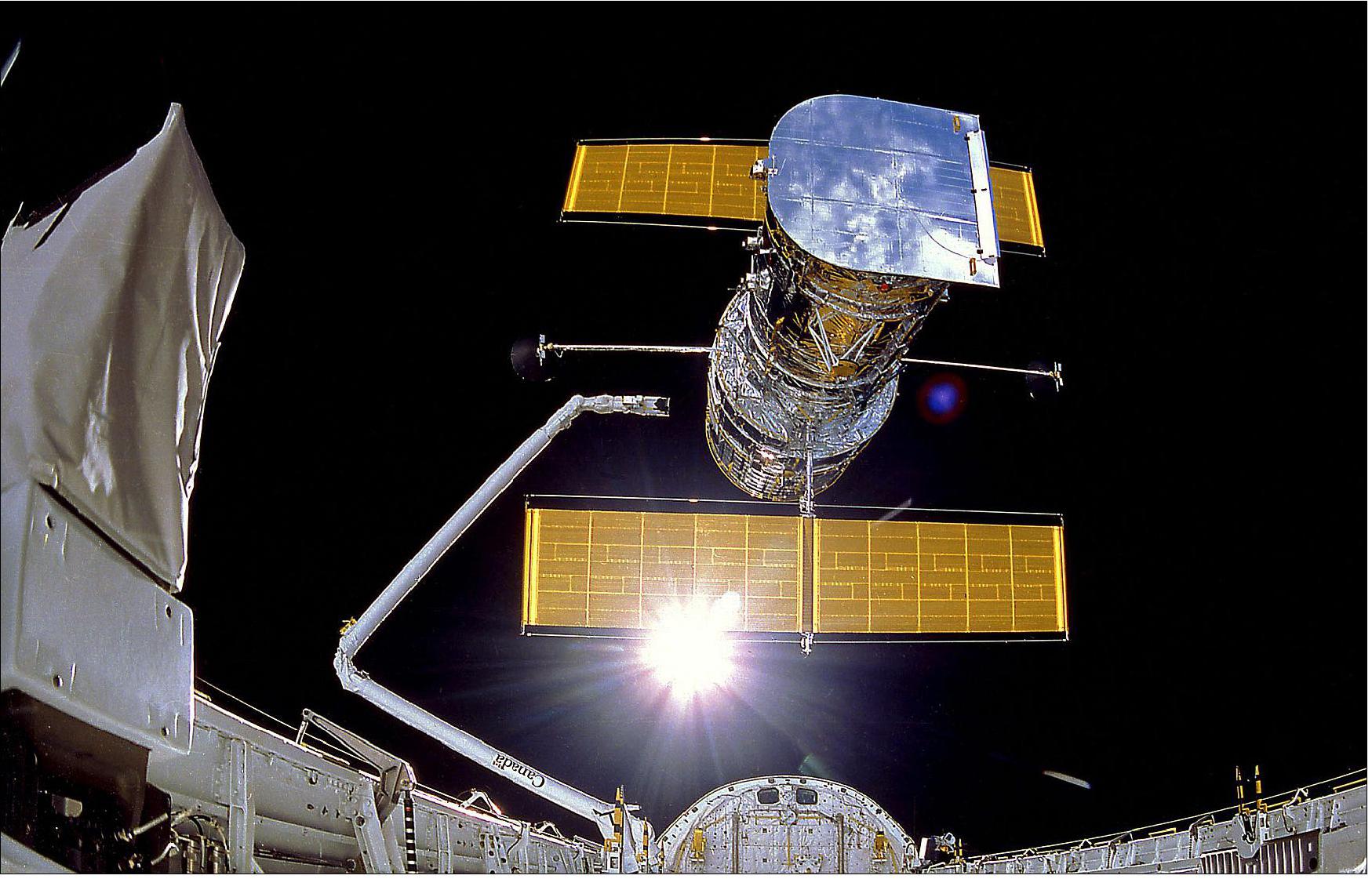
Background
The telescope's original equipment package included the Wide Field/Planetary Camera (WF/PC), Goddard High Resolution Spectograph (GHRS), Faint Object Camera (FOC), Faint Object Spectograph (FOS), and High Speed Photometer (HSP). 3) 4)
After a few weeks of operation, scientists noticed that images being sent back from Hubble were slightly blurred. While this distortion still allowed scientists to study the cosmos and make significant discoveries, it resulted in less spectacular images, and some of the original mission could not be fulfilled. An investigation finally revealed a spherical aberration in the primary mirror, due to a miscalibrated measuring instrument that caused the edges of the mirror to be ground slightly too flat. Engineers rushed to come up with a fix to the problem in time for Hubble's first scheduled servicing mission in 1993. The system designed to correct the error was designated COSTAR (Corrective Optics Space Telescope Axial Replacement). COSTAR was a set of optics that compensated for the aberration and would allow all of Hubble's instruments to function normally.
In December, 1993, the crew of STS-61 embarked on a service mission to replace a number of Hubble's parts. Following intensive training on the use of new tools never used before in space, two teams of astronauts completed repairs during a record five back-to-back spacewalks. During the EVAs, COSTAR was installed and the Wide Field/Planetary Camera was replaced with the Wide Field/Planetary Camera 2, which was designed to compensate for the mirror problem. The team also performed basic maintenance on the craft, installed new solar arrays, and replaced four of Hubble's gyroscopes.
Shortly after the crew returned to Earth and the Hubble Space Telescope began returning sharp and spectacular images, NASA deemed the servicing mission a success. Astronomers could now take advantage of a fully functional space telescope, and the public was treated to breathtaking photos of stars, galaxies, nebulae, and other deep-space objects. Subsequent servicing missions improved Hubble's capabilities and performed routine repairs.
In February, 1997, the crew of STS-82 installed the Near Infrared Camera and Multi-Object Spectrometer (NICMOS) and the Space Telescope Imaging Spectograph (STIS) to detect infrared light from deep-space objects and take detailed photos of celestial objects. Servicing mission 3A in December, 1999 replaced all six of the telescope's aging gyroscopes, which accurately point the telescope at its target. STS-103 astronauts also replaced one of the telescope's three fine guidance sensors and installed a new computer, all in time to redeploy Hubble into orbit on Christmas Day. The most recent servicing mission to the spacecraft, servicing mission 3B, came aboard STS-109 in March, 2002. Columbia crewmembers installed the new Advanced Camera for Surveys (ACS), which had sharper vision, a wider field of view, and quicker data gathering than the Wide Field/Planetary Camera 2. Astronauts also replaced Hubble's solar panels with a more efficient array and conducted repairs on the NICMOS.
STS109-E-5700 (9 March 2002) — The Hubble Space Telescope, sporting new solar arrays and other important but less visible new hardware, begins its separation from the Space Shuttle Columbia. The STS-109 crew deployed the giant telescope at 4:04 a.m. CST (1004 GMT), March 9, 2002. Afterward, the seven crew members began to focus their attention to the trip home, scheduled for March 12. The STS-109 astronauts conducted five space walks to service and upgrade Hubble. 5)
The power for the NASA/ESA Hubble Space Telescope's scientific discoveries comes from solar cells. Designing and constructing Hubble's first two sets of solar cell arrays, and the accompanying Solar Array Drive Mechanism (SADM) and Solar Array Drive Electronics (SADE), constituted a huge technological achievement for the European Space Agency (ESA) and European industry. After an in-orbit life of more than 10 years, the ESA-built solar arrays were replaced by new, more powerful arrays. However, ESA’s SADM and SADE, which control the telescope’s current solar arrays, are still on board and under ESA purview. They are among the telescope’s oldest subsystems. 6)
In December 2019, the accumulated slew angles of the SADM had reached 1,000,000 degrees of travel. This travel began accumulating on this day 18 years ago, 5 March 2002, when ESA’s solar arrays were replaced during the Space Shuttle Servicing Mission 3B.
“This milestone is a special occasion to recognize that after all of these years of operation, the SADM and SADE are still functioning perfectly without any sign of degradation. It's a fantastic achievement,” said Lothar Gerlach, former ESA project manager for the European hardware onboard the Hubble Space Telescope. “The SADM and SADE have greatly exceeded their design life, and we are very proud they are still a key part of Hubble scientific operations”.
Notes: The Hubble Space Telescope is a project of international co-operation between ESA and NASA. The ESA Hubble Space Telescope solar arrays have been provided to the European Space Agency by Astrium (UK/Germany — formerly British Aerospace, United Kingdom, AEG/Telefunken and Dornier — now Airbus, Germany), and Oerlikon Contraves Space (Switzerland).
Europe & Hubble 7)
ESA’s contribution to the Hubble Project guarantees European scientists access to 15% of Hubble observing time. Hubble time is allocated on scientific merit by an international panel that includes European experts. Over Hubble’s lifetime, European astronomers have, in open competition, been allocated more than the guaranteed 15%, and in some years the proportion has been closer to 25%.
Europe also provided one of the scientific instruments Hubble was launched with, designed Hubble’s solar panels, and has provided astronauts to participate in servicing missions.
Scientists from most ESA Member States have had an opportunity to observe with Hubble. To date, almost 800 observing programs with European principal investigators (lead scientists) have been carried out or are scheduled to be in the next observing round, with many others involved as co-investigators.

The success of a scientific mission can be measured by the number and quality of scientific papers that are published in the specialized press. The number of papers based on Hubble observations published each year has been increasing continuously since the telescope’s launch. There is at least one European author or co-author on about 30% of these papers, indicating the importance of Hubble to European astronomy.
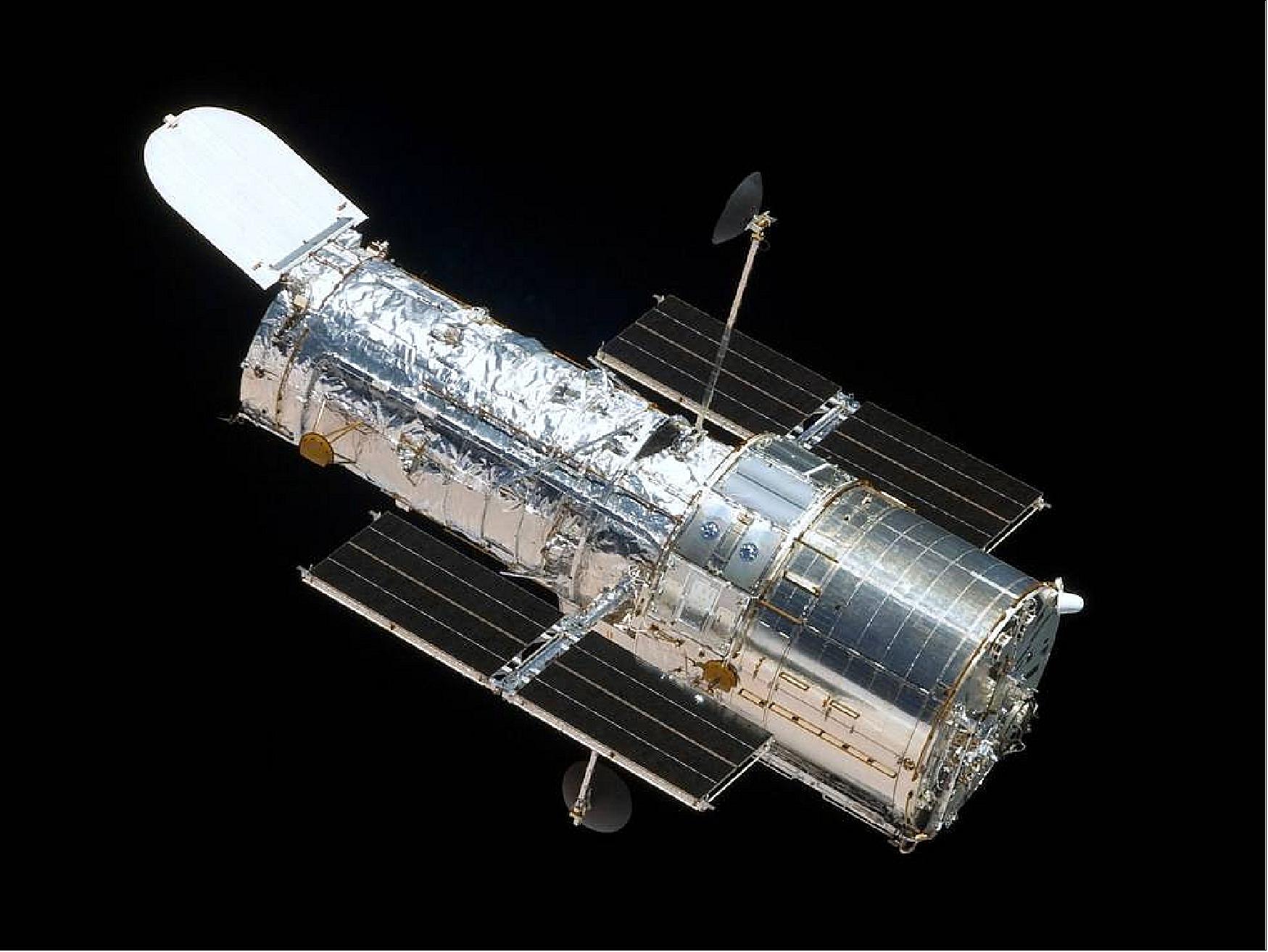
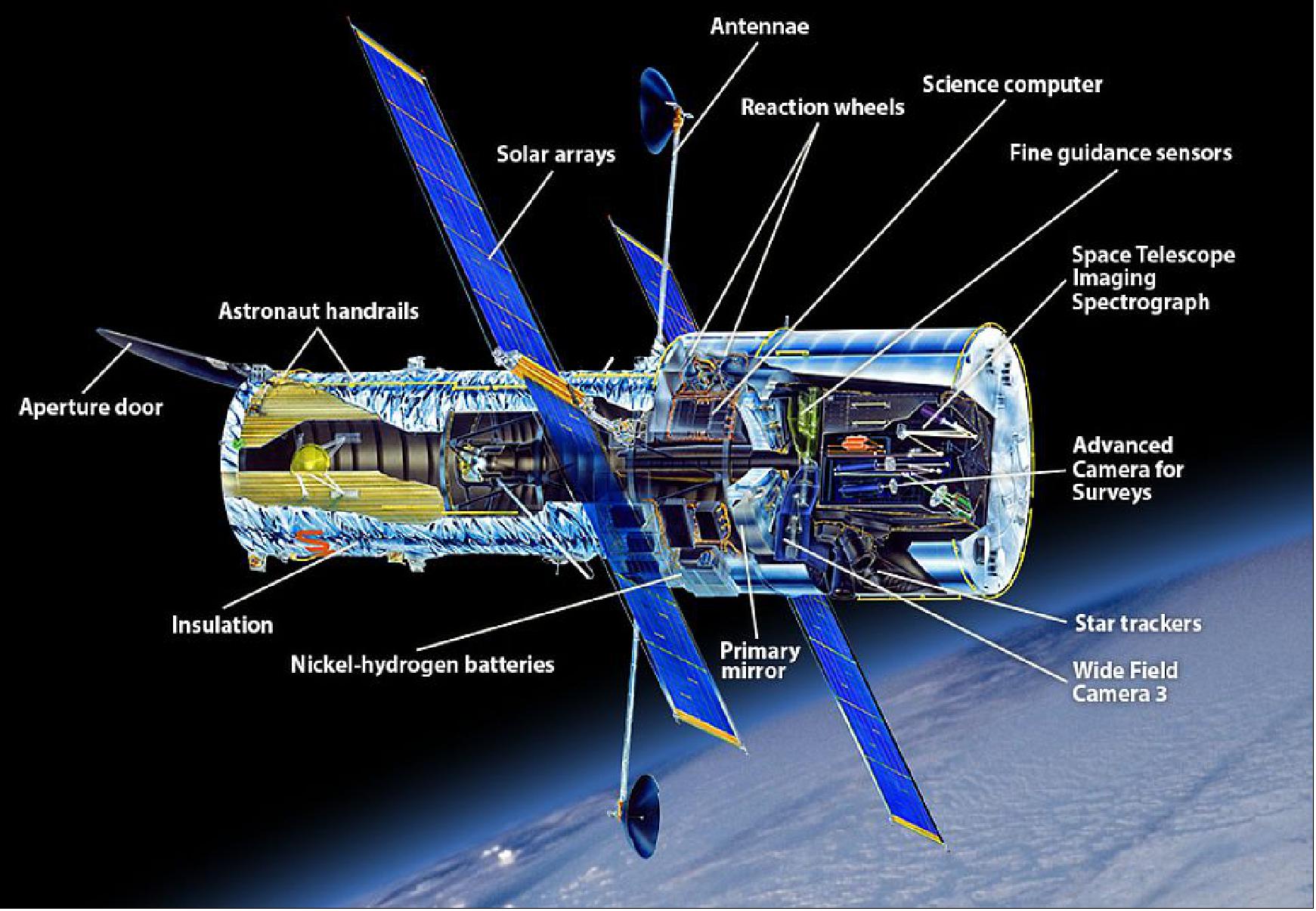
The Hubble Space Telescope is an international collaboration among NASA and ESA (European Space Agency). NASA has overall responsibility for the Hubble mission and operations. ESA provided the original FOC (Faint Object Camera) and solar panels, and provides science operations support.
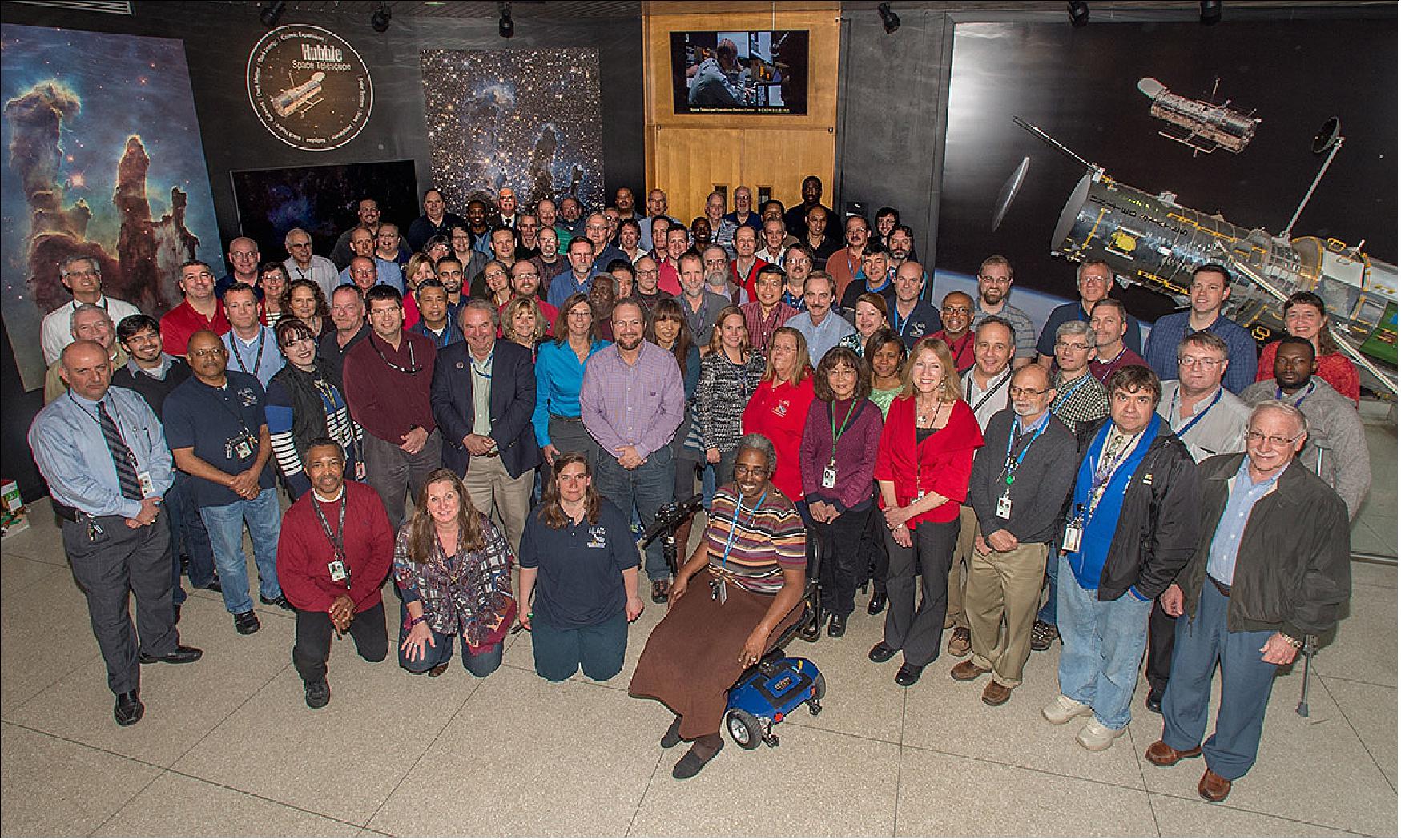
Note: At this stage of the mission (2018), no attempt is being made to recover all facets of Hubble regarding the spacecraft, instrumentation and the past history (it would have required a constant accompaniment of the mission with all updates over its lifetime). Instead, some fairly recent images of the mission and the operational status of the mission are presented.
The Hubble Servicing Missions are shortly described in a separate chapter of this file.
Sensor Complement
The Hubble Space Telescope has three types of instruments that analyze light from the universe: cameras, spectrographs and interferometers. 9)
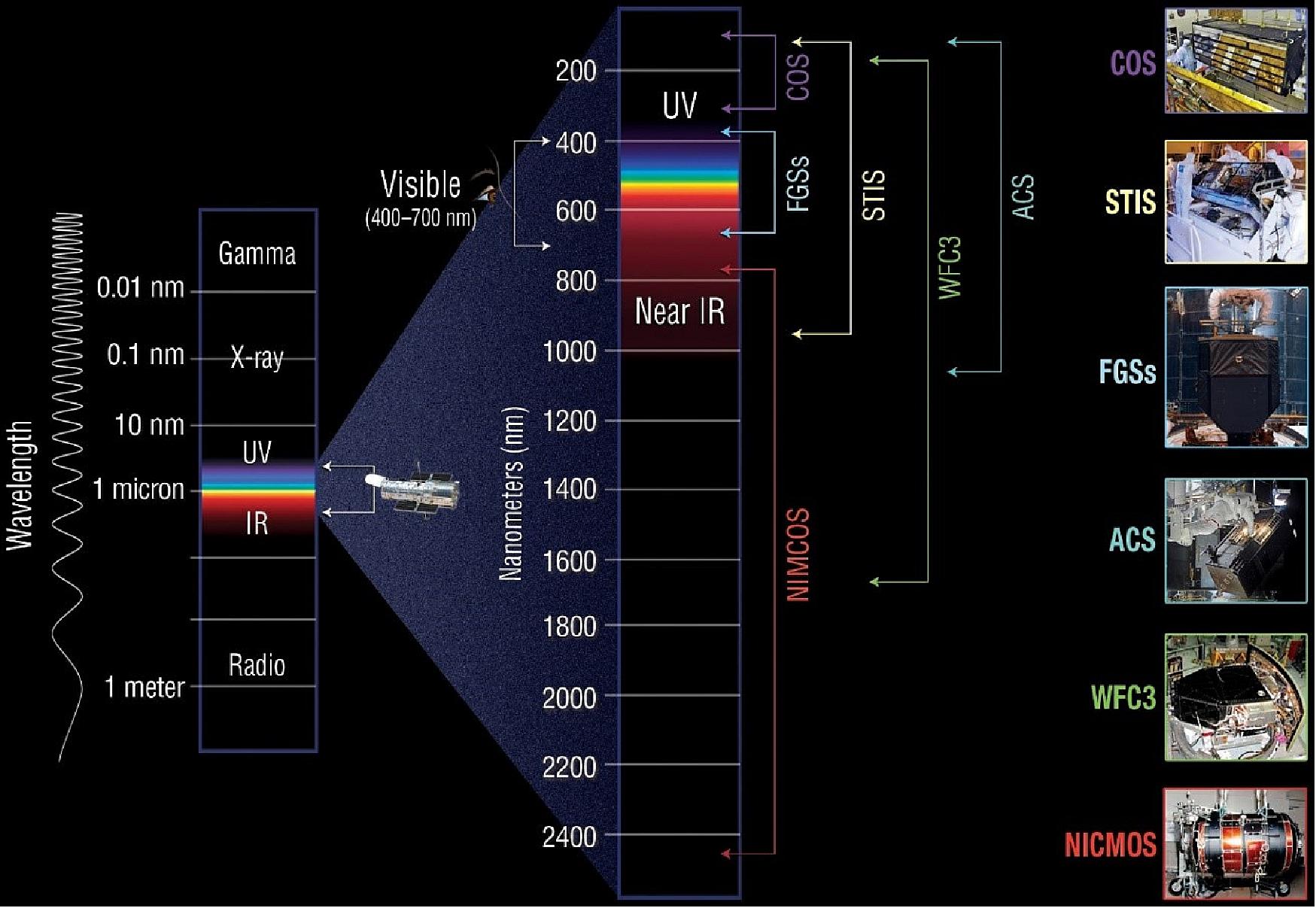
Hubble has two primary camera systems to capture images of the cosmos. Called the Advanced Camera for Surveys (ACS) and the Wide Field Camera 3 (WFC3), these two systems work together to provide superb wide-field imaging over a broad range of wavelengths.
ACS (Advanced Camera for Surveys)
Installed on Hubble in 2002, ACS was designed primarily for wide-field imagery in visible wavelengths, although it can also detect ultraviolet and near-infrared light. ACS has three cameras, called channels, that capture different types of images. An electronics failure in January 2007 rendered the two most-used science channels inoperable. In 2009, astronauts were able to repair one of the channels and restored ACS’s capacity to capture high-resolution, wide-field views.
WFC3 (Wide Field Camera 3)
Installed in 2009, WFC3 provides wide-field imagery in ultraviolet, visible and infrared light. WFC3 was designed to complement ACS and expand the imaging capabilities of Hubble in general. While ACS is primarily used for visible-light imaging, WFC3 probes deeper into infrared and ultraviolet wavelengths, providing a more complete view of the cosmos.
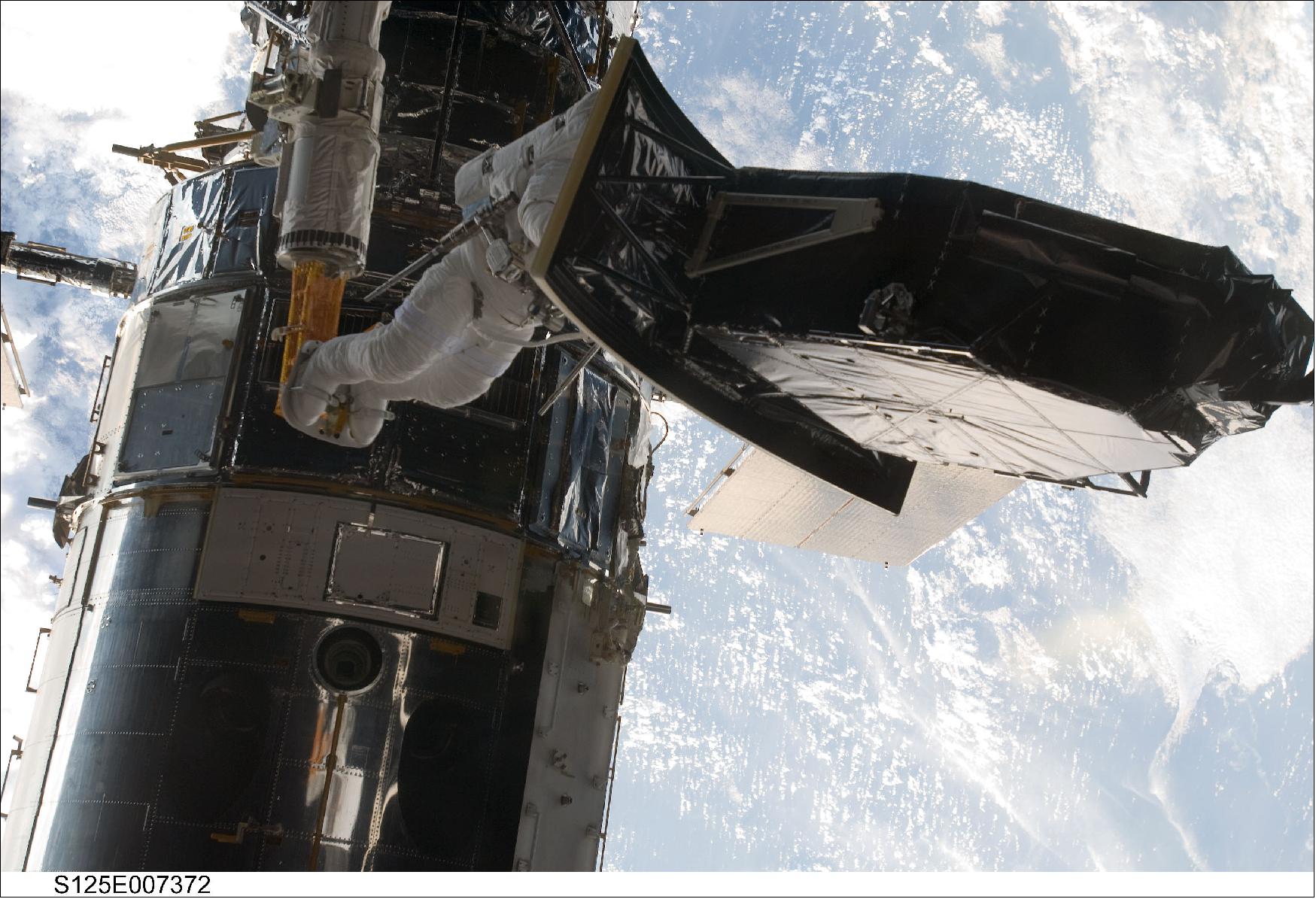
Spectrographs
Spectrographs practice spectroscopy, the science of breaking light down to its component parts, similar to how a prism splits white light into a rainbow. Any object that absorbs or emits light can be studied with a spectrograph to determine characteristics such as temperature, density, chemical composition and velocity.
Hubble currently utilizes two spectrographs: COS (Cosmic Origins Spectrograph) and the STIS (Space Telescope Imaging Spectrograph). COS and STIS are complementary instruments that provide scientists with detailed spectral data for a variety of celestial objects. While STIS is a versatile, “all purpose” spectrograph that handles bright objects well, COS measures exceedingly faint levels of ultraviolet light emanating from distant cosmic sources, such as quasars in remote galaxies. Working together, the two spectrographs provide a full set of spectroscopic tools for astrophysical research.
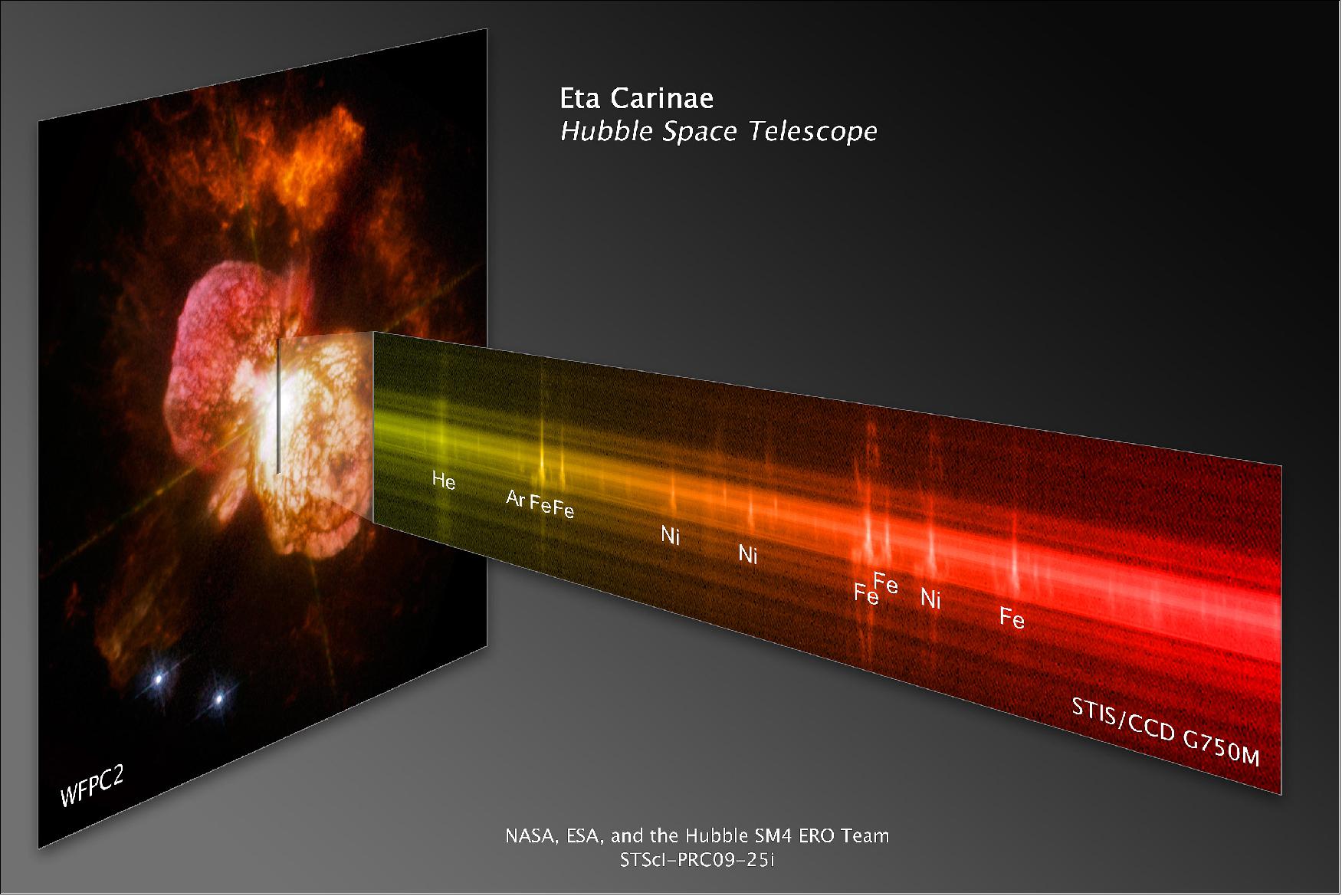
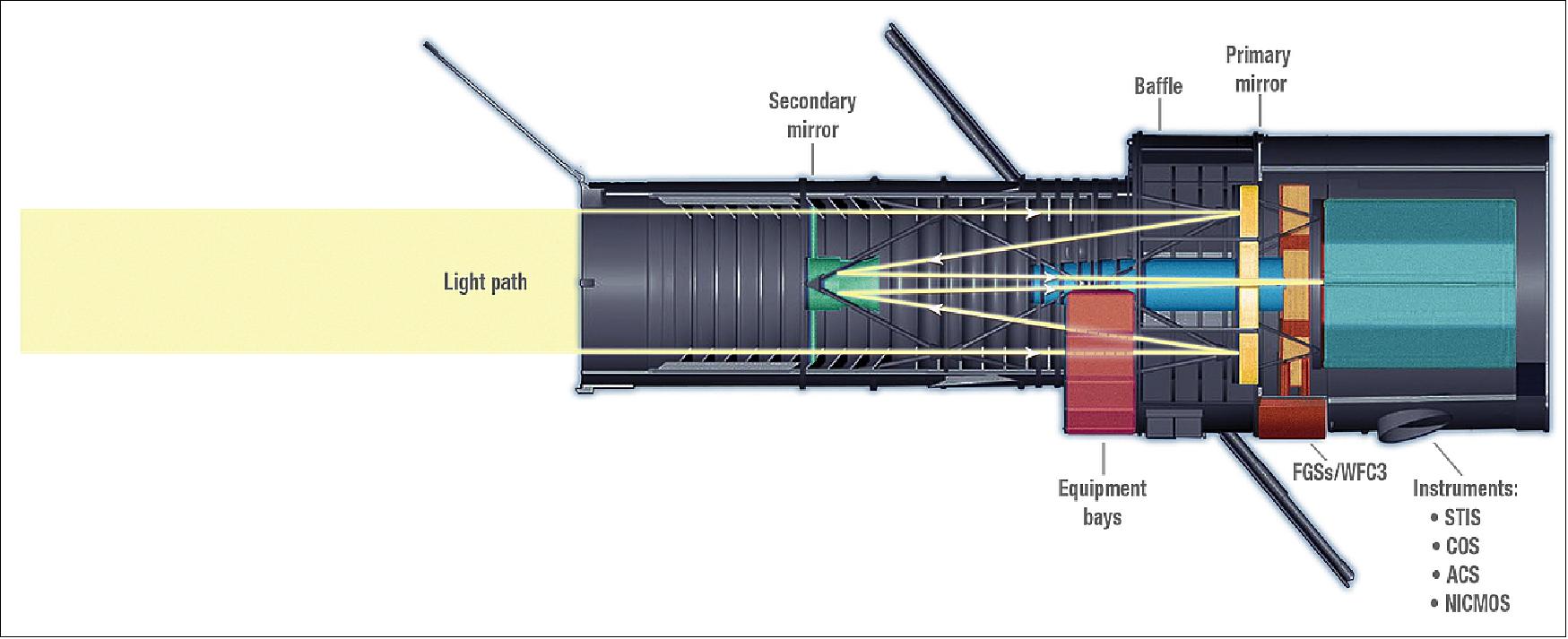
Interferometers
Hubble’s interferometers serve a dual purpose — they help the telescope maintain a steady aim and also serve as a scientific instrument. The three interferometers aboard Hubble are called the FGS (Fine Guidance Sensors). The Fine Guidance Sensors measure the relative positions and brightnesses of stars.
When Hubble is pointing at a target, two of the three Fine Guidance Sensors are used to lock the telescope onto the target. For certain observations, the third Fine Guidance Sensor can be used to gather scientific information about a target, such as a celestial object’s angular diameter or star positions that are ten times more accurate than those obtained by ground-based telescopes.
The Fine Guidance Sensors are very sensitive instruments. They seek out stable point sources of light (known as “guide stars”) and then lock onto them to keep the telescope pointing steadily. When a light in the sky is not a point source, the Fine Guidance Sensor cannot lock on and so it rejects the guide star. Often, a rejected guide star is actually a faraway galaxy or a double-star system. Since Hubble was launched in 1990, the Fine Guidance Sensors have detected hundreds of double-star systems that were previously thought to be single stars.
Past Instruments
Only one of the instruments remaining on Hubble — the third Fine Guidance Sensor — was launched with the observatory in 1990. The rest of the instruments were installed during Hubble’s five servicing missions. In addition to installing new instruments, astronauts also repaired two instruments (ACS and STIS) while visiting Hubble on Servicing Mission 4 in 2009. The NICMOS (Near-Infrared Camera and Multi-Object Spectrometer) on Hubble is in hibernation following a cryocooler anomaly, but most of its infrared duties have since been taken over by WFC3.
Hubble’s past instruments include:
• High Speed Photometer
• Faint Object Camera (FOC), provided by ESA
• Faint Object Spectrograph
• Goddard High Resolution Spectrograph
• Wide Field and Planetary Camera
• Wide Field and Planetary Camera 2
• Fine Guidance Sensors (three).
Current Instruments
ACS (Advanced Camera for Surveys) - ACS is a third-generation imaging camera. This camera is optimized to perform surveys or broad imaging campaigns. ACS replaced Hubble's Faint Object Camera (FOC) during Servicing Mission 3B. Its wavelength range extends from the ultraviolet, through the visible and out to the near-infrared (115-1050 nm). ACS has increased Hubble's potential for new discoveries by a factor of ten.
COS (Cosmic Origins Spectrograph) - COS focuses exclusively on ultraviolet (UV) light and is the most sensitive ultraviolet spectrograph ever, increasing the sensitivity at least 10 times in the UV spectrum and up to 70 times when looking at extremely faint objects. It is best at observing points of light, like stars and quasars. COS was installed during during Servicing Mission 4 in May 2009.
STIS (Space Telescope Imaging Spectrograph) - STIS is a second-generation imager/spectrograph. STIS is used to obtain high resolution spectra of resolved objects. STIS has the special ability to simultaneously obtain spectra from many different points along a target. The STIS instrument has a mass of 318 kg and a wavelength range of 115-1000 nm.
STIS spreads out the light gathered by a telescope so that it can be analyzed to determine such properties of celestial objects as chemical composition and abundances, temperature, radial velocity, rotational velocity, and magnetic fields. Its spectrograph can be switched between two different modes of usage:
C So-called "long slit spectroscopy" where spectra of many different points across an object are obtained simultaneously.
1) So-called "echelle spectroscopy" where the spectrum of one object is spread over the detector giving better wavelength resolution in a single exposure.
STIS also has a so-called coronagraph which can block light from bright objects, and in this way enables investigations of nearby fainter objects.
WFC3 (Wide Field Camera 3) - Wide Field Camera 3 is the main imager on the telescope. It has a camera that records visible and ultraviolet (UVIS, 200-1000 nm) wavelengths of light and is 35 times more sensitive in the UV wavelengths than its predecessor. A second camera that is built to view infrared (NIR, 850-1700 nm) light increases Hubble's IR resolution from 65,000 to 1 million pixels. Its combination of field-of-view, sensitivity, and low detector noise results in a 15-20 time improvement over Hubble’s previous IR camera. WFC3 was jointly developed at GSFC, STScI (Space Telescope Science Institute) in Baltimore and Ball Aerospace & Technologies Corporation in Boulder, CO. 11)
FGS (Fine Guidance Sensor) – The FGS provides pointing information for the spacecraft by locking onto guide stars. The FGS can also function as a scientific instrument by precisely measuring the relative positions of stars, detecting rapid changes in a star’s brightness, and resolving double-star systems that appear as point sources even to Hubble’s cameras. Hubble has three FGSs onboard the observatory.
NICMOS (Near Infrared Camera and Multi-Object Spectrometer) – NICMOS has the ability to obtain images and spectroscopic observations of astronomical targets at near-infrared wavelengths. Although NICMOS is currently inactive, most of its functionality is replaced by Hubble’s other science instruments.
Note: As of 11 March 2021, the previously large Hubble file has been split into five files, to make the file handling manageable for all parties concerned, in particular for the user community.
• This article covers the Hubble mission and its imagery in the period 2022, in addition to some of the mission milestones.
Mission Status
• July 22, 2022: This intriguing observation from the NASA/ESA Hubble Space Telescope shows a gravitationally lensed galaxy with the long-winded identification SGAS J143845+145407. Gravitational lensing has resulted in a mirror image of the galaxy at the centre of this image, creating a captivating centrepiece. 12)
- Gravitational lensing occurs when a massive celestial body — such as a galaxy cluster — causes a sufficient curvature of spacetime for the path of light around it to be visibly bent, as if by a lens. Appropriately, the body causing the light to curve is called a gravitational lens, and the distorted background object is referred to as being "lensed". Gravitational lensing can result in multiple images of the original galaxy, as seen in this image, or in the background object appearing as a distorted arc or even a ring. Another important consequence of this lensing distortion is magnification, allowing astronomers to observe objects that would otherwise be too far away or too faint to be seen.
- Hubble has a special flair for detecting lensed galaxies. The telescope's sensitivity and crystal-clear vision allow it to see faint and distant gravitational lenses that cannot be detected with ground-based telescopes because of the blurring effect of Earth's atmosphere. Hubble was the first telescope to resolve details within lensed images of galaxies, and is capable of imaging both their shape and internal structure.
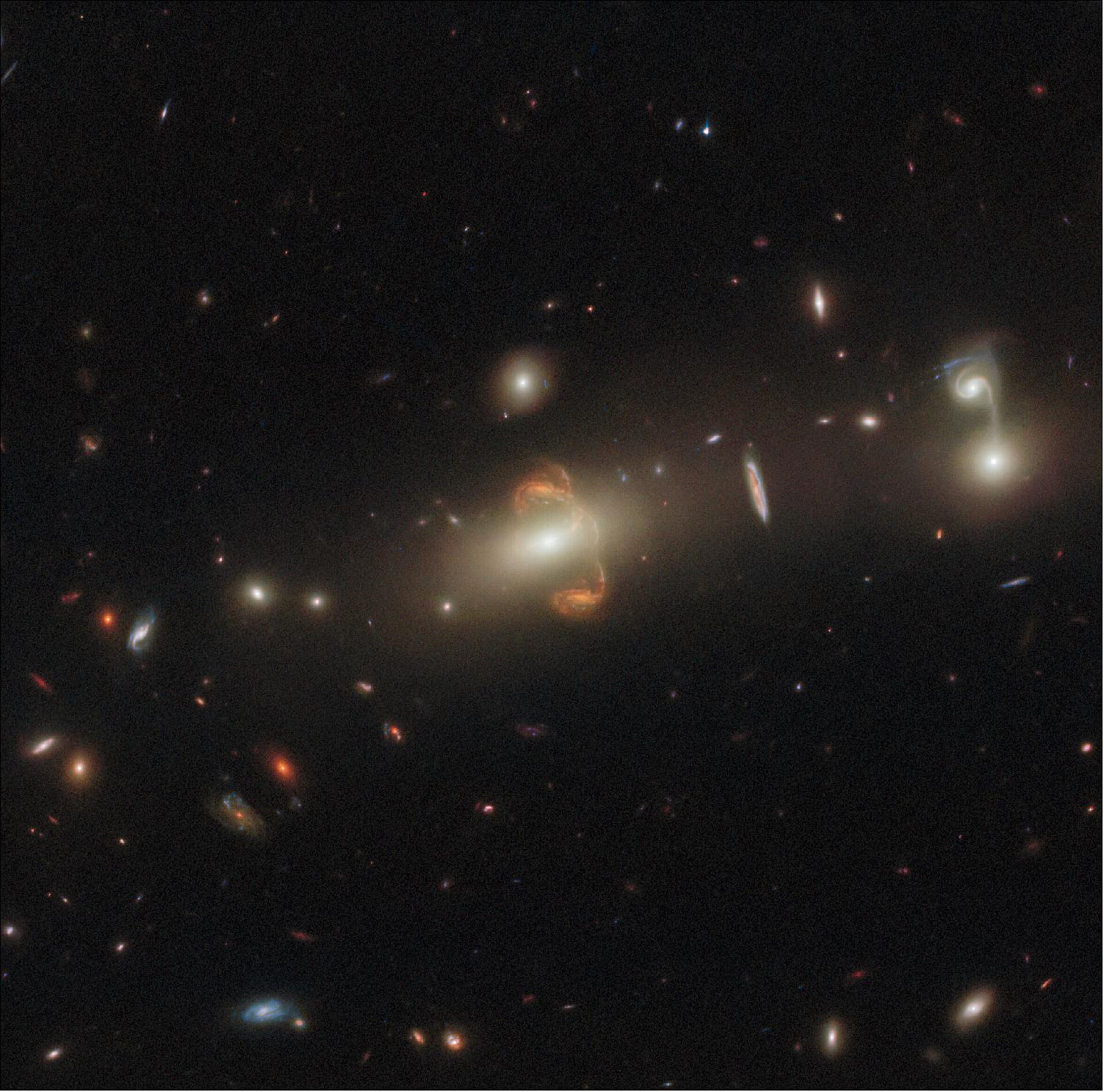
• July 15, 2022: The globular cluster Terzan 2 in the constellation Scorpio features in this observation from the NASA/ESA Hubble Space Telescope. Globular clusters are stable, tightly gravitationally bound clusters of tens of thousands to millions of stars found in a wide variety of galaxies. The intense gravitational attraction between the closely packed stars gives globular clusters a regular, spherical shape. As a result, images of the hearts of globular clusters, such as this observation of Terzan 2, are crowded with a multitude of glittering stars. 13)
- Each of the four operational instruments on Hubble is a masterpiece of astronomical engineering in its own right, and contains an intricate array of mirrors and other optical elements to remove any aberrations or optical imperfections from observations, as well as filters which allow astronomers to observe specific wavelength ranges. The mirrors inside each instrument also correct for the slight imperfection of Hubble's primary mirror. The end result is a crystal-clear observation, such as this glittering portrait of Terzan 2.
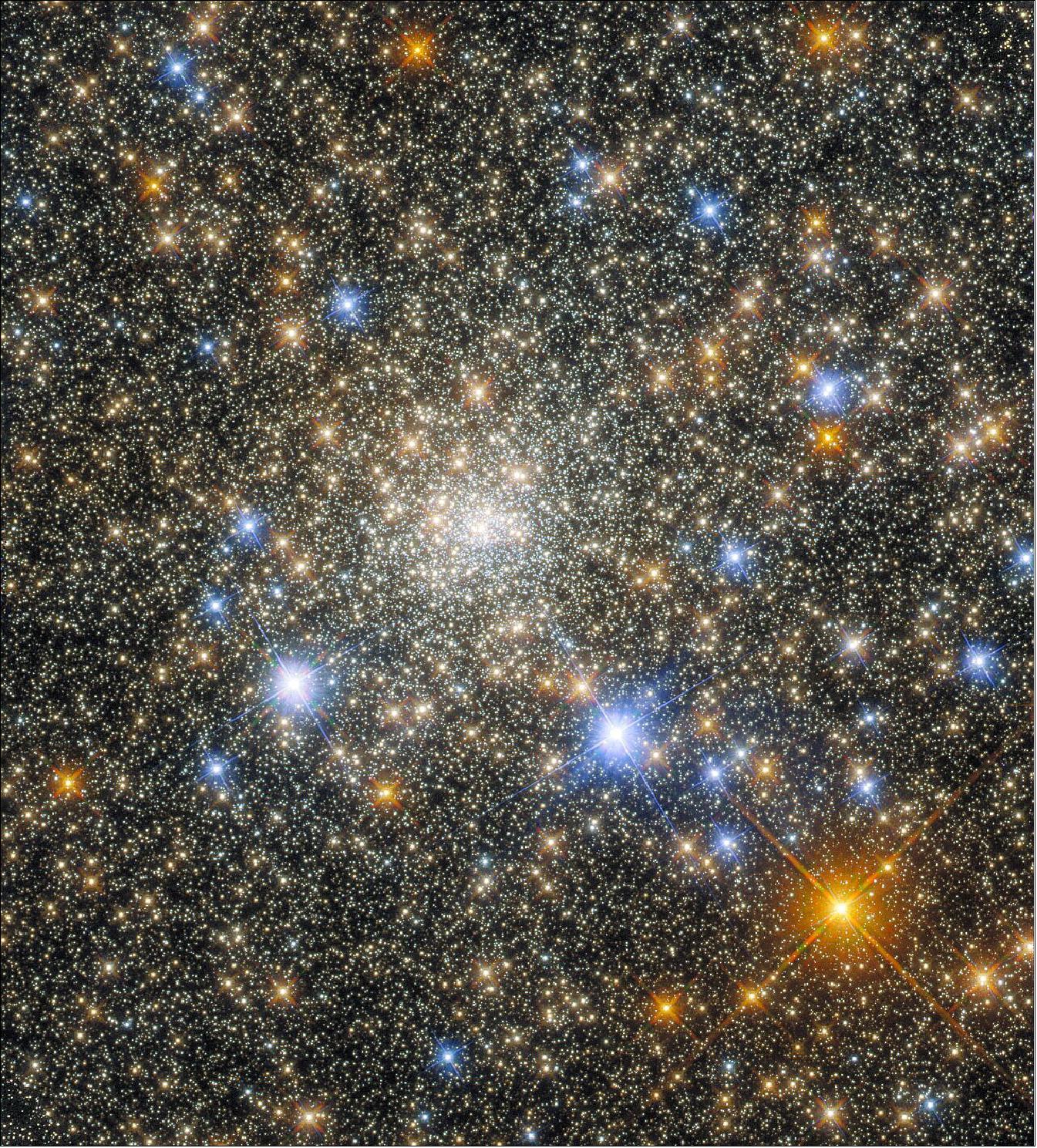
• July 8, 2022: This NASA/ESA Hubble Space Telescope observation has captured the galaxy CGCG 396-2, an unusual multi-armed galaxy merger which lies around 520 million light-years from Earth in the constellation Orion.14)
- The Galaxy Zoo project originated when an astronomer was set an impossibly mind-numbing task; classifying more than 900,000 galaxies by eye. By making a web interface and inviting citizen scientists to contribute to the challenge, the Galaxy Zoo team was able to crowdsource the analysis, and within six months a legion of 100 000 volunteer citizen astronomers had contributed more than 40 million galaxy classifications.
- Since its initial success, the Galaxy Zoo project and its successor projects have contributed to more than 100 peer-reviewed scientific articles and led to a rich variety of intriguing astronomical discoveries above and beyond their initial goals. The success of the project also inspired more than 100 citizen science projects on the Zooniverse portal, ranging from analysing data from the ESA Rosetta spacecraft's visit to Comet 67P/Churyumov–Gerasimenko to counting killer whales around remote Alaskan islands!
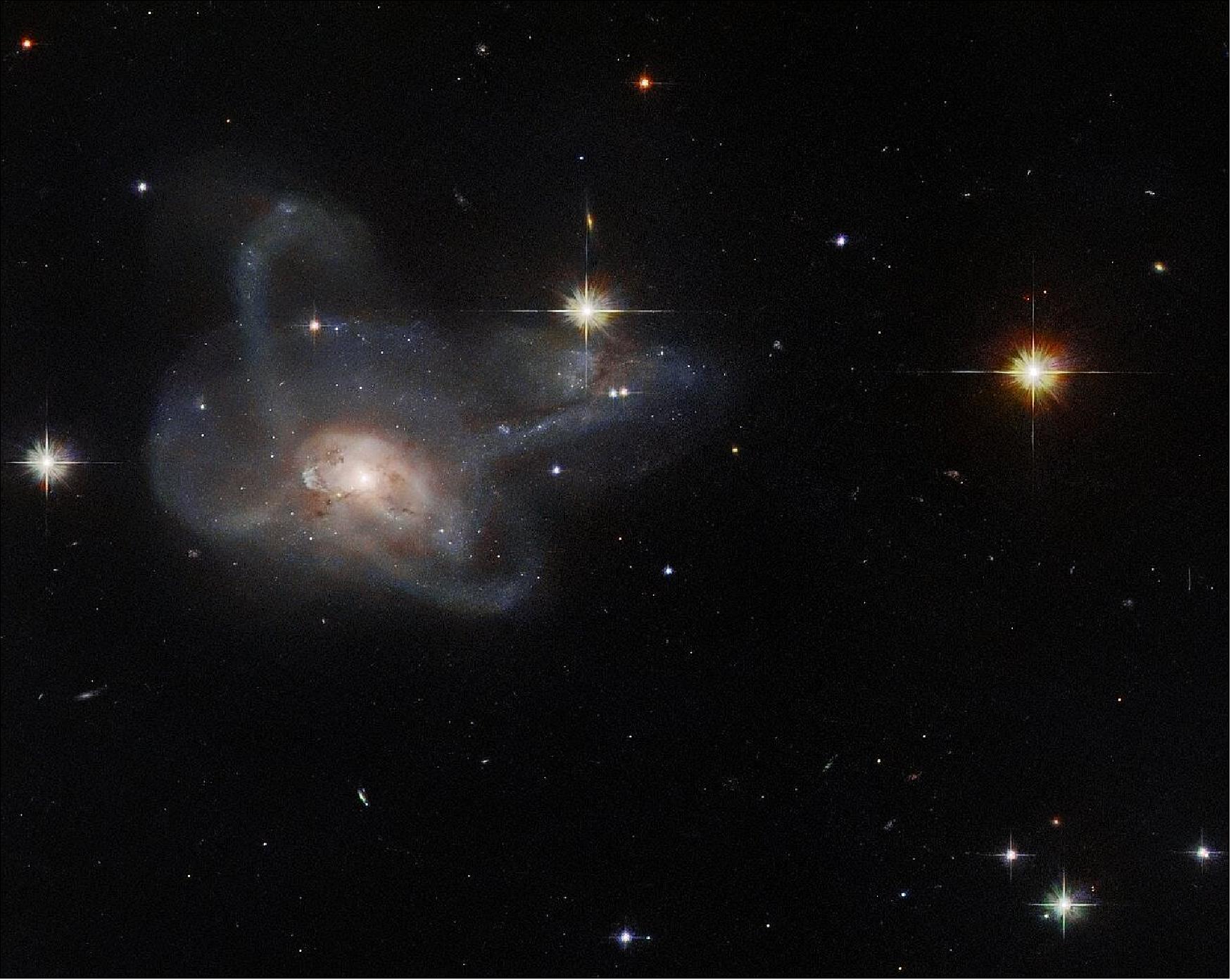
• July 01, 2022: This image from the NASA/ESA Hubble Space Telescope captures the sparkling globular cluster NGC 6569 in the constellation Sagittarius. Hubble explored the heart of this cluster with both its Wide Field Camera 3 and Advanced Camera for Surveys, revealing a glittering hoard of stars in this astronomical treasure trove. 15)
- Globular clusters are stable, tightly bound clusters containing tens of thousands to millions of stars, and are associated with all types of galaxies. The intense gravitational attraction of these closely packed clusters of stars means that globular clusters have a regular spherical shape with a densely populated centre — as can be seen in the heart of this star-studded image.
- This observation comes from an investigation of globular clusters which lie close to the centre of the Milky Way. These objects have been avoided in previous surveys, as the dust spread throughout the centre of our galaxy blocks light from these globular clusters and alters the colours of the stars residing in them. The last factor is particularly important for astronomers studying stellar evolution, as the colours of stars can give astronomers insights into their ages, compositions, and temperatures.
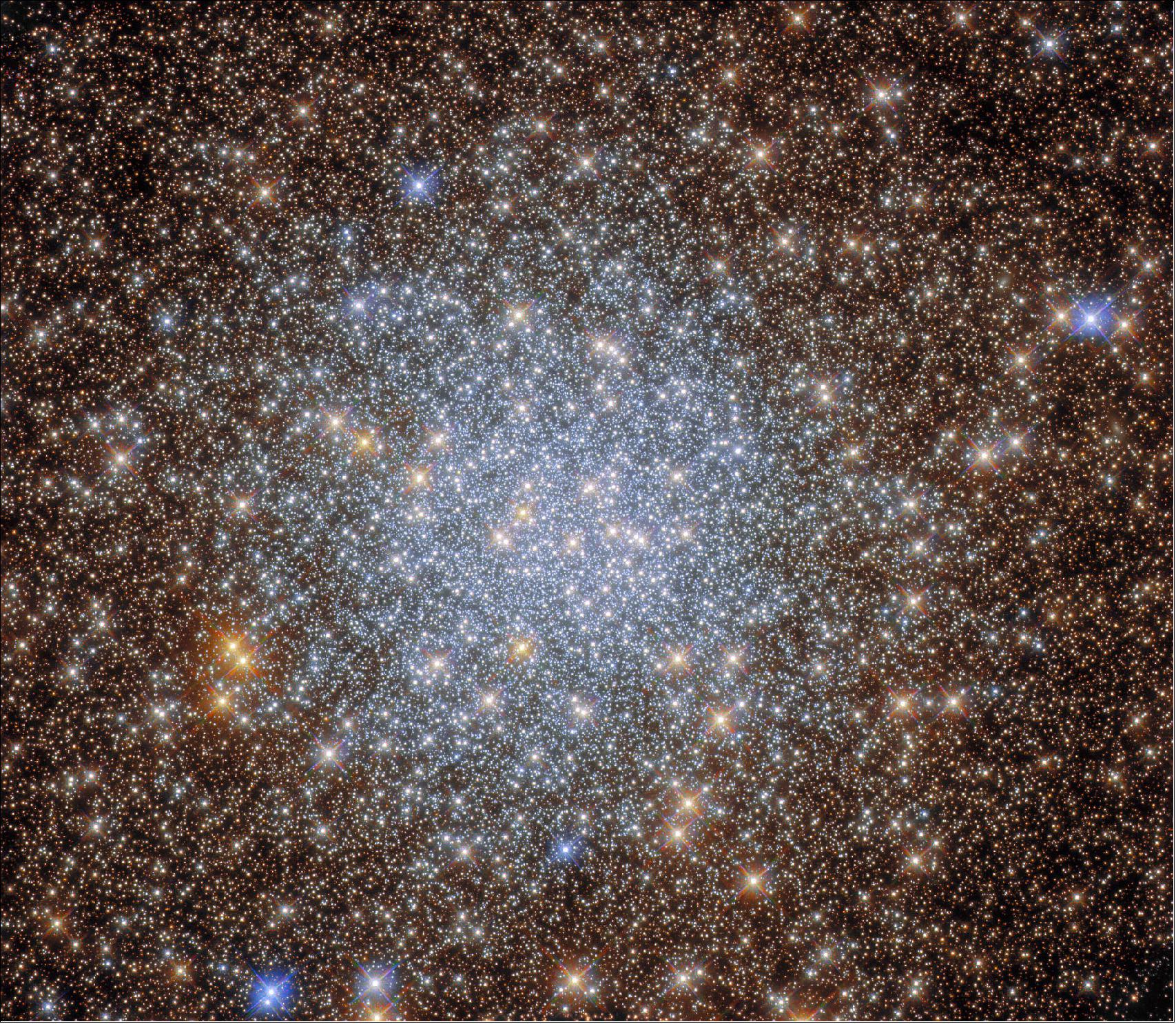
• June 23, 2022: The massive galaxy cluster Abell 1351 is captured in this image by the NASA/ESA Hubble Space Telescope’s Wide Field Camera 3 and Advanced Camera for Surveys. This galaxy cluster lies in the constellation Ursa Major in the northern hemisphere. 16)
- This observation is part of an astronomical album comprising snapshots of some of the most massive galaxy clusters. This menagerie of massive clusters demonstrates interesting astrophysical phenomena such as strong gravitational lensing, as well as showcasing spectacular examples of violent galaxy evolution. To obtain this astronomical album, astronomers proposed a Snapshot Program to be slotted into Hubble’s packed observing schedule. These Snapshot Programs are lists of separate, relatively short exposures which can fit into gaps between longer Hubble observations. Having a large pool of Snapshot candidates to dip into allows Hubble to use every second of observing time possible and to maximise the scientific output of the observatory.
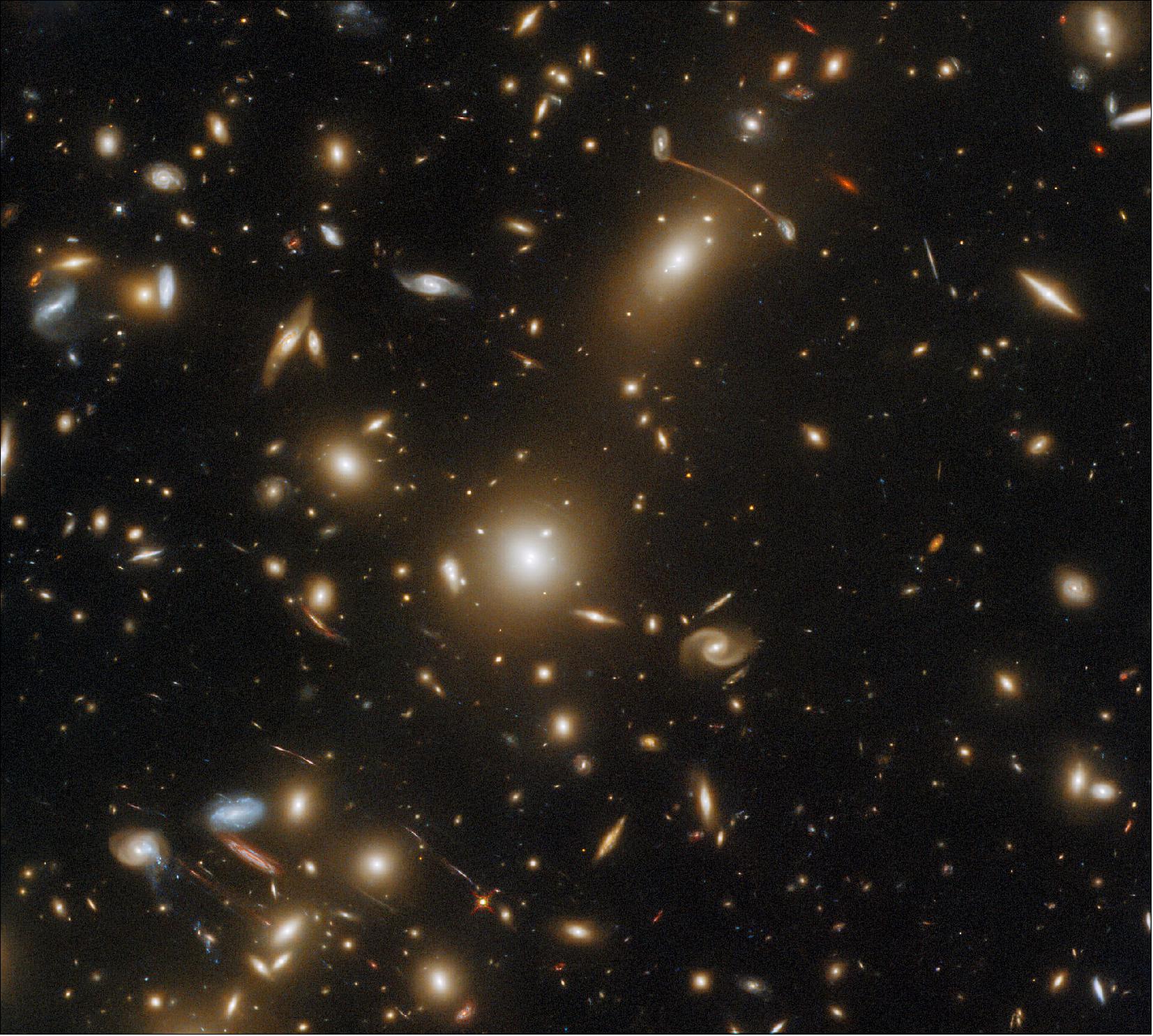
• June 17, 2022: This star-studded image shows the globular cluster Terzan 9 in the constellation Sagittarius, towards the centre of the Milky Way. The NASA/ESA Hubble Space Telescope captured this glittering scene using its Wide Field Camera 3 and Advanced Camera for Surveys. 17)
- Globular clusters are stable, tightly bound groupings of tens of thousands to millions of stars. As this image demonstrates, the hearts of globular clusters can be densely packed with stars; the night sky in this image is strewn with so many stars that it resembles a sea of sequins or a vast treasure chest crammed with gold.
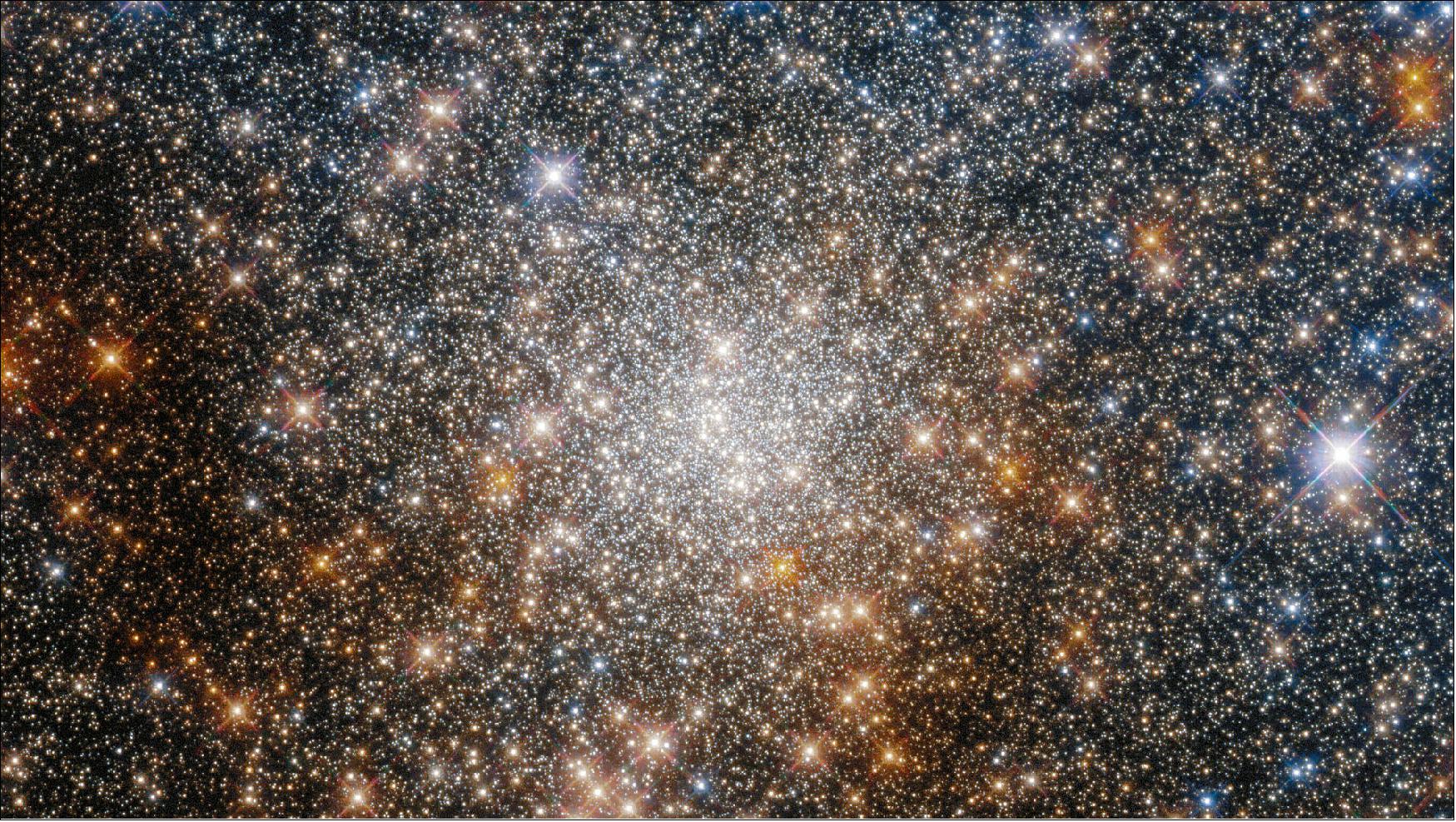
• June 16, 2022: New images using data from European Space Agency (ESA) and NASA missions showcase the gas and dust that fill the space between stars in four of the galaxies closest to our own Milky Way. More than striking, the snapshots are also a scientific trove, lending insight into how dramatically the density of dust clouds can vary within a galaxy. 18)
- With a consistency similar to smoke, dust is created by dying stars and is one of the materials that forms new stars. The dust clouds observed by space telescopes are constantly shaped and molded by exploding stars, stellar winds, and the effects of gravity. Almost half of all the starlight in the universe is absorbed by dust. Many of the heavy chemical elements essential to forming planets like Earth are locked up in dust grains in interstellar space. Understanding dust is an essential part of understanding our universe.
- The observations were made possible through the work of ESA’s Herschel Space Observatory, which operated from 2009 to 2013. Herschel’s super-cold instruments were able to detect the thermal glow of dust, which is emitted as far-infrared light, a range of wavelengths longer than what human eyes can detect.
- Herschel’s images of interstellar dust provide high-resolution views of fine details in these clouds, revealing intricate substructures. But the way the space telescope was designed meant that it often couldn’t detect light from clouds that are more spread out and diffuse, especially in the outer regions of galaxies, where the gas and dust become sparse and thus fainter. For some nearby galaxies, that meant Herschel missed up to 30% of all the light given off by dust. With such a significant gap, astronomers struggled to use the Herschel data to understand how dust and gas behaved in these environments. To fill out the Herschel dust maps, the new images combine data from three other missions: ESA’s retired Planck observatory, along with two retired NASA missions, the Infrared Astronomical Satellite (IRAS) and Cosmic Background Explorer (COBE).
- The images show the Andromeda galaxy, also known as M31; the Triangulum galaxy, or M33; and the Large and Small Magellanic Clouds – dwarf galaxies orbiting the Milky Way that do not have the spiral structure of the Andromeda and Triangulum galaxies. All four are within 3 million light-years of Earth.
![Figure 17: The Large Magellanic Cloud (LMC) is a satellite of the Milky Way, containing about 30 billion stars. Seen here in a far-infrared and radio view, the LMC’s cool and warm dust are shown in green and blue, respectively, with hydrogen gas in red. The image is composed of data from the European Space Agency (ESA) Herschel Space Observatory (HSO), supplemented with data from ESA’s retired Planck observatory and two retired NASA missions: the Infrared Astronomy Survey and Cosmic Background Explorer, as well as the Parkes, ATCA, and Mopra radio telescopes [image credits: ESA, NASA, NASA-JPL, Caltech, Christopher Clark (STScI), S. Kim (Sejong University), T. Wong (UIUC)]](https://www.eoportal.org/ftp/satellite-missions/h/Hubble_220722/Hubble_Auto42.jpeg)
![Figure 18: The Andromeda galaxy, or M31, is shown here in far-infrared and radio wavelengths of light. Some of the hydrogen gas (red) that traces the edge of Andromeda’s disc was pulled in from intergalactic space, and some was torn away from galaxies that merged with Andromeda far in the past. The image is composed of data from the European Space Agency (ESA) Herschel mission, supplemented with data from ESA’s retired Planck observatory and two retired NASA missions: the Infrared Astronomy Survey and Cosmic Background Explorer, as well as the Green Bank Telescope, WRST, and IRAM radio telescopes[image credits: ESA, NASA, NASA-JPL, Caltech, Christopher Clark (STScI), R. Braun (SKA Observatory), C. Nieten (MPI Radioastronomie), Matt Smith (Cardiff University)]](https://www.eoportal.org/ftp/satellite-missions/h/Hubble_220722/Hubble_Auto41.jpeg)
![Figure 19: The Small Magellanic Cloud is a satellite of the Milky Way, containing about 3 billion stars. This far-infrared and radio view of it shows the cool (green) and warm (blue) dust, as well as the hydrogen gas (red). The image is composed of data from the European Space Agency (ESA) Herschel mission, supplemented with data from ESA’s retired Planck observatory and two retired NASA missions: the Infrared Astronomy Survey and Cosmic Background Explorer, as well as the Parkes, ATCA, and NANTEN radio telescopes [image credits: ESA, NASA, NASA-JPL, Caltech, Christopher Clark (STScI), S. Stanimirovic (UW-Madison), N. Mizuno (Nagoya University)]](https://www.eoportal.org/ftp/satellite-missions/h/Hubble_220722/Hubble_Auto40.jpeg)
![Figure 20: The Triangulum galaxy, or M33, is shown here in far-infrared and radio wavelengths of light. Some of the hydrogen gas (red) that traces the edge of the Triangulum’s disc was pulled in from intergalactic space, and some was torn away from galaxies that merged with Triangulum far in the past. The image is composed of data from the European Space Agency (ESA) Herschel mission, supplemented with data from ESA’s retired Planck observatory and two retired NASA missions: the Infrared Astronomy Survey and Cosmic Background Explorer, as well as the Very Large Array, Green Bank Telescope, and IRAM radio telescope [image credits: ESA, NASA, NASA-JPL, Caltech, Christopher Clark (STScI), E. Koch (University of Alberta), C. Druard (University of Bordeaux)]](https://www.eoportal.org/ftp/satellite-missions/h/Hubble_220722/Hubble_Auto3F.jpeg)
• June 15, 2022: "Bring out your dead!" rings in the air in the classic "Monty Python and the Holy Grail," a merry parallel to what's happening around a white dwarf star in a nearby planetary system. The dead star is "ringing" its own bell, calling out to the "dead" to collect at its footsteps. The white dwarf is all that remains after a Sun-like star has exhausted its nuclear fuel and expelled most of its outer material – decimating objects in the planetary system that orbit it. What's left is a band of players with unpredictable orbits that – despite protests that they "aren't dead yet!" – will ultimately be captured by the central star. 19) 20)
- How do we know? The bodies consumed by the star leave telltale "fingerprints" – caught by the Hubble Space Telescope and other NASA observatories – on its surface. The spectral evidence shows that the white dwarf is siphoning off both rocky-metallic and icy material – debris from both its system's inner and outer reaches. Uncovering evidence of icy bodies is intriguing, since it implies that a "water reservoir" might be common on the edges of planetary systems, improving the chances for the emergence of life as we know it.
- A star's death throes have so violently disrupted its planetary system that the dead star left behind, called a white dwarf, is siphoning off debris from both the system's inner and outer reaches. This is the first time astronomers have observed a white dwarf star that is consuming both rocky-metallic and icy material, the ingredients of planets.
- Archival data from NASA's Hubble Space Telescope and other NASA observatories were essential in diagnosing this case of cosmic cannibalism. The findings help describe the violent nature of evolved planetary systems and can tell astronomers about the makeup of newly forming systems.
- The findings are based on analyzing material captured by the atmosphere of the nearby white dwarf star G238-44. A white dwarf is what remains of a star like our Sun after it sheds its outer layers and stops burning fuel though nuclear fusion. "We have never seen both of these kinds of objects accreting onto a white dwarf at the same time," said Ted Johnson, the lead researcher and recent University of California, Los Angeles (UCLA) bachelor's graduate. "By studying these white dwarfs, we hope to gain a better understanding of planetary systems that are still intact."
- The findings are also intriguing because small icy objects are credited for crashing into and "irrigating" dry, rocky planets in our solar system. Billions of years ago comets and asteroids are thought to have delivered water to Earth, sparking the conditions necessary for life as we know it. The makeup of the bodies detected raining onto the white dwarf implies that icy reservoirs might be common among planetary systems, said Johnson.
- "Life as we know it requires a rocky planet covered with a variety of elements like carbon, nitrogen, and oxygen," said Benjamin Zuckerman, UCLA professor and co-author. "The abundances of the elements we see on this white dwarf appear to require both a rocky and a volatile-rich parent body – the first example we've found among studies of hundreds of white dwarfs."
![Figure 21: This illustration shows a white dwarf star siphoning off debris from shattered objects in a planetary system. The Hubble Space Telescope detects the spectral signature of the vaporized debris that revealed a combination of rocky-metallic and icy material, the ingredients of planets. The findings help describe the violent nature of evolved planetary systems and the composition of its disintegrating bodies [image credit: Illustration: NASA, ESA, Joseph Olmsted (STScI)]](https://www.eoportal.org/ftp/satellite-missions/h/Hubble_220722/Hubble_Auto3E.jpeg)
Demolition Derby
- Theories of planetary system evolution describe the transition between a red giant star and white dwarf phases as a chaotic process. The star quickly loses its outer layers and its planets' orbits dramatically change. Small objects, like asteroids and dwarf planets, can venture too close to giant planets and be sent plummeting toward the star. This study confirms the true scale of this violent chaotic phase, showing that within 100 million years after the beginning of its white dwarf phase, the star is able to simultaneously capture and consume material from its asteroid belt and Kuiper belt-like regions.
- The estimated total mass eventually gobbled up by the white dwarf in this study may be no more than the mass of an asteroid or small moon. While the presence of at least two objects that the white dwarf is consuming is not directly measured, it's likely one is metal-rich like an asteroid and another is an icy body similar to what's found at the fringe of our solar system in the Kuiper belt.
- Though astronomers have cataloged over 5,000 exoplanets, the only planet where we have some direct knowledge of its interior makeup is Earth. The white dwarf cannibalism provides a unique opportunity to take planets apart and see what they were made of when they first formed around the star.
- The team measured the presence of nitrogen, oxygen, magnesium, silicon and iron, among other elements. The detection of iron in a very high abundance is evidence for metallic cores of terrestrial planets, like Earth, Venus, Mars and Mercury. Unexpectedly high nitrogen abundances led them to conclude the presence of icy bodies. "The best fit for our data was a nearly two-to-one mix of Mercury-like material and comet-like material, which is made up of ice and dust," Johnson said. "Iron metal and nitrogen ice each suggest wildly different conditions of planetary formation. There is no known solar system object with so much of both."
Death of a Planetary System
- When a star like our Sun expands into a bloated red giant late in its life, it will shed mass by puffing off its outer layers. One consequence of this can be the gravitational scattering of small objects like asteroids, comets and moons by any remaining large planets. Like pinballs in an arcade game, the surviving objects can be thrown into highly eccentric orbits.
- "After the red giant phase, the white dwarf star that remains is compact – no larger than Earth. The wayward planets end up getting very close to the star and experience powerful tidal forces that tear them apart, creating a gaseous and dusty disk that eventually falls onto the white dwarf's surface," Johnson explained.
- The researchers are looking at the ultimate scenario for the Sun's evolution, 5 billion years from now. Earth might be completely vaporized along with the inner planets. But the orbits of many of the asteroids in the main asteroid belt will be gravitationally perturbed by Jupiter and will eventually fall onto the white dwarf that the remnant Sun will become.
- For over two years, the research group at UCLA, the University of California, San Diego and the Kiel University in Germany, has worked to unravel this mystery by analyzing the elements detected on the white dwarf star cataloged as G238-44. Their analysis includes data from NASA's retired Far Ultraviolet Spectroscopic Explorer (FUSE), the Keck Observatory's High Resolution Echelle Spectrometer (HIRES) in Hawaii, and the Hubble Space Telescope's Cosmic Origins Spectrograph (COS) and Space Telescope Imaging Spectrograph (STIS).
- The team's results were presented at an American Astronomical Society (AAS) press conference on Wednesday, June 15, 2022.
• June 10, 2022: Astronomers estimate that 100 million black holes roam among the stars in our Milky Way galaxy, but they have never conclusively identified an isolated black hole. Following six years of meticulous observations, the NASA/ESA Hubble Space Telescope has, for the first time ever, provided direct evidence for a lone black hole drifting through interstellar space by a precise mass measurement of the phantom object. Until now, all black hole masses have been inferred statistically or through interactions in binary systems or in the cores of galaxies. Stellar-mass black holes are usually found with companion stars, making this one unusual. 21)
- The newly detected wandering black hole lies about 5,000 light-years away, in the Carina-Sagittarius spiral arm of our galaxy. However, its discovery allows astronomers to estimate that the nearest isolated stellar-mass black hole to Earth might be as close as 80 light-years away. The nearest star to our solar system, Proxima Centauri, is a little over 4 light-years away.
- Black holes roaming our galaxy are born from rare, monstrous stars (less than one-thousandth of the galaxy's stellar population) that are at least 20 times more massive than our Sun. These stars explode as supernovae, and the remnant core is crushed by gravity into a black hole. Because the self-detonation is not perfectly symmetrical, the black hole may get a kick, and go careening through our galaxy like a blasted cannonball.
- Telescopes can't photograph a wayward black hole because it doesn't emit any light. However, a black hole warps space, which then deflects and amplifies starlight from anything that momentarily lines up exactly behind it.
- Ground-based telescopes, which monitor the brightness of millions of stars in the rich star fields toward the central bulge of our Milky Way, look for a tell-tale sudden brightening of one of them when a massive object passes between us and the star. Then Hubble follows up on the most interesting such events.
- Two teams used Hubble data in their investigations — one led by Kailash Sahu of the Space Telescope Science Institute in Baltimore, Maryland; and the other by Casey Lam of the University of California, Berkeley. The teams' results differ slightly, but both suggest the presence of a compact object.
- The warping of space due to the gravity of a foreground object passing in front of a star located far behind it will momentarily bend and amplify the light of the background star as it passes in front of it. Astronomers use the phenomenon, called gravitational microlensing, to study stars and exoplanets in the approximately 30,000 events seen so far inside our galaxy.
- The warping of space due to the gravity of a foreground object passing in front of a star located far behind it will momentarily bend and amplify the light of the background star as it passes in front of it. Astronomers use the phenomenon, called gravitational microlensing, to study stars and exoplanets in the approximately 30,000 events seen so far inside our galaxy.
- The signature of a foreground black hole stands out as unique among other microlensing events. The very intense gravity of the black hole will stretch out the duration of the lensing event for over 200 days. Also, if the intervening object was instead a foreground star, it would cause a transient color change in the starlight as measured because the light from the foreground and background stars would momentarily be blended together. But no color change was seen in the black hole event.
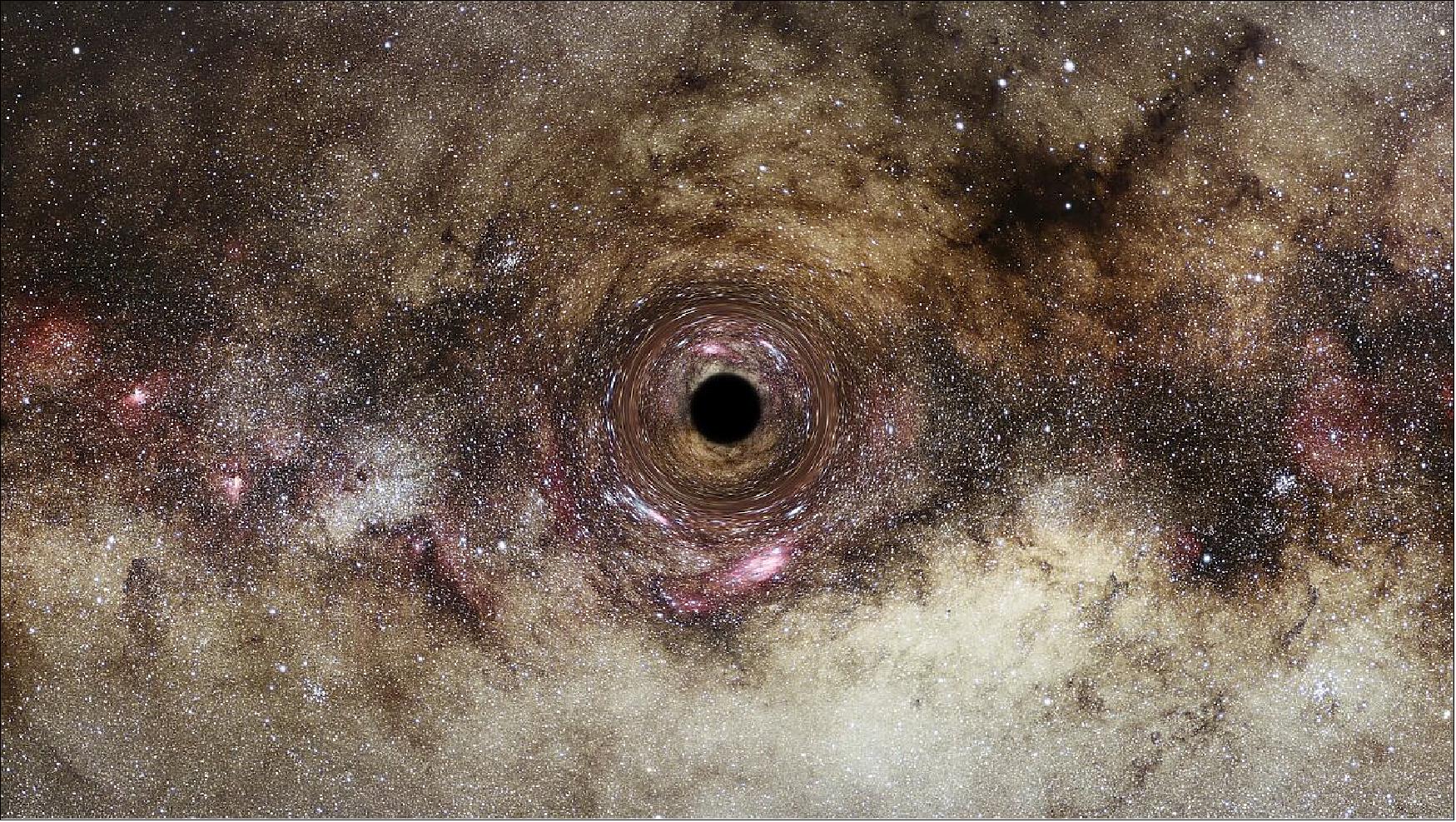
- Next, Hubble was used to measure the amount of deflection of the background star's image by the black hole. Hubble is capable of the extraordinary precision needed for such measurements. The star's image was offset from where it normally would be by about a milliarcsecond. That’s equivalent to measuring the height of an adult human lying on the surface of the moon from the Earth.
- This astrometric microlensing technique provided information on the mass, distance, and velocity of the black hole. The amount of deflection by the black hole's intense warping of space allowed Sahu's team to estimate that it weighs seven solar masses.
- Lam's team reports a slightly lower mass range, meaning that the object may be either a neutron star or a black hole. They estimate that the mass of the invisible compact object is between 1.6 and 4.4 times that of the Sun. At the high end of this range the object would be a black hole; at the low end, it would be a neutron star.
- "As much as we would like to say it is definitively a black hole, we must report all allowed solutions. This includes both lower mass black holes and possibly even a neutron star," said Jessica Lu of the Berkeley team.
- "Whatever it is, the object is the first dark stellar remnant discovered wandering through the galaxy, unacompanied by another star" Lam added.
- This was a particularly difficult measurement for the team because there is another bright star that is extremely close in angular separation to the source star. “So it’s like trying to measure the tiny motion of a firefly next to a bright light bulb,” said Sahu. “We had to meticulously subtract the light of the nearby bright star to precisely measure the deflection of the faint source.”
- Sahu's team estimates the isolated black hole is traveling across the galaxy at 160,000 kilometres per hour (fast enough to travel from Earth to the Moon in less than three hours). That's faster than most of the other neighbouring stars in that region of our galaxy.
- “Astrometric microlensing is conceptually simple but observationally very tough,” said Sahu. “Microlensing is the only technique available for identifying isolated black holes.” When the black hole passed in front of a background star located 19,000 light-years away in the galactic bulge, the starlight coming toward Earth was amplified for a duration of 270 days as the black hole passed by. However, it took several years of Hubble observations to follow how the background star's position appeared to be deflected by the bending of light by the foreground black hole.
- The existence of stellar-mass black holes has been known since the early 1970s, but all of their mass measurements—until now—have been in binary star systems. Gas from the companion star falls into the black hole and is heated to such high temperatures that it emits X-rays. About two dozen black holes have had their masses measured in X-ray binaries through their gravitational effect on their companions. Mass estimates range from 5 to 20 solar masses. Black holes detected in other galaxies by gravitational waves from mergers between black holes and companion objects have been as high as 90 solar masses.
- “Detections of isolated black holes will provide new insights into the population of these objects in the Milky Way,” said Sahu. He expects that his programme will uncover more free-roaming black holes inside our galaxy. But it is a needle-in-a-haystack search. The prediction is that only one in a few hundred microlensing events are caused by isolated black holes.
- In his 1916 paper on general relativity, Albert Einstein predicted that his theory could be tested by observing the offset in the apparent position of a background star caused by the Sun’s gravity. This was tested by a collaboration led by astronomers Arthur Eddington and Frank Dyson during a solar eclipse on 29 May 1919. Eddington and his colleagues measured a background star being offset by 2 arc seconds, validating Einstein’s theories. These scientists could hardly have imagined that over a century later this same technique would be used — with a then-unimaginable thousandfold improvement in precision — to look for black holes across our galaxy.
![Figure 24: The star-filled sky in this NASA/ESA Hubble Space Telescope photo lies in the direction of the Galactic centre. The light from stars is monitored to see if any change in their apparent brightness is caused by a foreground object drifting in front of them. The warping of space by the interloper would momentarily brighten the appearance of a background star, an effect called gravitational lensing. One such event is shown in the four close-up frames at the bottom. The arrow points to a star that momentarily brightened, as first captured by Hubble in August 2011. This was caused by a foreground black hole drifting in front of the star, along our line of sight. The star brightened and then subsequently faded back to its normal brightness as the black hole passed by. Because a black hole doesn't emit or reflect light, it cannot be directly observed. But its unique thumbprint on the fabric of space can be measured through these so-called microlensing events. Though an estimated 100 million isolated black holes roam our galaxy, finding the telltale signature of one is a needle-in-a-haystack search for Hubble astronomers [image credit: NASA, ESA, K. Sahu (STScI), J. DePasquale (STScI)] 22)](https://www.eoportal.org/ftp/satellite-missions/h/Hubble_220722/Hubble_Auto3C.jpeg)
• June 10, 2022: Like Sherlock Holmes’s magnifying glass writ large, the NASA/ESA Hubble Space Telescope has been used to peer into an astronomical mystery in search of clues. The enigma in question concerns the globular cluster Ruprecht 106, which is pictured in this image. While the constituent stars of globular clusters all formed at approximately the same location and time, it turns out that almost all globular clusters contain groups of stars with distinct chemical compositions. These distinct chemical fingerprints are left by groups of stars with very slightly different ages or compositions from the rest of the cluster. A tiny handful of globular clusters do not possess these multiple populations of stars, and Ruprecht 106 is a member of this enigmatic group. 23)
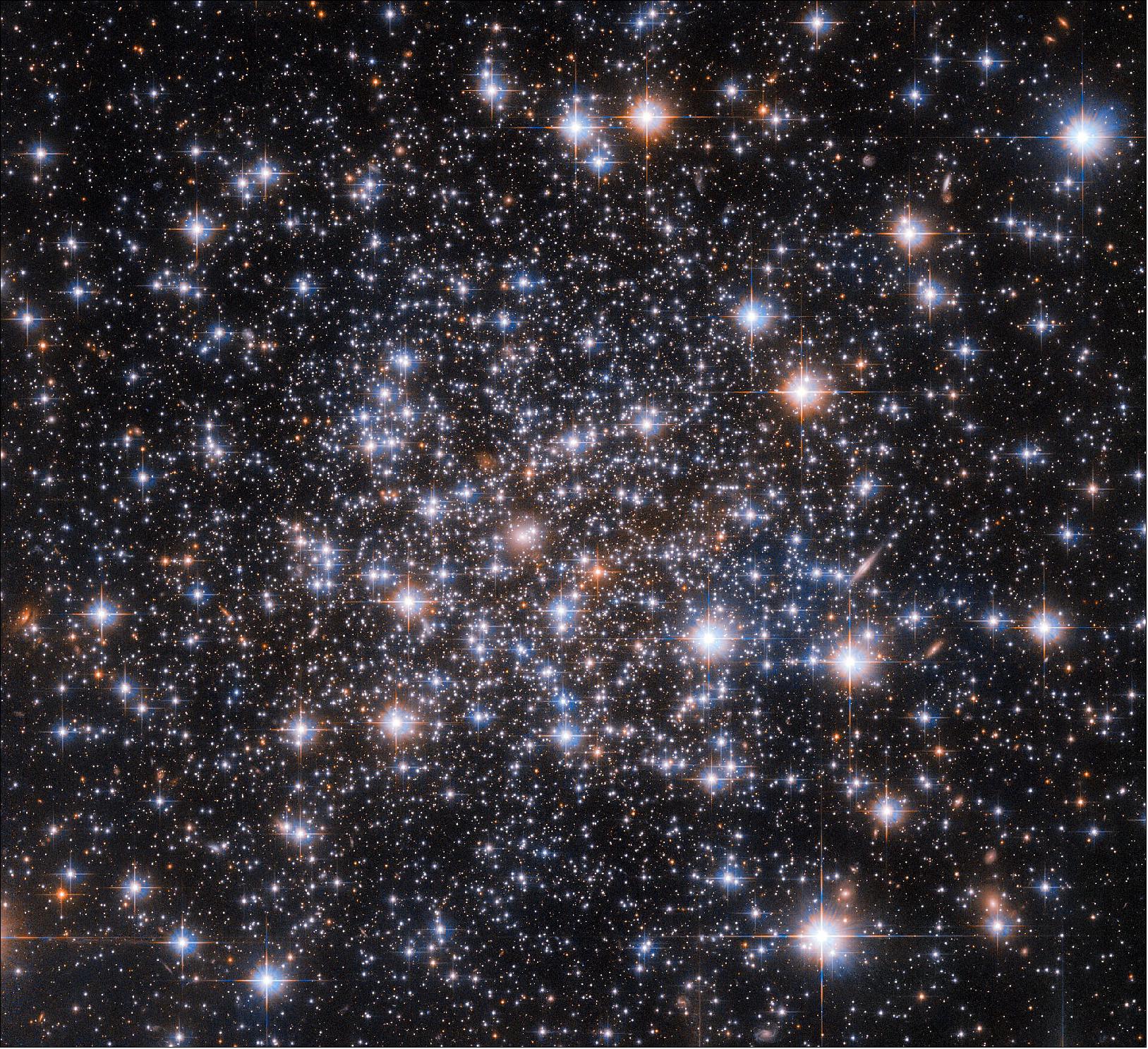
- Astronauts on the NASA Space Shuttle serviced Hubble in orbit a total of five times, and were able to either upgrade aging equipment or replace instruments with newer, more capable versions. This high-tech tinkering in low Earth orbit has helped keep Hubble at the cutting edge of astronomy for more than 3 decades.
• May 31, 2022: Neptune and Uranus have much in common — they have similar masses, sizes, and atmospheric compositions — yet their appearances are notably different. At visible wavelengths Neptune is a rich, deep azure hue whereas Uranus is a distinctly pale shade of cyan. Astronomers now have an explanation for why the two planets are different colours. 24)
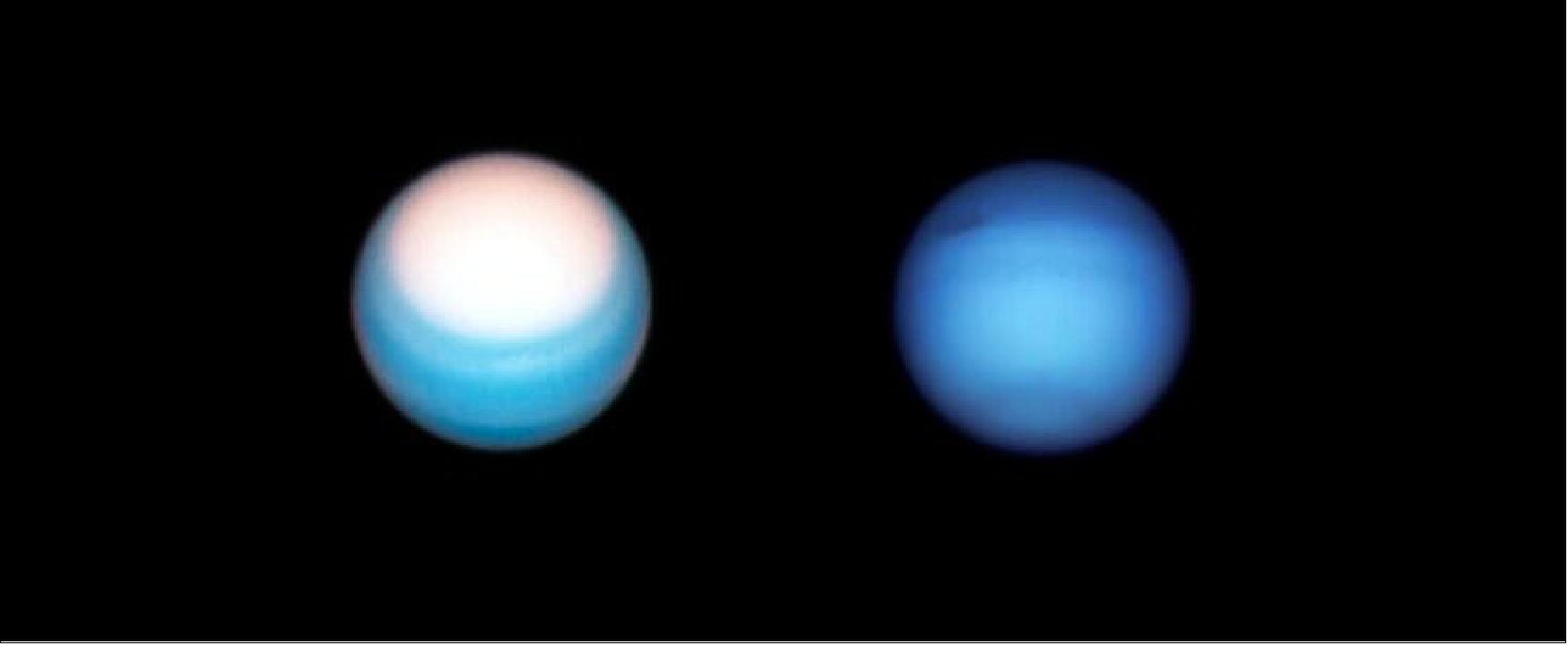
- New research suggests that a layer of concentrated haze that is present on both planets is thicker on Uranus than on Neptune and therefore ‘whitens’ Uranus’s appearance more than Neptune’s [1]. If there was no haze in the atmospheres of Neptune and Uranus, both would appear almost equally blue as a result of blue light being scattered in their atmospheres [2].
- This conclusion comes from a model [3] that an international team led by Patrick Irwin, Professor of Planetary Physics at Oxford University, developed to describe aerosol layers in the atmospheres of Neptune and Uranus [4]. Previous investigations of these planets’ upper atmospheres had focused on the appearance of the atmosphere at only specific wavelengths. However, this new model consists of multiple atmospheric layers and matches observations from both planets across a wide range of wavelengths. The new model also includes haze particles within deeper layers that had previously been thought to contain only clouds of methane and hydrogen sulphide ices.
- “This is the first model to simultaneously fit observations of reflected sunlight from ultraviolet to near-infrared wavelengths,” explained Irwin, who is the lead author of a paper presenting this result in the Journal of Geophysical Research: Planets. “It’s also the first to explain the difference in visible colour between Uranus and Neptune.”
- The team’s model consists of three layers of aerosols at different heights [5]. The key layer that affects the colours is the middle layer, which is a layer of haze particles (referred to in the paper as the Aerosol-2 layer) that is thicker on Uranus than on Neptune. The team suspects that, on both planets, methane ice condenses onto the particles in this layer, pulling the particles deeper into the atmosphere in a shower of methane snow. Because Neptune has a more active, turbulent atmosphere than Uranus does, the team believes Neptune’s atmosphere is more efficient at churning up methane particles into the haze layer and producing this snow. This removes more of the haze and keeps Neptune’s haze layer thinner than it is on Uranus, with the result that the blue colour of Neptune looks stronger.
- “We hoped that developing this model would help us understand clouds and hazes in the ice giant atmospheres,” commented Mike Wong, an astronomer at the University of California, Berkeley, and a member of the team behind this result. “Explaining the difference in colour between Uranus and Neptune was an unexpected bonus!”
- To create this model, Irwin’s team analysed archival data spanning several years from the NASA/ESA Hubble Space Telescope. This spectrographic data was obtained with Hubble’s Space Telescope Imaging Spectrograph (STIS), covering a broad range of wavelengths from ultraviolet through to visible and infrared (0.3–1.0 µm). It was complemented with data from ground-based telescopes: a set of new observations from the Gemini North telescope, and archival data from the NASA Infrared Telescope Facility, both located in Hawai‘i.
- Not only did the team examine the spectra of the planets, they also made use of some of the many images Hubble has taken of the two planets with its Wide Field Camera 3 (WFC3) instrument. Hubble provides excellent views of the distinctive atmospheric storms shared by both planets known as ‘dark spots’, which astronomers have been aware of for many years. It wasn't known exactly which atmospheric layers were disturbed by dark spots to make them visible to Hubble. The model produced by the team explains what gives the spots a dark appearance, and why they are more easily detectable on Uranus compared to Neptune.
- The authors thought that a darkening of the aerosols at the deepest layer of their model would produce dark spots similar to those seen on Neptune and perhaps Uranus. With the detailed images from Hubble, they could check and confirm their hypothesis. Indeed, simulated images based on that model were seen to closely match the WFC3 images of both planets, producing dark spots visible at the same wavelengths. The same thick haze in the Aerosol-2 layer on Uranus that causes its lighter blue colour is believed also to obscure these dark spots more often than on Neptune.
- This research was presented in the paper “Hazy blue worlds: A holistic aerosol model for Uranus and Neptune, including Dark Spots” to appear in the Journal of Geophysical Research: Planets. 25)
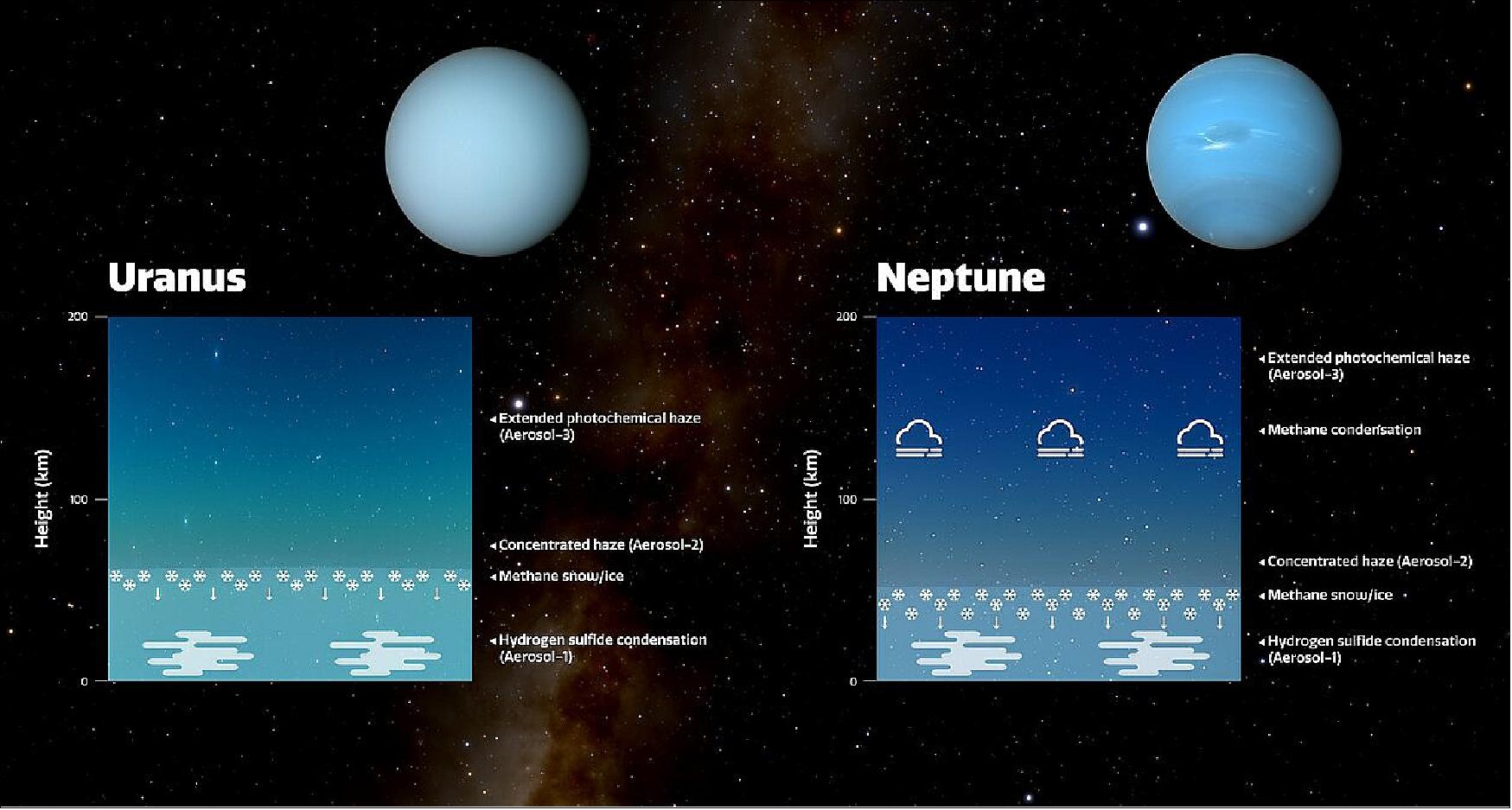
• May 27, 2022: This new image from NASA’s Hubble Space Telescope looks at two spiral galaxies, collectively known as Arp 303. The pair, individually called IC 563 (bottom right) and IC 564 (top left), are 275 million light-years away in the direction of the constellation Sextans. 26)
![Figure 28: The image holds data from two separate Hubble observations of Arp 303. The first used Hubble’s Wide Field Camera 3 (WFC3) to study the pair’s clumpy star-forming regions in infrared light. Galaxies like IC 563 and IC 564 are very bright at infrared wavelengths and host many bright star-forming regions. The second used Hubble’s Advanced Camera for Surveys (ACS) to take quick looks at bright, interesting galaxies across the sky. The observations filled gaps in Hubble’s archive and looked for promising candidates that Hubble, the James Webb Space Telescope, and other telescopes could study further. The colors red, orange, and green represent infrared wavelengths taken with WFC3, and the color blue represents ACS visible light data [image credit: NASA, ESA, K. Larson (STScI), and J. Dalcanton (University of Washington); Image Processing: G. Kober (NASA Goddard/Catholic University of America)]](https://www.eoportal.org/ftp/satellite-missions/h/Hubble_220722/Hubble_Auto38.jpeg)
• May 26, 2022: The muted red tones of the globular cluster Liller 1 are partially obscured in this image by a dense scattering of piercingly blue stars. In fact, it is thanks to Hubble’s Wide Field Camera 3 (WFC3) that we are able to see Liller 1 so clearly in this image, because the WFC3 is sensitive to wavelengths of light that the human eye cannot detect. Liller 1 is only 30,000 light-years from Earth — relatively neighbourly in astronomical terms — but it lies within the Milky Way’s ‘bulge’, the dense and dusty region at our galaxy’s centre. Because of that, Liller 1 is heavily obscured from view by interstellar dust, which scatters visible light (particularly blue light) very effectively. Fortunately, some infrared and red visible light are able to pass through these dusty regions. WFC3 is sensitive to both visible and near-infrared (infrared that is close to the visible) wavelengths, allowing us to see through the obscuring clouds of dust, and providing this spectacular view of Liller 1. 27)
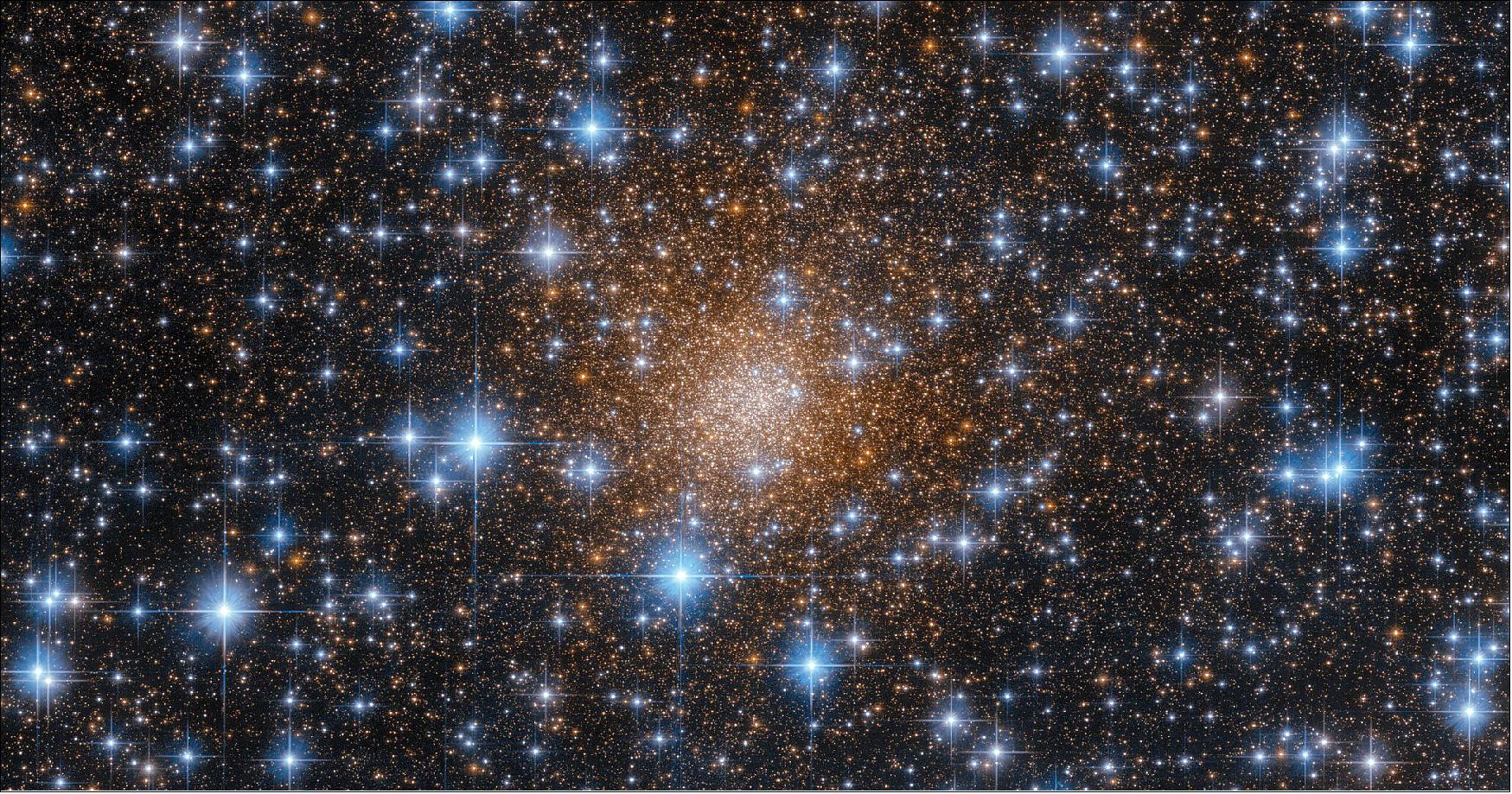
• May 26, 2022: This image from NASA’s Hubble Space Telescope features the Grand Design Spiral, NGC 3631, located some 53 million light-years away in the direction of the constellation Ursa Major. The “arms” of grand design spirals appear to wind around and into the galaxy’s nucleus. 28)
- Close inspection of NGC 3631’s grand spiral arms reveals dark dust lanes and bright star-forming regions along the inner part of the spiral arms. Star formation in spirals is similar to a traffic jam on the interstate. Like cars on the highway, slower moving matter in the spiral’s disk creates a bottleneck, concentrating star-forming gas and dust along the inner part of their spiral arms. This traffic jam of matter can get so dense that it gravitationally collapses, creating new stars (here seen in bright blue-white).
![Figure 30: The image uses data collected from Hubble’s Wide Field Camera 3 and Advanced Camera for Surveys. The color blue represents visible wavelengths of blue light, and the color orange represents infrared light [image credit: NASA, ESA, A. Filippenko (University of California - Berkeley), and D. Sand (University of Arizona); Image Processing: G. Kober (NASA Goddard/Catholic University of America)]](https://www.eoportal.org/ftp/satellite-missions/h/Hubble_220722/Hubble_Auto36.jpeg)
• May 25, 2022: This NASA Hubble Space Telescope image finds the large spiral galaxy, NGC 3227, wrapped in a turbulent gravitational dance with its companion, the elliptical galaxy NGC 3226. The twosome – collectively known as Arp 94 – is relatively nearby, between 50 and 60 million light-years away toward the constellation Leo, the Lion. A close look at the area between the two galaxies, reveals faint tidal streams of gas and dust that link the pair in their gravitational dance. 29)
- NGC 3227 is a Seyfert galaxy, a type of galaxy with a very active nucleus. Seyfert galaxies hold supermassive black holes at their cores. As matter spirals into the black hole, it releases vast amounts of radiation along the black hole’s axis of rotation. giving the galaxy its active nucleus.
![Figure 31: Hubble looked at NGC 3227 and 3226 as part of a program to measure black hole masses by observing the dynamics of gas at the centers of bright cluster galaxies. The color red in this image represents both visible red and near infrared wavelengths of light [image credit: NASA, ESA, and H. Ford (Johns Hopkins University); Image Processing: G. Kober (NASA Goddard/Catholic University of America)]](https://www.eoportal.org/ftp/satellite-missions/h/Hubble_220722/Hubble_Auto35.jpeg)
![Figure 32: The upper left, black and white image taken by the Digital Sky Survey outlines the portion of NGC 3227 and 3226 that Hubble imaged. The lower left Hubble image highlights the active core of NGC 3227 and showcases its dark dust lanes and bright star-forming regions [image credits: NASA, ESA, H. Ford (Johns Hopkins University), and DSS; Image Processing: G. Kober (NASA Goddard/Catholic University of America)]](https://www.eoportal.org/ftp/satellite-missions/h/Hubble_220722/Hubble_Auto34.jpeg)
• May 23, 2022: This striking pair is an elliptical galaxy NGC 541 and an unusual star-forming, irregular dwarf galaxy known as Minkowski’s Object (the bluish object to the lower left of NGC 541). Elliptical galaxies are nearly spherical to egg-shaped groups of stars that form when galaxies merge. NGC 541 shoots out radio jets that are invisible to human eyes but detectable by radio telescopes. These jets originate in the accretion disk around the galaxy’s central black hole. 30)
- The radio jet from NGC 541 likely caused the star-formation in Minkowski’s Object. Radio galaxies like NGC 541 are surrounded by gaseous halos and/or debris from recent merger events – which may have triggered the radio galaxy activity in the first place. The jet plows into the moderately dense, warm gas around the galaxy and the shock compresses and heats the gas, causing it to become energized, or ionized. As the ionized gas reverts from its higher-energy state to a lower-energy state, energy leaves the cloud in the form of radiation. As the clouds cool, they collapse, giving rise to starbirth. Minkowski’s Object is about 7.5 million years old and consists of about 20 million stars.
![Figure 33: Hubble observed Minkowski’s Object and NGC 541 to get a better sense of how star formation occurs in this region, what kind of star formation takes place, and the properties of the jet that triggers it [image credit: NASA, ESA, and S. Croft (Eureka Scientific Inc.); Image Processing: Gladys Kober (NASA Goddard/Catholic University of America)]](https://www.eoportal.org/ftp/satellite-missions/h/Hubble_220722/Hubble_Auto33.jpeg)
• May 20, 2022: This new NASA Hubble Space Telescope image of IC 4271, also known as Arp 40, is a curious pair of spiral galaxies some 800 million light-years away. The smaller galaxy is superimposed on the larger one, which is a type of active galaxy called a Seyfert galaxy. 31)
- Seyfert galaxies are named for astronomer Carl K. Seyfert who, in 1943, published a paper about spiral galaxies with very bright emission lines. Today we know that about 10% of all galaxies may be Seyfert galaxies. They belong to the class of “active galaxies” – galaxies that have supermassive black holes at their centers accreting material, which releases vast amounts of radiation. The active cores of Seyfert galaxies are at their brightest when observed in light outside the visible spectrum. The larger galaxy in this pair is a Type II Seyfert galaxy, which means it is a very bright source of infrared and visible light.
![Figure 34: The image uses data collected during Hubble observations designed to study the role of dust in shaping the energy distributions of low mass disk galaxies. The Hubble observations looked at six pairs of galaxies where one was in front of the other. The broad range of light that Hubble’s Wide Field Camera 3 is sensitive to, along with its resolution, allowed the researchers to map the foreground galaxy’s dust disk in fine detail across ultra-violet, visible, and infrared light. Because IC 4271 is a Type II Seyfert Galaxy, visible and infrared wavelengths of light dominate the image. The colors in this image are primarily visible light, while the color violet represents ultraviolet light and red represents near infrared light [image credit: NASA, ESA, and B. Holwerda (University of Louisville Research Foundation, Inc.); Image processing: G. Kober (NASA Goddard/Catholic University of America)]](https://www.eoportal.org/ftp/satellite-missions/h/Hubble_220722/Hubble_Auto32.jpeg)
• May 20, 2022: Globular clusters like NGC 6558 are tightly bound collections of tens of thousands to millions of stars, and they can be found in a wide range of galaxies. As this observation shows, the stars in globular clusters can be densely packed; this image is thronged with stars in a rich variety of hues. Some of the brightest inhabitants of this globular cluster are surrounded by prominent diffraction spikes, which are imaging artefacts caused by starlight interacting with the inner workings of Hubble. 32)
- Globular clusters equip astronomers with interesting natural laboratories in which to test their theories, as all the stars in a globular cluster formed at approximately the same time with similar initial composition. These stellar clusters therefore provide unique insights into how different stars evolve under similar conditions. This image comes from a set of observations investigating globular clusters in the inner Milky Way. Astronomers were interested in studying these globular clusters to gain greater insight into how globular clusters in the inner Milky Way form and evolve.
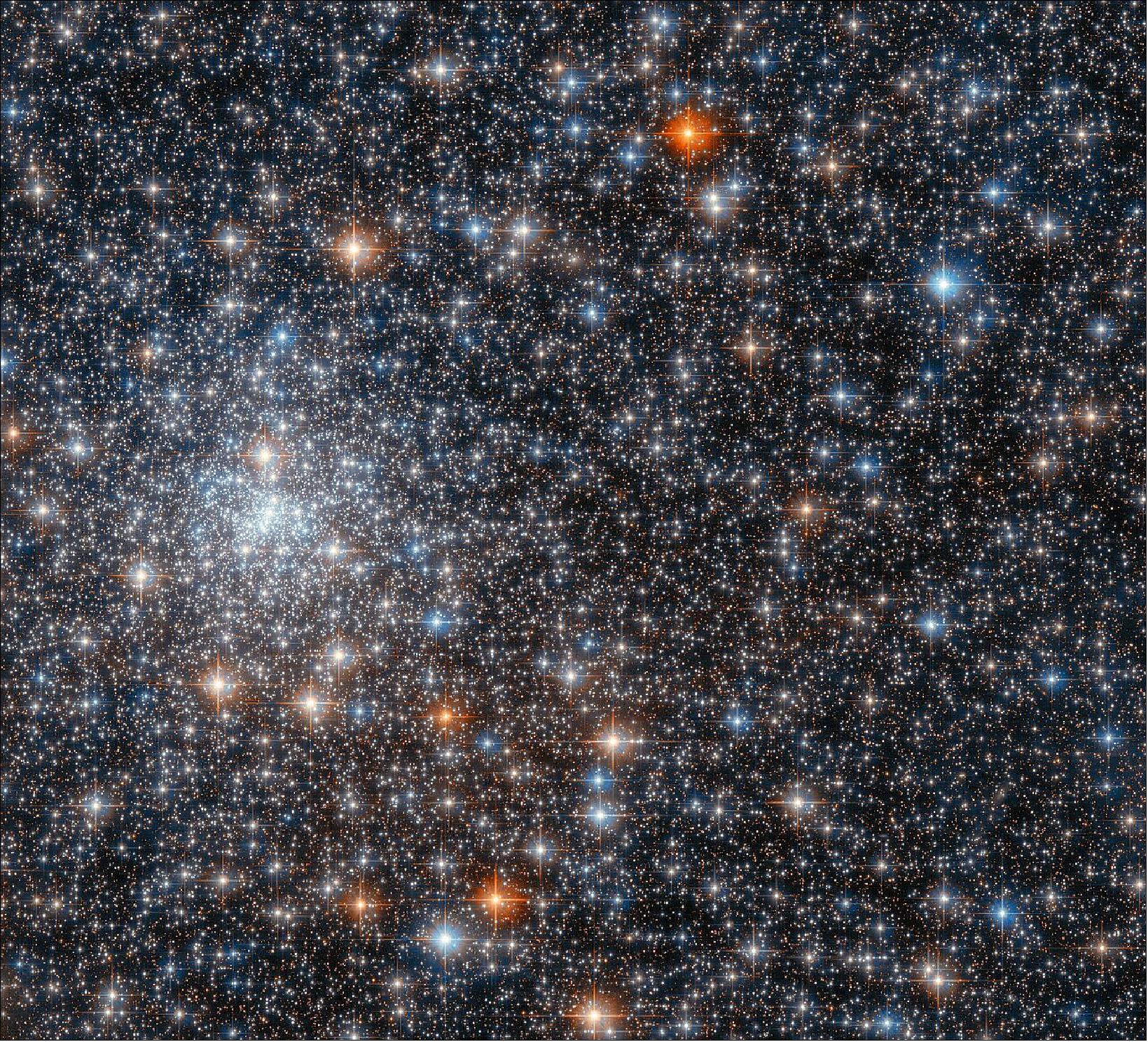
• May 19, 2022: This new NASA Hubble Space Telescope image looks at one of the nearest, massive lenticular galaxies to Earth, NGC 1023 some 36 million light-years away. Lenticular galaxies get their names from their edge-on appearance that resembles a lens. They are intermediate galaxies between ellipticals and spirals. Lenticular galaxies have a large central bulge and a flattened disk like spirals, but no spiral arms. Like ellipticals, lenticular galaxies don’t have much gas and dust, and also have mainly old stars. 33)
![Figure 36: NGC 1023 is not alone in this image. The fuzzy blue patch to the lower left of the galaxy is NGC 1023a, an irregular satellite galaxy of its large lenticular neighbor. The galaxy pair was part of a study that looked at multiple star systems and star clusters in galaxies beyond our own Milky Way. The researchers found 81 long-lived open star clusters (loosely bound groups of a few tens to a few hundred stars) in NGC 1023’s disk as well as 27 young blue star clusters. Half of the young blue star clusters are associated with the satellite galaxy, while the rest are spatially associated with the neutral hydrogen gas that surrounds the large lenticular galaxy. [image credit: NASA, ESA, and G. Sivakoff (University of Alberta); Image processing: G. Kober (NASA Goddard/Catholic University of America)]](https://www.eoportal.org/ftp/satellite-missions/h/Hubble_220722/Hubble_Auto30.jpeg)
- The image uses data from Hubble’s Advanced Camera for Surveys. Additional gap-filling data provided by the Pan-STARRS collaboration. The color blue represents visible blue light while the color orange represents near infrared light.
• May 18, 2022: This new NASA Hubble Space Telescope image captures the central region of the gigantic elliptical galaxy NGC 474. Located some 100 million light-years from Earth, NGC 474 spans about 250,000 light-years across – that’s 2.5 times larger than our own Milky Way galaxy! Along with its enormous size, NGC 474 has a series of complex layered shells that surround its spherical-shaped core. The cause of these shells is unknown, but astronomers theorize that they may be the aftereffects of the giant galaxy absorbing one or more smaller galaxies. In the same way a pebble creates ripples on a pond when dropped into the water, the absorbed galaxy creates waves that form the shells. 34)
- About 10% of elliptical galaxies have shell structures, but unlike the majority of elliptical galaxies, which are associated with galaxy clusters, shelled ellipticals usually lie in relatively empty space. It may be that they’ve cannibalized their neighbors.
![Figure 37: The image was created using data from Hubble’s Advanced Camera for Surveys. Additional gap-filling data was provided by Hubble’s Wide Field and Planetary Camera 2 and Wide Field Camera 3. The color blue represents visible blue light while the color orange represents near infrared light [image credit: NASA, ESA, and D. Carter (Liverpool John Moores University); Image processing: G. Kober (NASA Goddard/Catholic University of America)]](https://www.eoportal.org/ftp/satellite-missions/h/Hubble_220722/Hubble_Auto2F.jpeg)
![Figure 38: Most elliptical galaxies are associated with galaxy clusters, but NGC 474 is in a relatively empty part of space. Only a much smaller spiral galaxy, NGC 470, is nearby and visible in the Digital Sky Survey image above. This beautiful spiral will likely succumb to NGC 474’s gravitational pull billions of years from now, possibly creating even more complex shells around the giant elliptical [image credits: NASA, ESA, D. Carter (Liverpool John Moores University), DSS; Image processing: G. Kober (NASA Goddard/Catholic University of America)]](https://www.eoportal.org/ftp/satellite-missions/h/Hubble_220722/Hubble_Auto2E.jpeg)
• May 17, 2022: This newly revised NASA Hubble Space Telescope image of the Hickson Compact Group 31 (HCG 31) of galaxies highlights streams of star-formation as four dwarf galaxies interact. 35)
- Dwarf galaxy encounters are normally seen billions of light-years away, and therefore occurred billions of years ago, but HCG 31 is located some 166 million light-years from Earth, relatively close by cosmic standards. The newly revised image emphasizes star-forming regions spurred by the quartet’s gravitational dance. The color blue represents visible blue light and showcases young, hot, blue stars, while the color red represents near-infrared light.
- To view the 2010 release of this image (Figure 39), see Jurassic Space: Ancient Galaxies Come Together After Billions of Years
![Figure 39: The bright, distorted clump of young blue-white stars (top-right of center) is NGC 1741. Although it appears to be a single galaxy, NGC 1741 is actually a pair of colliding dwarf galaxies. Another dwarf, cigar-shaped galaxy to the pair’s right joins their dance with a thin, blue stream of stars that connects the trio. HGC 31’s fourth member is revealed by a stream of young blue stars that point to the galaxy (bottom-left of center) and indicate its interaction with the other three. The bright object in the center of the image is a star situated between Earth and HCG 31 [image credit: NASA, ESA, and J. Charlton (Pennsylvania State University); Image processing: G. Kober (NASA Goddard/Catholic University of America)]](https://www.eoportal.org/ftp/satellite-missions/h/Hubble_220722/Hubble_Auto2D.jpeg)
• May 13, 2022: This new NASA Hubble Space Telescope image spotlights the giant elliptical galaxy, UGC 10143, at the heart of galaxy cluster, Abell 2147, about 486 million light-years away in the head of the serpent, the constellation Serpens. UGC 10143 is the biggest and brightest member of Abell 2147, which itself may be part of the much larger Hercules Supercluster of galaxies. UGC 10143’s bright center, dim extended halo, and lack of spiral arms and star-forming dust lanes distinguish it as an elliptical galaxy. Ellipticals are often near the center of galaxy clusters, suggesting they may form when galaxies merge. 36)
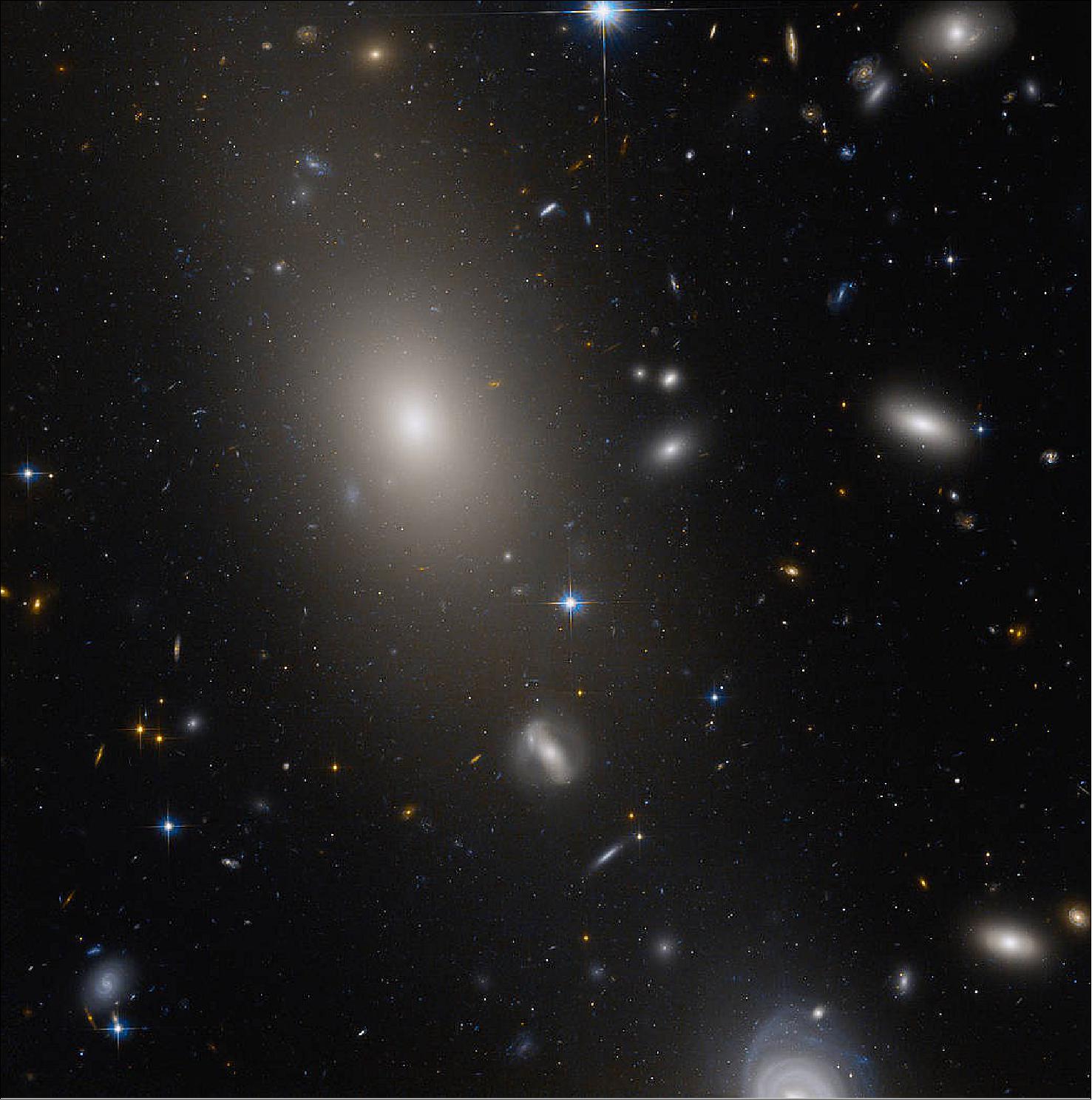
• May 13, 2022: This image from the NASA/ESA Hubble Space Telescope shows the tattered remnant of a supernova — a titanic explosion marking the end of the life of a dying star. This object — known as DEM L249 — is thought to have been created by a Type 1a supernova during the death throes of a white dwarf. While white dwarfs are usually stable, they can slowly accrue matter if they are part of a binary star system. This accretion of matter continues until the white dwarf reaches a critical mass and undergoes a catastrophic supernova explosion, ejecting a vast amount of material into space in the process. 37)
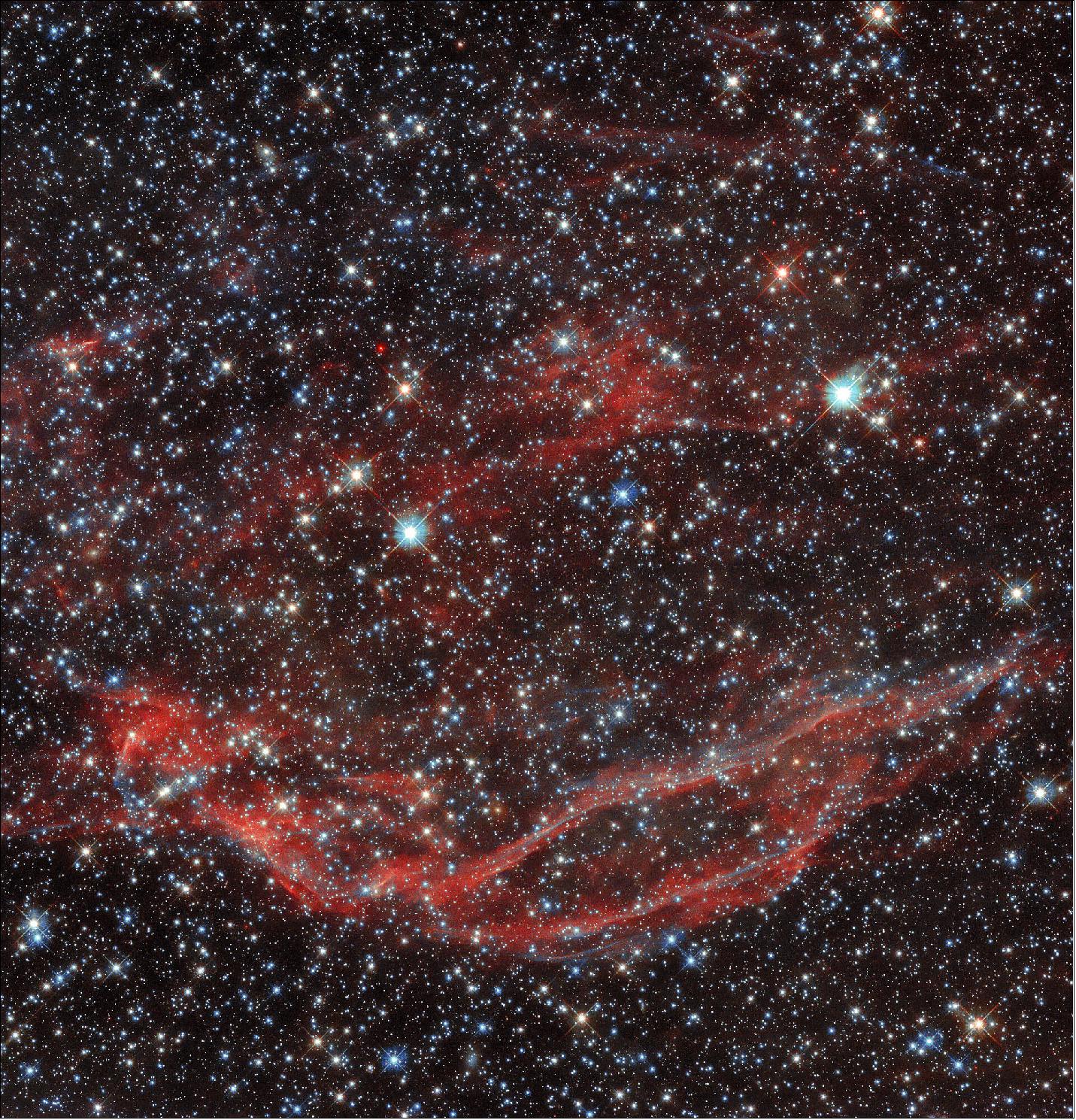
• May 12, 2022: NASA’s Hubble Space Telescope has allowed astronomers to view galaxies of all shapes and sizes from nearly every angle. When a galaxy is seen edge-on, the mesmerizing perspective reveals a dazzling slice of the universe. The “Little Sombrero,” also known as NGC 7814 or Caldwell 43, is one such galaxy. 38)
- Set against a speckled backdrop of more remote galaxies, the Little Sombrero features a bright central bulge, a thin disk full of dust, and a glowing halo of gas and stars that sprawls out into space. It is roughly 40 million light-years from Earth, 80,000 light-years-wide, and billions of years old.
- The dusty spiral is named after the grander-appearing Sombrero Galaxy, which resembles a broad-brimmed Mexican hat. Also viewed from its edge, the Sombrero galaxy is located just 28 million light-years away and looks larger than the Little Sombrero. In reality, they are nearly the same size, but the Sombrero appears bigger because it is closer.
![Figure 42: This image of the Little Sombrero is a combination of visible and infrared observations captured by Hubble’s Advanced Camera for Surveys in 2006. The observations were taken to assist astronomers in studying the galaxy’s stellar populations, and to help shed light on the evolution of this galaxy and others like it. Edge-on galaxy, with a distinctive dust lane, extending from upper right to middle-left of the image. Distant galaxies dot the scene [image credit: NASA, ESA, and R. de Jong (Leibniz-Institut fur Astrophysik Potsdam); Image processing: G. Kober (NASA Goddard/Catholic University of America)]](https://www.eoportal.org/ftp/satellite-missions/h/Hubble_220722/Hubble_Auto2A.jpeg)
• May 11, 2022: Spiral galaxy IC 342, also known as Caldwell 5, is located approximately 11 million light-years from Earth. This sparkling, face-on view of the center of the galaxy displays intertwined tendrils of dust in spectacular arms that wrap around a brilliant core of hot gas and stars. This core is a specific type of region called an H II nucleus – an area of atomic hydrogen that has become ionized. Such regions are energetic birthplaces of stars where thousands of stars can form over a couple million years. Each young, extremely hot, blue star emits ultraviolet light, further ionizing the surrounding hydrogen. 39)
![Figure 43: Despite its relatively bright 8.4 magnitude, this galaxy doesn’t stand out in the sky. It appears near the equator of the Milky Way’s pearly disk, which is crowded with thick cosmic gas, dark dust, and glowing stars that all obscure our view. This has earned Caldwell 5 the nickname of the Hidden Galaxy. Were it not obscured by so much interstellar matter, the Hidden Galaxy would be one of the brightest galaxies in our sky. A relatively close galaxy, it is roughly 50,000 light-years across and billions of years old [image credit: NASA, ESA, P. Sell (University of Florida), and P. Kaaret (University of Iowa); Image processing: G. Kober (NASA Goddard/Catholic University of America)]](https://www.eoportal.org/ftp/satellite-missions/h/Hubble_220722/Hubble_Auto29.jpeg)
• May 10, 2022: This NASA Hubble Space Telescope image shows a section of the spiral galaxy nicknamed the Needle’s Eye – an appropriately diminutive name for a dwarf spiral galaxy. The Needle’s Eye, also known as NGC 247 and Caldwell 62, is located about 11 million light-years away in the Sculptor Group – the closest group of galaxies to our own (the Local Group). The galaxy was given its nickname because one end of it features a strange void of stars (not seen in this Hubble close-up). 40)
- The “hole” in Caldwell 62 on the other side of the galaxy is a big mystery. There is a shortage of gas in that part of the galaxy, which means there isn’t much material from which new stars can form. Since star formation has halted in this area, old, faint stars populate the void. Scientists still don’t know how this strange feature formed, but studies hint toward past gravitational interactions with another galaxy.
- Caldwell 62 is also home to an object known as an ultraluminous X-ray source. Scientists have long debated the nature of these super-bright X-ray sources. Are they stellar-mass black holes gorging on unusually large amounts of gas? Or are they long-sought “intermediate-mass” black holes, dozens of times more massive than their stellar counterparts but smaller than the monster black holes in the centers of most galaxies? By studying Caldwell 62 in multiple forms of light (visible and infrared using Hubble, and X-rays using the Chandra X-ray Observatory), astronomers have found signs that the X-rays are coming from a disk around an intermediate-mass black hole.
![Figure 44: This image zooms into the very edge of the galaxy, on the opposite side of the void. Below the edge of the galaxy’s disk, smaller and more distant galaxies are visible, as well as a very bright foreground star that lies between us and NGC 247. Bright red indicates areas of high-density gas and dust, and robust star formation rather close to the edge of the galaxy [image credit: NASA, ESA, and H. Feng (Tsinghua University); Image processing: G. Kober (NASA Goddard/Catholic University of America)]](https://www.eoportal.org/ftp/satellite-missions/h/Hubble_220722/Hubble_Auto28.jpeg)
• May 6, 2022: Combining artificial intelligence with many keen human eyes, astronomers have found 1701 new asteroid trails in archival data from the NASA/ESA Hubble Space Telescope, consisting of more than 37,000 images that span two decades. The project reflects both Hubble’s value to scientists as an asteroid hunter and how the public can effectively contribute to citizen science initiatives. 41) 42) 43)
- On International Asteroid Day in June 2019 an international group of astronomers launched the Hubble Astrroid Hunter, a citizen science project to identify asteroids in archival Hubble data. The initiative was developed by researchers and engineers at the European Science and Technology Centre (ESTEC) and the European Space Astronomy Centre’s Science Data Centre (ESDC), in collaboration with the Zooniverse platform, the world’s largest and most popular citizen science platform, and Google.
- The astronomers collectively identified more than 37,000 composite images taken between April 2002 and March 2021 with Hubble’s ACS and WFC3 instruments. With a typical observation time of 30 minutes, asteroid trails appear as curved lines or streaks in these images. Over 11 400 members of the public classified and analysed these images. More than 1000 trails were identified, providing a training set for an automated algorithm based on artificial intelligence. The combination of citizen science and AI resulted in a final dataset containing 1701 trails in 1316 Hubble images. Project participants also tagged various other astronomical objects, such as gravitational lenses, galaxies and nebulae. Volunteers discussed their findings and sought assistance from scientists and other participants via the project's forum.
- Roughly one third of the asteroid trails seen could be identified and attributed to known asteroids in the International Astronomical Union’s Minor Planet Centre, the largest database of Solar System objects. This left 1031 unidentified trails that are faint and likely to be smaller asteroids than those detected in ground-based surveys. The vast majority of these asteroids are expected to be located in the Main Belt between Mars and Jupiter, where asteroids of such small size are as yet poorly studied. These trails could give the astronomers insightful clues about the conditions in the early Solar System when the planets were forming.
- The project highlights Hubble’s potential to image faint, previously unknown asteroids and represents a new approach to finding asteroids in astronomical archives spanning decades, which may be effectively applied to other datasets. In addition to illustrating Hubble’s value as an asteroid hunter, it also reinforced the public’s interest in contributing towards scientific endeavours and the value of citizen science efforts.
- Next, the project will explore the 1031 streaks of previously unknown asteroids to characterise their orbits and study their properties, such as their sizes and rotation periods. As most of these asteroid streaks were captured by Hubble many years ago, it is not possible to follow them up now to determine their orbits [1]. However, using Hubble, astronomers can use the parallax effect to determine the distance to the unknown asteroids and put constraints on their orbits. As Hubble moves around the Earth, it changes its point of view while observing the asteroid which also moves on its own orbit. By knowing the position of Hubble during the observation and measuring the curvature of the streaks, scientists can determine the distances to the asteroids and estimate the shapes of their orbits. Some of the longer Hubble observations facilitate the measurement of a light curve [2] for the asteroids, from which the team can measure their rotation periods and infer their shapes.
![Figure 45: This mosaic consists of 16 different data sets from the NASA/ESA Hubble Space Telescope that were studied as part of the Asteroid Hunter citizen science project. Each of these datasets was assigned a colour based on the time sequence of exposures, such that the blue tones represent the first exposure in which the asteroid was captured and the red tones represent the last [image credit: ESA/Hubble & NASA, S. Kruk (ESA/ESTEC), Hubble Asteroid Hunter citizen science team, M. Zamani (ESA/Hubble)]](https://www.eoportal.org/ftp/satellite-missions/h/Hubble_220722/Hubble_Auto27.jpeg)
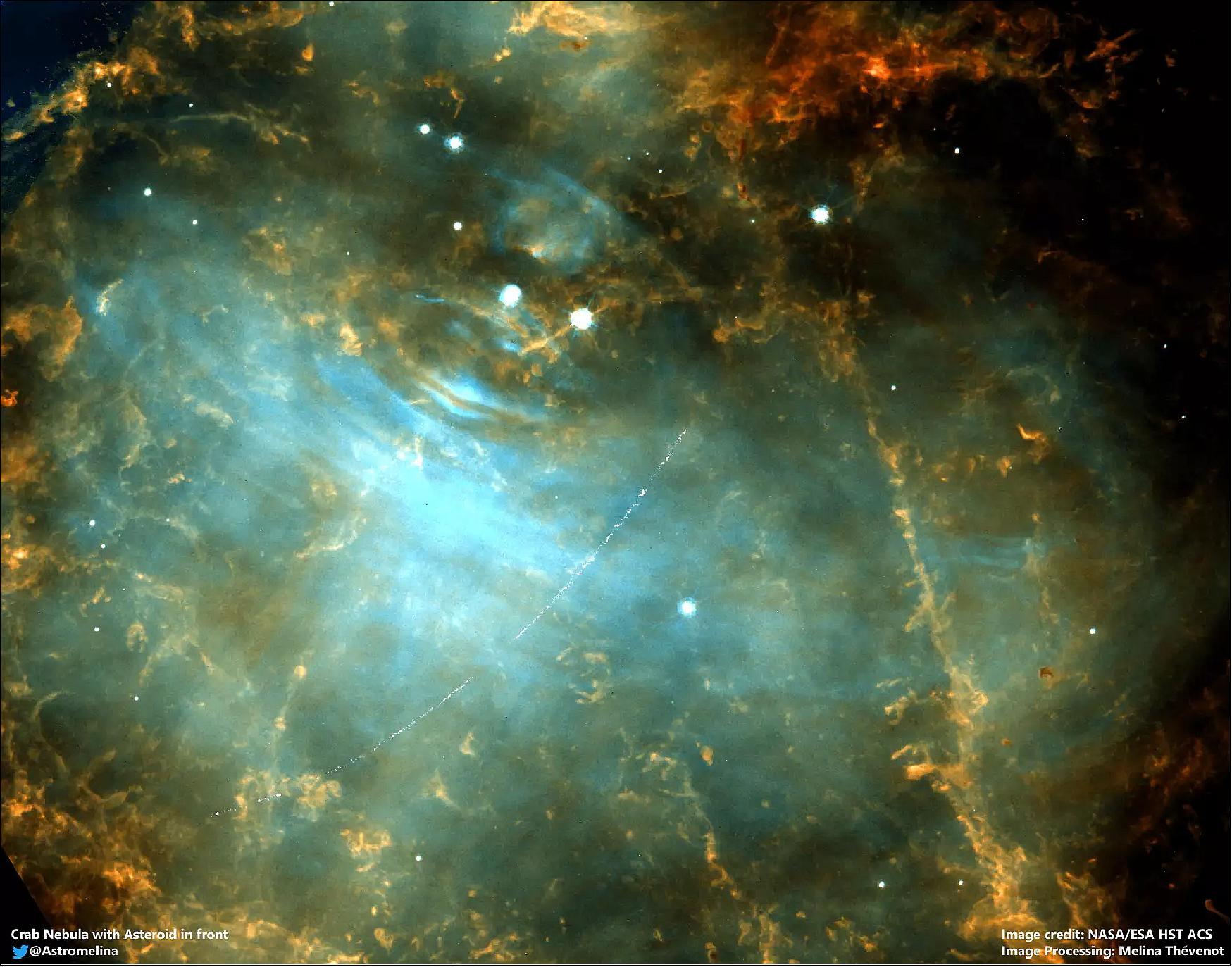
• May 05, 2022: NASA's Hubble Space Telescope has uncovered a witness at the scene of a star's explosive death: a companion star previously hidden in the glare of its partner's supernova. The discovery is a first for a particular type of supernova – one in which the star was stripped of its entire outer gas envelope before exploding. 44)
It's not unheard of to find a surviving star at the scene of a titanic supernova explosion, which would be expected to obliterate everything around it, but the latest research from the Hubble Space Telescope has provided a long-awaited clue to a specific type of stellar death. In some supernova cases, astronomers find no trace of the former star's outermost layer of hydrogen. What happened to the hydrogen? Suspicions that companion stars are responsible—siphoning away their partners' outer shell before their death—are supported by Hubble's identification of a surviving companion star on the scene of supernova 2013ge. The discovery also lends support to the theory that the majority of massive stars form and evolve as binary systems. It could also be the prequel to another cosmic drama: In time, the surviving, massive companion star will also undergo a supernova, and if both the stars' remnant cores are not flung from the system, they will eventually merge and produce gravitational waves, shaking the fabric of space itself.
- The finding provides crucial insight into the binary nature of massive stars, as well as the potential prequel to the ultimate merger of the companion stars that would rattle across the universe as gravitational waves, ripples in the fabric of spacetime itself.
- Astronomers detect the signature of various elements in supernova explosions. These elements are layered like an onion pre-supernova. Hydrogen is found in the outermost layer of a star, and if no hydrogen is detected in the aftermath of the supernova, that means it was stripped away before the explosion occurred.
- The cause of the hydrogen loss had been a mystery, and astronomers have been using Hubble to search for clues and test theories to explain these stripped supernovae. The new Hubble observations provide the best evidence yet to support the theory that an unseen companion star siphons off the gas envelope from its partner star before it explodes.
- "This was the moment we had been waiting for, finally seeing the evidence for a binary system progenitor of a fully stripped supernova," said astronomer Ori Fox of the Space Telescope Science Institute in Baltimore, Maryland, lead investigator on the Hubble research program. "The goal is to move this area of study from theory to working with data and seeing what these systems really look like."
- Fox's team used Hubble's Wide Field Camera 3 to study the region of supernova (SN) 2013ge in ultraviolet light, as well as previous Hubble observations in the Barbara A. Mikulski Archive for Space Telescopes (MAST). Astronomers saw the light of the supernova fading over time from 2016 to 2020—but another nearby source of ultraviolet light at the same position maintained its brightness. This underlying source of ultraviolet emission is what the team proposes is the surviving binary companion to SN 2013ge.
![Figure 47: This artist's illustration shows supernova 2013ge, with its companion star at lower right. The companion star is impacted by the blast wave from the supernova, but not destroyed. Over time astronomers observed the ultraviolet (UV) light of the supernova fading, revealing a nearby second source of UV light that maintained brightness. The theory is that the two massive stars evolved together as a binary pair, and that the current survivor siphoned off its partner's outer hydrogen gas shell before it exploded. Eventually, the companion star will also go supernova [image credits: Artwork: NASA, ESA, Leah Hustak (STScI)]](https://www.eoportal.org/ftp/satellite-missions/h/Hubble_220722/Hubble_Auto25.jpeg)
Two by Two
- Previously, scientists theorized that a massive progenitor star's strong winds could blow away its hydrogen gas envelope, but observational evidence didn't support that. To explain the disconnect, astronomers developed theories and models in which a binary companion siphons off the hydrogen.
- "In recent years many different lines of evidence have told us that stripped supernovae are likely formed in binaries, but we had yet to actually see the companion. So much of studying cosmic explosions is like forensic science—searching for clues and seeing what theories match. Thanks to Hubble, we are able to see this directly," said Maria Drout of the University of Toronto, a member of the Hubble research team.
- In prior observations of SN 2013ge, Hubble saw two peaks in the ultraviolet light, rather than just the one typically seen in most supernovae. Fox said that one explanation for this double brightening was that the second peak shows when the supernova's shock wave hit a companion star, a possibility that now seems much more likely. Hubble's latest observations indicate that while the companion star was significantly jostled, including the hydrogen gas it had siphoned off its partner, it was not destroyed. Fox likens the effect to a jiggling bowl of jelly, which will eventually settle back to its original form.
- While additional confirmation and similar supporting discoveries need to be found, Fox said that the implications of the discovery are still substantial, lending support to theories that the majority of massive stars form and evolve as binary systems.
One to Watch
- Unlike supernovae that have a puffy shell of gas to light up, the progenitors of fully stripped-envelope supernovae have proven difficult to identify in pre-explosion images. Now that astronomers have been lucky enough to identify the surviving companion star, they can use it to work backward and determine characteristics of the star that exploded, as well as the unprecedented opportunity to watch the aftermath unfold with the survivor.
- As a massive star itself, SN 2013ge's companion is also destined to undergo a supernova. Its former partner is now likely a compact object, such as a neutron star or black hole, and the companion will likely go that route as well.
- The closeness of the original companion stars will determine if they stay together. If the distance is too great, the companion star will be flung out of the system to wander alone across our galaxy, a fate that could explain many seemingly solitary supernovae.
- However, if the stars were close enough to each other pre-supernova, they will continue orbiting each other as black holes or neutron stars. In that case, they would eventually spiral toward each other and merge, creating gravitational waves in the process.
- That is an exciting prospect for astronomers, as gravitational waves are a branch of astrophysics that has only begun to be explored. They are waves or ripples in the fabric of spacetime itself, predicted by Albert Einstein in the early 20th century. Gravitational waves were first directly observed by the Laser Interferometer Gravitational-Wave Observatory (LIGO).
- "With the surviving companion of SN 2013ge, we could potentially be seeing the prequel to a gravitational wave event, although such an event would still be about a billion years in the future," Fox said.
- Fox and his collaborators will be working with Hubble to build up a larger sample of surviving companion stars to other supernovae, in effect giving SN 2013ge some company again.
- "There is great potential beyond just understanding the supernova itself. Since we now know most massive stars in the universe form in binary pairs, observations of surviving companion stars are necessary to help understand the details behind binary formation, material-swapping, and co-evolutionary development. It's an exciting time to be studying the stars," Fox said.
- "Understanding the lifecycle of massive stars is particularly important to us because all heavy elements are forged in their cores and through their supernovae. Those elements make up much of the observable universe, including life as we know it," added co-author Alex Filippenko of the University of California at Berkeley.
- The results are published in The Astrophysical Journal Letters. 45)
- The Hubble Space Telescope is a project of international cooperation between NASA and ESA (European Space Agency). NASA's Goddard Space Flight Center in Greenbelt, Maryland, manages the telescope. The Space Telescope Science Institute (STScI) in Baltimore, Maryland, conducts Hubble science operations. STScI is operated for NASA by the Association of Universities for Research in Astronomy in Washington, D.C.
• May 2, 2022: The galaxy M99 was captured by Hubble’s Wide Field Camera 3 on two separate occasions, helping astronomers study two entirely different astronomical phenomena. 46)
- The first set of observations aimed to explore a gap between two different varieties of cosmic explosions; novae and supernovae. Novae, which are caused by the interactions between white dwarfs and larger stars in binary systems, are far less bright than the supernovae which mark the catastrophically violent deaths of massive stars. However, current astronomical theories predict that sudden, fleeting events could occur that shine with brightnesses between those of novae and supernovae. Despite being described by astronomers as being shrouded in mystery and controversy, just such an event was observed in M99. Astronomers turned to Hubble’s keen vision to take a closer look and precisely locate the fading source.
- The second set of observations were part of a large Hubble project which aims to chart the connections between young stars and the clouds of cold gas from which they form. Hubble inspected 38 nearby galaxies, identifying clusters of hot, young stars. These galaxies were also observed by the Atacama Large Millimeter/submillimeter Array (ALMA), a colossal radio telescope consisting of 66 individual dishes perched high in the Chilean Andes. The combination of Hubble’s observations of young stars and ALMA’s insight into clouds of cold gas will allow astronomers to delve into the details of star formation, and paves the way for future science with the NASA/ESA/CSA James Webb Space Telescope.
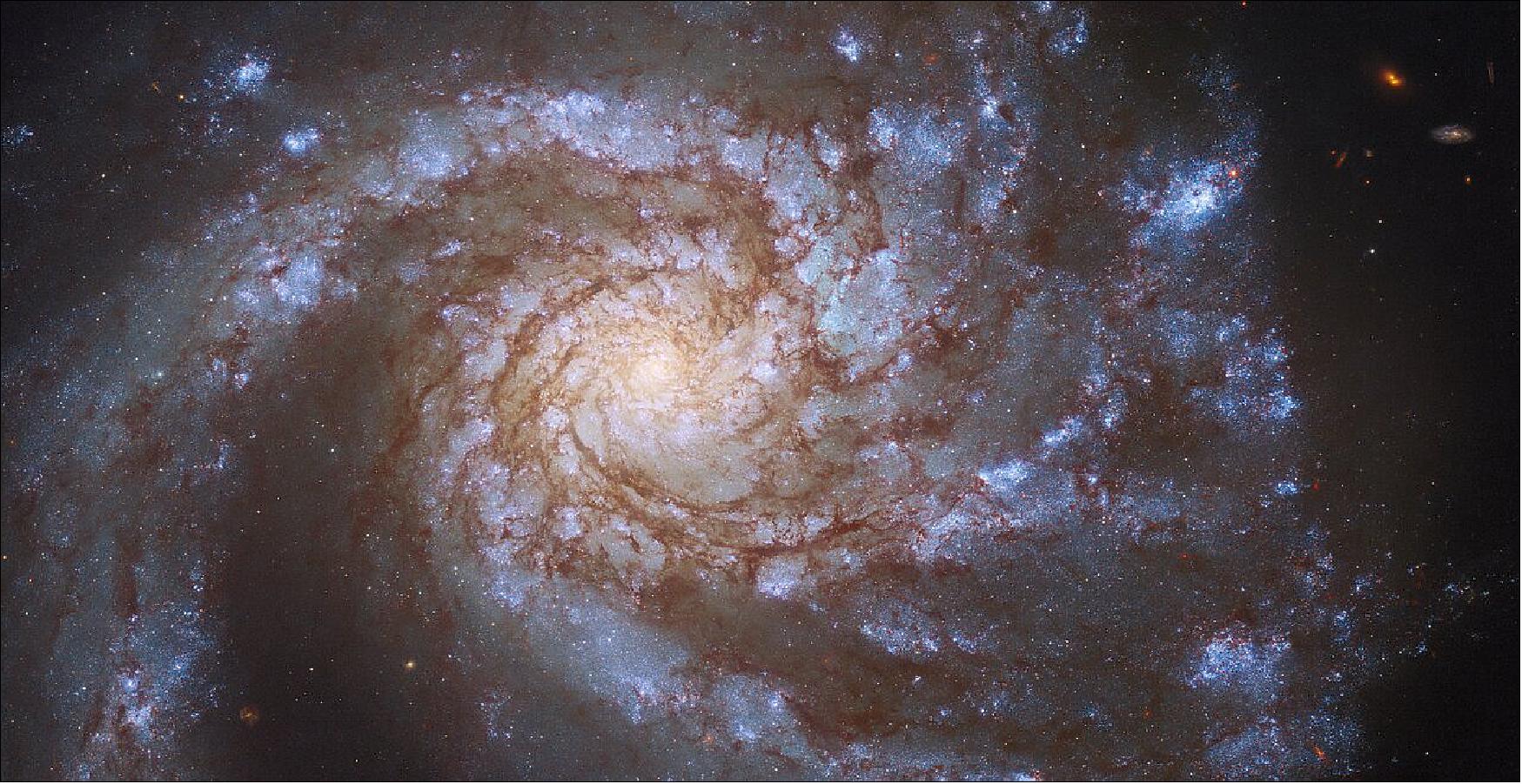
• April 29, 2022: The ultra-diffuse galaxy GAMA 526784 appears as a tenuous patch of light in this image from the NASA/ESA Hubble Space Telescope. This wispy object resides in the constellation Hydra, roughly four billion light-years from Earth. Ultra-diffuse galaxies such as GAMA 526784 have a number of peculiarities. For example, their dark matter content can be either extremely low or extremely high — ultra-diffuse galaxies have been observed with an almost complete lack of dark matter, whereas others consist of almost nothing but dark matter. Another oddity of this class of galaxies is their anomalous abundance of bright globular clusters, something not observed in other types of galaxies. 47)
- Hubble captured GAMA 526784 with the Advanced Camera for Surveys (ACS), which was installed in 2002 by astronauts during Hubble Servicing Mission 3B. Since then, the instrument has played a pivotal role in some of Hubble’s most impressive scientific results, including capturing the Hubble Ultra Deep Field. The ACS has also photographed Pluto in advance of the New Horizon mission, observed gargantuan gravitational lenses and found fully formed galaxies in the early Universe.
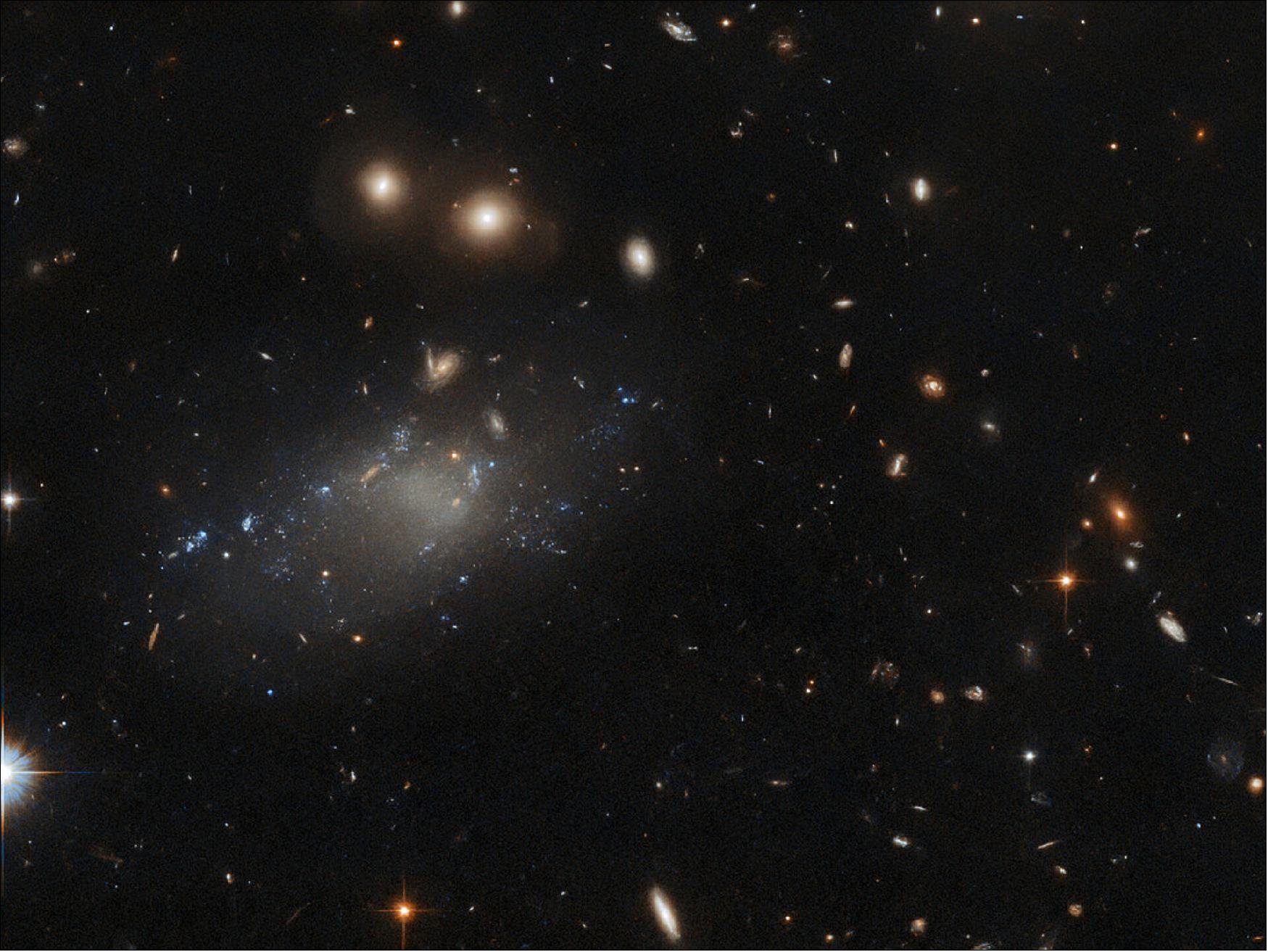
• April 25, 2022: Archival observations of 25 hot Jupiters by the NASA/ESA Hubble Space Telescope have been analysed by an international team of astronomers, enabling them to answer five open questions important to our understanding of exoplanet atmospheres. Amongst other findings, the team found that the presence of metal oxides and hydrides in the hottest exoplanet atmospheres was clearly correlated with the atmospheres' being thermally inverted. 48)
- The field of exoplanet science has long since shifted its focus from just detection onto characterisation [1], although characterisation remains extremely challenging. Thus far, the majority of research into characterisation has been directed towards modelling, or studies focusing on one or a few exoplanets. This new work, led by researchers based at University College London (UCL), used the largest amount of archival data ever examined in a single exoplanet atmosphere survey to analyse the atmospheres of 25 exoplanets. The majority of the data came from observations taken with the NASA/ESA Hubble Space Telescope. The lead author, Quentin Changeat, explains: "Hubble enabled the in-depth characterisation of 25 exoplanets, and the amount of information we learnt about their chemistry and formation — thanks to a decade of intense observing campaigns — is incredible."
- The science team sought to find answers to five open questions about exoplanet atmospheres — an ambitious goal that they succeeded in reaching. Their questions probed what H– [2] and certain metals [3] can tell us about the chemistry and circulation of exoplanet atmospheres, and about planet formation. They chose to investigate a wide range of hot Jupiters [4], with the intention of identifying trends within their sample population that might provide insight into exoplanet atmospheres more generally. The study’s co-leader, Billy Edwards of UCL and the Commissariat à l'énergie atomique et aux énergies alternatives (CEA) said: "Our paper marks a turning point for the field: we are now moving from the characterisation of individual exoplanet atmospheres to the characterisation of atmospheric populations."
- In order to investigate their sample of 25 exoplanets, the team reanalysed an enormous amount of archival data [5], consisting of 600 hours of Hubble observations, which they complemented with more than 400 hours of observations from the Spitzer Space Telescope. Their data contained eclipses for all 25 exoplanets, and transits for 17 of them. An eclipse occurs when an exoplanet passes behind its star as seen from Earth, and a transit occurs when a planet passes in front of its star. Eclipse and transit data can both provide crucial information about an exoplanet’s atmosphere.
- The large-scale survey yielded results, with the team able to identify some clear trends and correlations between the exoplanets’ atmospheric constitutions and observed behaviour. Some of their key findings related to the presence or absence of thermal inversions [6] in the atmospheres of their exoplanet sample. They found that almost all the exoplanets with a thermally inverted atmosphere were extremely hot, with temperatures over 2000 Kelvins. Importantly, this is sufficiently hot that the metallic species TiO (titanium oxide), VO (vanadium oxide) and FeH (iron hydride) are stable in an atmosphere. Of the exoplanets displaying thermal inversions, almost all of them were found to have H–, TiO, VO or FeH in their atmospheres.
- It is always challenging to draw inferences from such results, because correlation does not necessarily equal causation. However, the team were able to propose a compelling argument for why the presence of H–, TiO, VO or FeH might lead to a thermal inversion — namely that all these metallic species are very efficient absorbers of stellar light. It might be that exoplanet atmospheres hot enough to sustain these species tend to be thermally inverted because they then absorb so much stellar light that their upper atmospheres heat up even more. Conversely, the team also found that colder hot Jupiters (with temperatures less than 2000 Kelvins, and thus without H–, TiO, VO or FeH in their atmospheres) almost never had thermally inverted atmospheres.
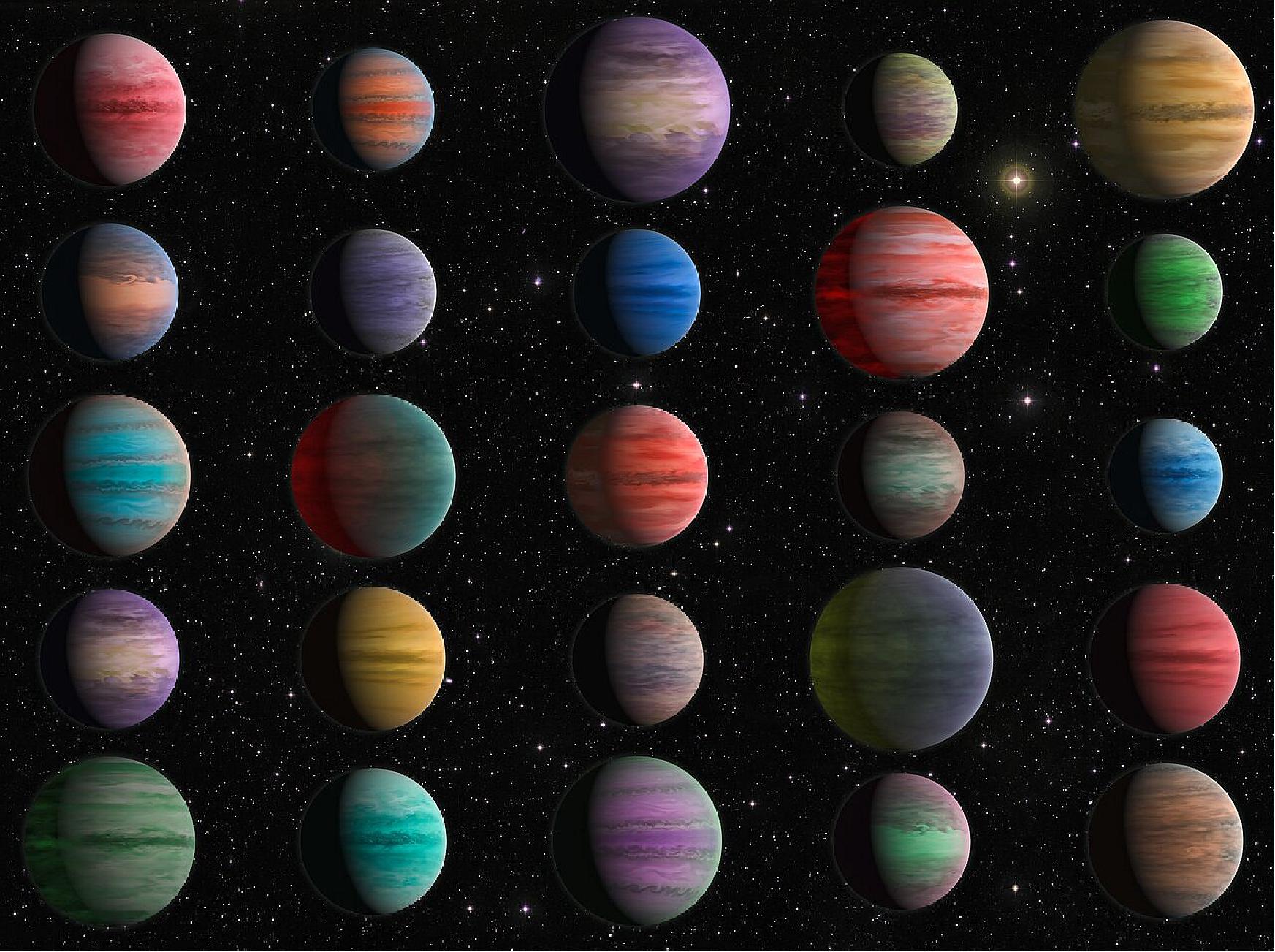
- A significant aspect of this research was that the team were able to use a large sample of exoplanets and an extremely large amount of data to determine trends, which can be used to predict behaviour in other exoplanets. This is extremely useful, because it provides insight into how planets may form, and also because it allows other astronomers to more effectively plan future observations. Conversely, if a paper studies a single exoplanet in great detail, whilst that is valuable it is much harder to extrapolate trends from. An improved understanding of exoplanet populations could also bring us closer to solving open mysteries about our own Solar System. As Changeat says: "Many issues such as the origins of the water on Earth, the formation of the Moon, and the different evolutionary histories of Earth and Mars, are still unsolved despite our ability to obtain in-situ measurements. Large exoplanet population studies, such as the one we present here, aim at understanding those general processes."
• April 22, 2022: Two merging galaxies in the VV689 system — nicknamed the Angel Wing —feature in this image from the NASA/ESA Hubble Space Telescope. Unlike chance alignments of galaxies which only appear to overlap as seen from our vantage point on Earth, the two galaxies in VV689 are in the midst of a collision. The galactic interaction has left the VV689 system almost completely symmetrical, giving the impression of a vast set of galactic wings. 49)
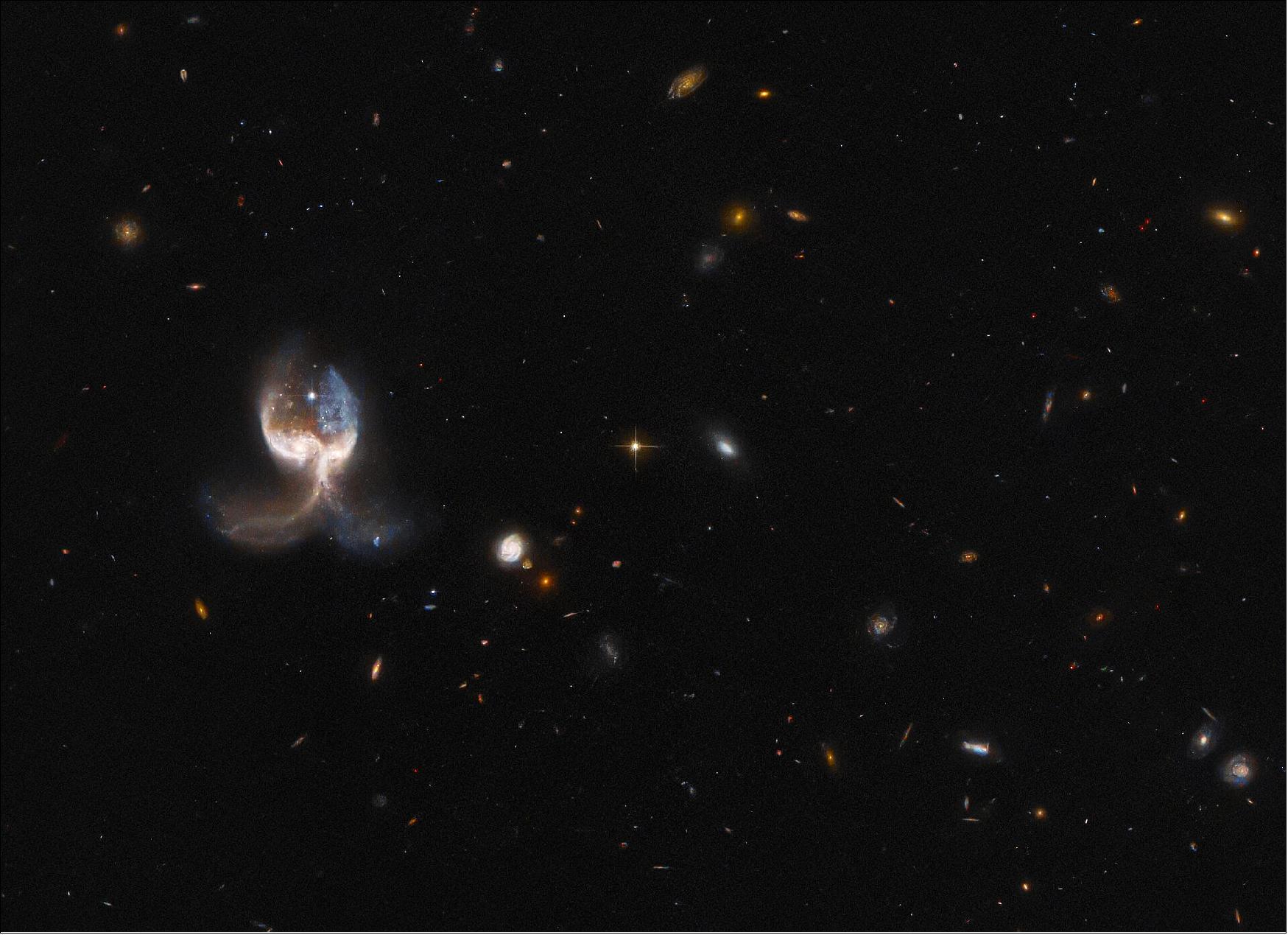
• April 19, 2022: NASA is celebrating the Hubble Space Telescope's 32nd birthday with a stunning look at an unusual close-knit collection of five galaxies, called The Hickson Compact Group 40. 50) 51)
- This menagerie includes three spiral-shaped galaxies, an elliptical galaxy, and a lenticular (lens-like) galaxy. Somehow, these different galaxies crossed paths in their evolution to create an exceptionally crowded and eclectic galaxy sampler.
- Caught in a leisurely gravitational dance, the whole group is so crowded that it could fit within a region of space that is less than twice the diameter of our Milky Way’s stellar disc.
- Though such galaxy groupings can be found in the heart of huge galaxy clusters, these galaxies are notably isolated in their own small patch of the Universe, in the direction of the constellation Hydra.
- One possible explanation is that there's a lot of dark matter (an unknown and invisible form of matter) associated with these galaxies. If they come close together, then the dark matter can form a big cloud within which the galaxies are orbiting. As the galaxies plow through the dark matter they feel a resistive force due to its gravitational effects. This slows their motion and makes the galaxies lose energy, so they fall together.
- Therefore, this snapshot catches the galaxies at a very special moment in their lifetimes. In about 1 billion years they will eventually collide and merge to form a giant elliptical galaxy.
- Astronomers have studied this compact galaxy group not only in visible light, but also in radio, infrared, and X-ray wavelengths. Almost all of them have a compact radio source in their cores, which could be evidence for the presence of supermassive black holes. X-ray observations show that the galaxies have been gravitationally interacting due to the presence of a lot of hot gas among the galaxies. Infrared observations reveal clues to the rate of new star formation.
- Though over 100 such compact galaxy groups have been cataloged in sky surveys going back several decades, Hickson Compact Group 40 is one of the most densely packed. Observations suggest that such tight groups may have been more abundant in the early universe and provided fuel for powering black holes, known as quasars, whose light from superheated infalling material blazed across space. Studying the details of galaxies in nearby groups like this help astronomers sort out when and where galaxies assembled themselves, and what they are assembled from.
- "I remember seeing this on a sky survey and saying, 'wow look at that!'" said Paul Hickson of the University of British Columbia, Vancouver, Canada. "All that I was using at the time was a big plastic ruler and a magnifying glass while looking over sky survey prints." He re-discovered the group by browsing through a collection of peculiar galaxies first published by Halton Arp in 1966.
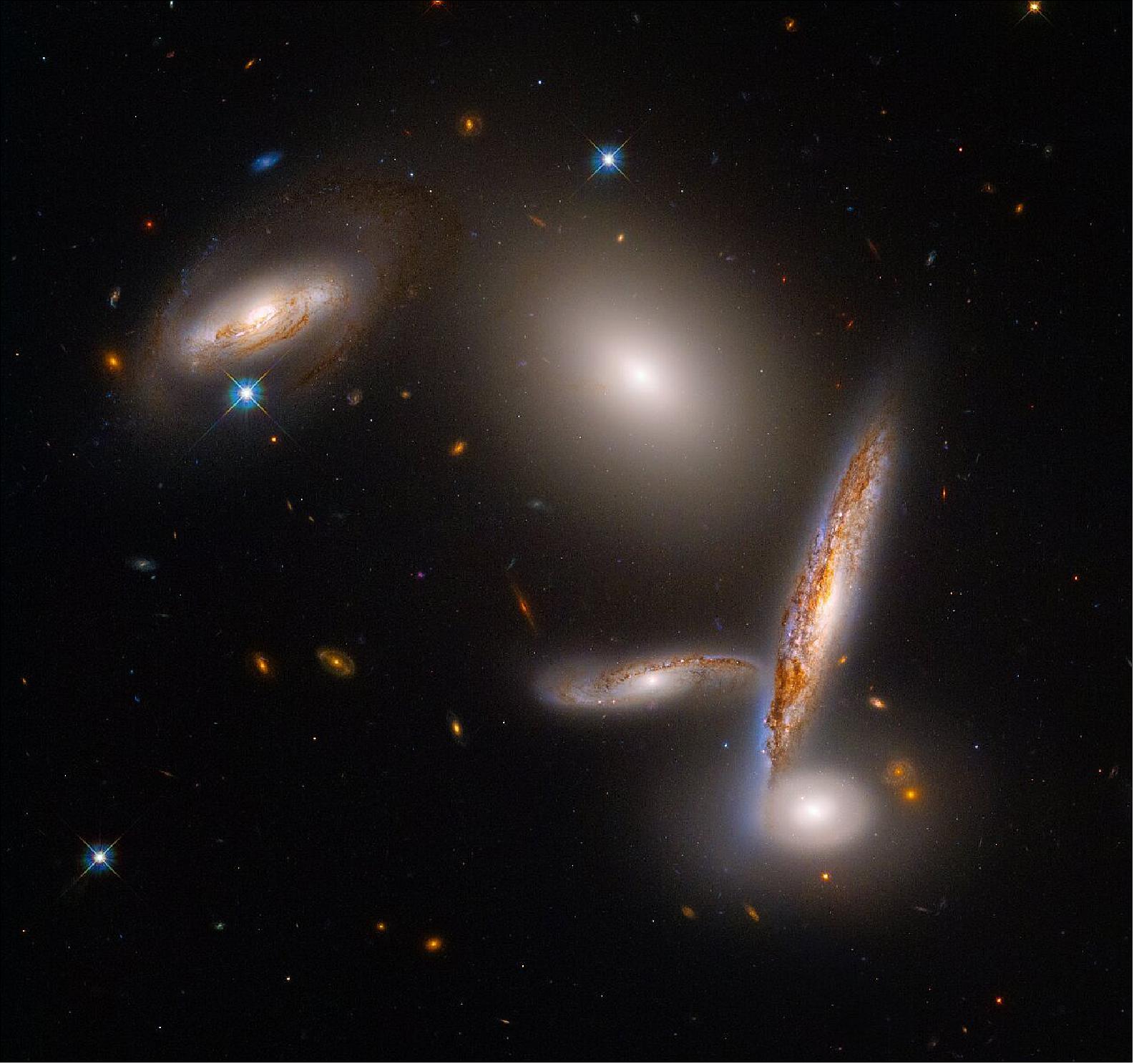
- Hubble was deployed into orbit around Earth by NASA astronauts aboard the space shuttle Discovery, on April 25, 1990. The telescope has taken 1.5 million observations of approximately 50,000 celestial targets to date. This treasure trove of knowledge about the universe is stored for public access in the Mikulski Archive for Space Telescopes, at the Space Telescope Science Institute in Baltimore, Maryland.
- Hubble's unique capabilities in observing visible and ultraviolet light are a critical scientific complement to the infrared-light observations of the recently launched Webb Space Telescope, which will begin science observations this summer.
- The Hubble Space Telescope is a project of international cooperation between NASA and ESA (European Space Agency). NASA's Goddard Space Flight Center in Greenbelt, Maryland, manages the telescope. The Space Telescope Science Institute (STScI) in Baltimore, Maryland, conducts Hubble science operations. STScI is operated for NASA by the Association of Universities for Research in Astronomy, in Washington, D.C.
• April 15, 2022: The spiral galaxy M91 fills the frame of this Wide Field Camera 3 observation from the NASA/ESA Hubble Space Telescope. M91 lies approximately 55 million light-years from Earth in the constellation Coma Berenices and — as is evident in this image — is a barred spiral galaxy. While M91’s prominent bar makes for a spectacular galactic portrait, it also hides an astronomical monstrosity. Like our own galaxy, M91 contains a supermassive black hole at its centre. A 2009 study using archival Hubble data found that this central black hole weighs somewhere between 9.6 and 38 million times as much as the Sun. 52)
- Observing time with Hubble is a highly valued, and much sought-after, resource for astronomers. To obtain data from the telescope, astronomers first have to write a proposal detailing what they want to observe and highlighting the scientific importance of their observations. These proposals are then anonymised and judged on their scientific merit by a variety of astronomical experts. This process is incredibly competitive: following Hubble’s latest call for proposals, only around 13% of the proposals were awarded observing time.
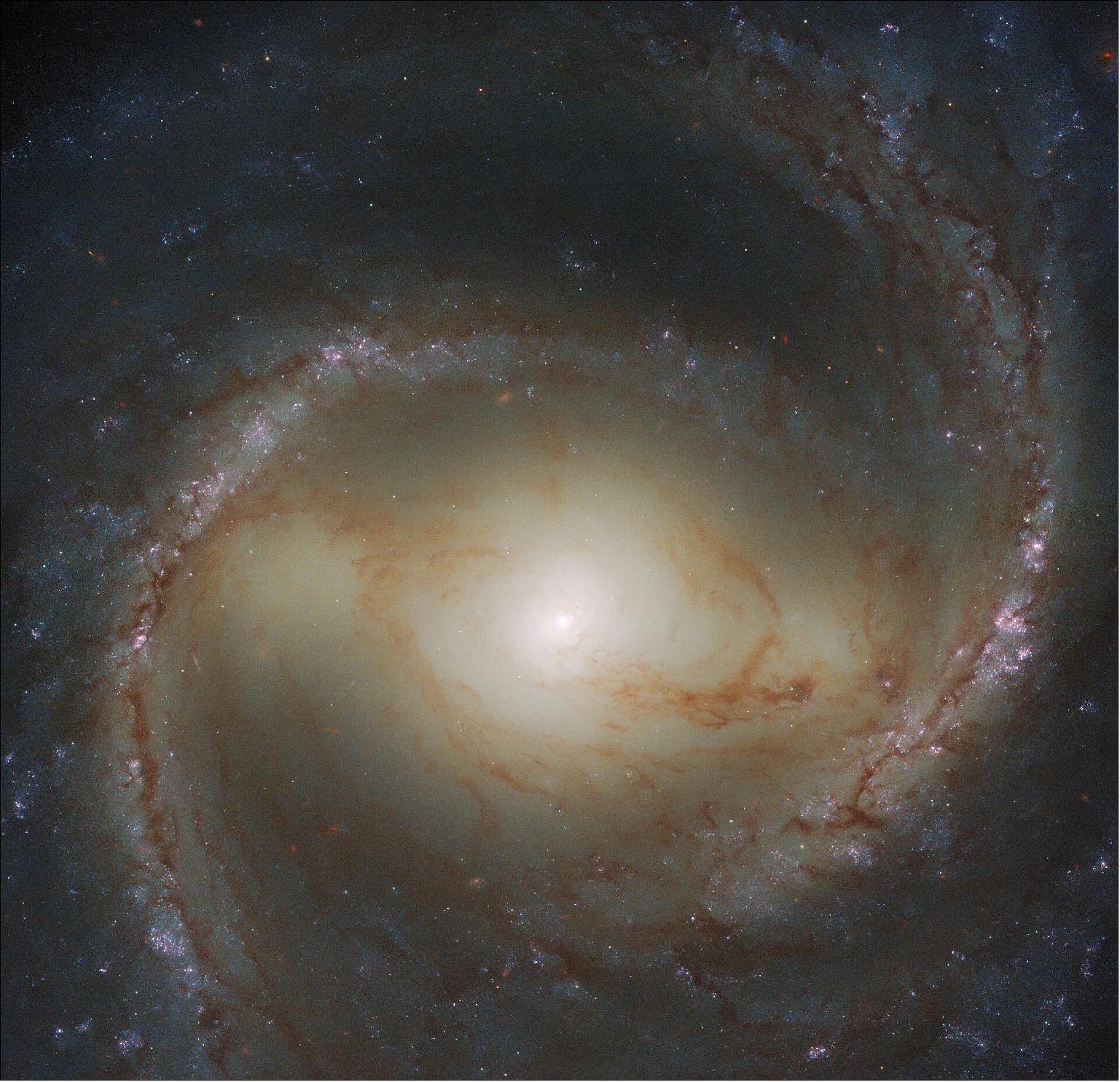
• April 13, 2022: An international team of astronomers using archival data from the NASA/ESA Hubble Space Telescope and other space- and ground-based observatories have discovered a unique object in the distant, early Universe that is a crucial link between star-forming galaxies and the emergence of the earliest supermassive black holes. This object is the first of its kind to be discovered so early in the Universe’s history, and had been lurking unnoticed in one of the best-studied areas of the night sky. 53) 54)
- Astronomers have struggled to understand the emergence of supermassive black holes in the early Universe ever since these objects were discovered at distances corresponding to a time only 750 million years after the Big Bang. Rapidly growing black holes in dusty, early star-forming galaxies are predicted by theories and computer simulations but until now they had not been observed. Now, however, astronomers have reported the discovery of an object — which they name GNz7q — that is believed to be the first such rapidly growing black hole to be found in the early Universe. Archival Hubble data from the Advanced Camera for Surveys helped the team study the compact ultraviolet emission from the black hole's accretion disc and to determine that GNz7q existed just 750 million years after the Big Bang.
- “Our analysis suggests that GNz7q is the first example of a rapidly-growing black hole in the dusty core of a starburst galaxy at an epoch close to the earliest super massive black hole known in the Universe,” explains Seiji Fujimoto, an astronomer at the Niels Bohr Institute of the University of Copenhagen in Denmark and lead author of the paper describing this discovery. “The object’s properties across the electromagnetic spectrum are in excellent agreement with predictions from theoretical simulations.”
- Current theories predict that supermassive black holes begin their lives in the dust-shrouded cores of vigorously star-forming “starburst” galaxies before expelling the surrounding gas and dust and emerging as extremely luminous quasars. Whilst they are extremely rare, examples of both dusty starburst galaxies and luminous quasars have been detected in the early Universe. The team believes that GNz7q could be the “missing link” between these two classes of objects.
- “GNz7q provides a direct connection between these two rare populations and provides a new avenue towards understanding the rapid growth of supermassive black holes in the early days of the Universe,” continued Fujimoto. “Our discovery is a precursor of the supermassive black holes we observe at later epochs.”
- Whilst other interpretations of the team’s data cannot be completely ruled out, the observed properties of GNz7q are in strong agreement with theoretical predictions. GNz7q’s host galaxy is forming stars at the rate of 1600 solar masses of stars per year and GNz7q itself appears bright at ultraviolet wavelengths but very faint at X-ray wavelengths. The team have interpreted this — along with the host galaxy’s brightness at infrared wavelengths — to suggest that GNz7q is harbors a rapidly growing black hole still obscured by the dusty core of its accretion disc at the center of the star-forming host galaxy.
- As well as GNz7q’s importance to the understanding of the origins of supermassive black holes, this discovery is noteworthy for its location in the Hubble GOODS (Great Observatories Origins Deep Survey) North field, one of the most highly scrutinised areas of the night sky.
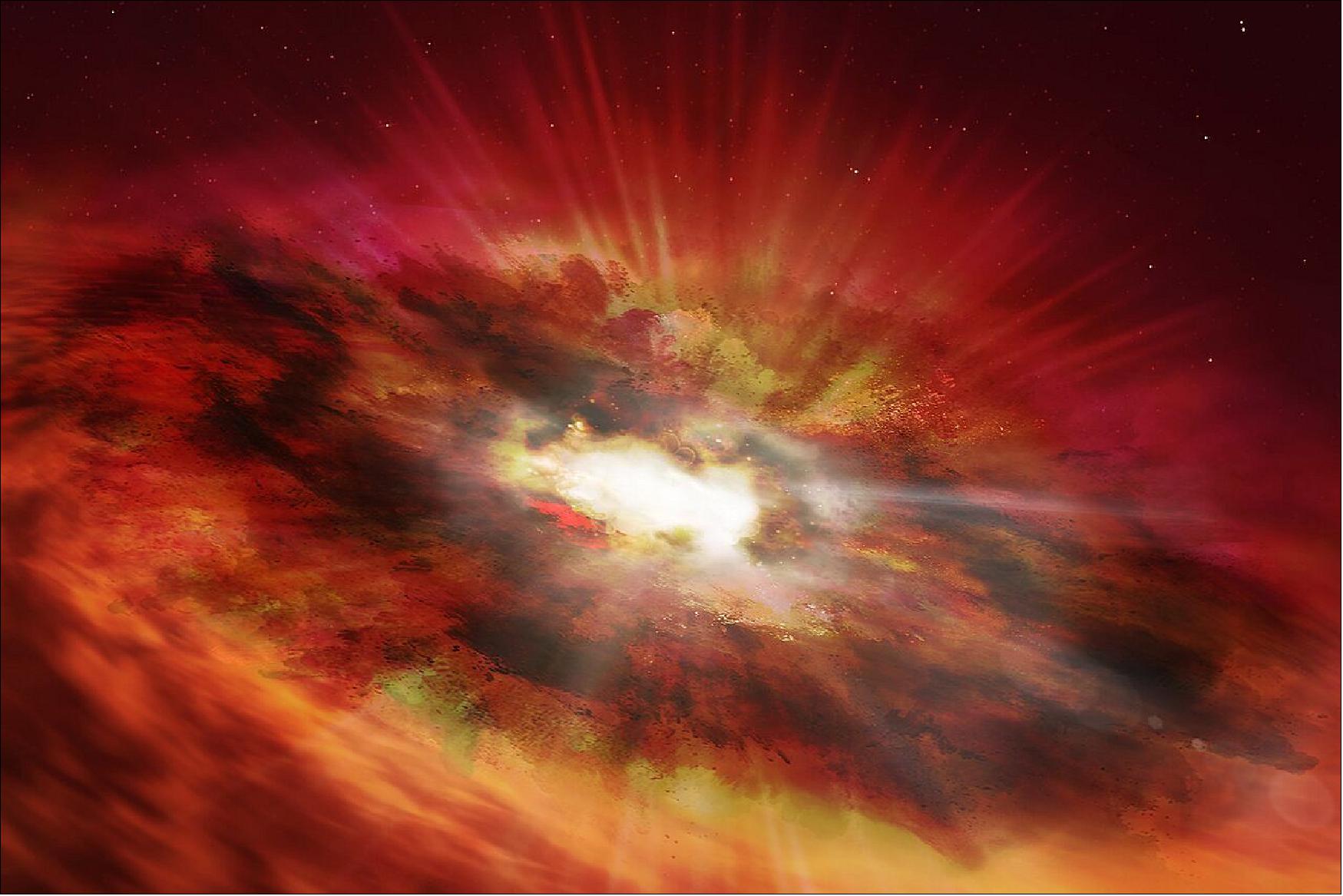
- “GNz7q is a unique discovery that was found just at the centre of a famous, well-studied sky field — showing that big discoveries can often be hidden just in front of you,” commented Gabriel Brammer, another astronomer from the Niels Bohr Institute of the University of Copenhagen and a member of the team behind this result. “It’s unlikely that discovering GNz7q within the relatively small GOODS-N survey area was just ‘dumb luck’ rather the prevalence of such sources may in fact be significantly higher than previously thought.”
- Finding GNz7q hiding in plain sight was only possible thanks to the uniquely detailed, multi-wavelength datasets available for GOODS-North. Without this richness of data GNz7q would have been easy to overlook, as it lacks the distinguishing features usually used to identify quasars in the early Universe. The team now hopes to systematically search for similar objects using dedicated high-resolution surveys and to take advantage of the NASA/ESA/CSA James Webb Space Telescope's spectroscopic instruments to study objects such as GNz7q in unprecedented detail.
- “Fully characterising these objects and probing their evolution and underlying physics in much greater detail will become possible with the James Webb Space Telescope.” concluded Fujimoto. “Once in regular operation, Webb will have the power to decisively determine how common these rapidly growing black holes truly are.”
![Figure 55: An international team of astronomers using archival data from the NASA/ESA Hubble Space Telescope and other space- and ground-based observatories have discovered a unique object in the distant, early Universe that is a crucial link between young star-forming galaxies and the earliest supermassive black holes. This object is the first of its kind to be discovered so early in the Universe’s history, and had been lurking unnoticed in one of the best-studied areas of the night sky. The object, which is referred to as GNz7q, is shown here in the centre of the image of the Hubble GOODS-North field [image credit: NASA, ESA, G. Illingworth (University of California, Santa Cruz), P. Oesch (University of California, Santa Cruz; Yale University), R. Bouwens and I. Labbé (Leiden University), and the Science Team]](https://www.eoportal.org/ftp/satellite-missions/h/Hubble_220722/Hubble_Auto1D.jpeg)
• April 12, 2022: NASA's Hubble Space Telescope has determined the size of the largest icy comet nucleus ever seen by astronomers. The estimated diameter is approximately 80 miles across, making it larger than the state of Rhode Island. The nucleus is about 50 times larger than found at the heart of most known comets. Its mass is estimated to be a staggering 500 trillion tons, a hundred thousand times greater than the mass of a typical comet found much closer to the Sun. 55) 56)
![Figure 56: This sequence shows how the nucleus of Comet C/2014 UN271 (Bernardinelli-Bernstein) was isolated from a vast shell of dust and gas surrounding the solid icy nucleus. On the left is a photo of the comet taken by the NASA Hubble Space Telescope's Wide Field Camera 3 on January 8, 2022. A model of the coma (middle panel) was obtained by means of fitting the surface brightness profile assembled from the observed image on the left. This allowed for the coma to be subtracted, unveiling the point-like glow from the nucleus. Combined with radio telescope data, astronomers arrived at a precise measurement of the nucleus size. That's no small feat from something about 2 billion miles away. Though the nucleus is estimated to be as large as 85 miles across, it is so far away it cannot be resolved by Hubble. Its size is derived from its reflectivity as measured by Hubble. The nucleus is estimated to be as black as charcoal. The nucleus area is gleaned from radio observations [Credits: SCIENCE: NASA, ESA, Man-To Hui (Macau University of Science and Technology), David Jewitt (UCLA) Image Processing: Alyssa Pagan (STScI)]](https://www.eoportal.org/ftp/satellite-missions/h/Hubble_220722/Hubble_Auto1C.jpeg)
- The behemoth comet, C/2014 UN271 (Bernardinelli-Bernstein) is barreling this way at 22,000 miles per hour from the edge of the solar system. But not to worry. It will never get closer than 1 billion miles away from the Sun, which is slightly farther than the distance of the planet Saturn. And that won't be until the year 2031.
- The previous record holder is comet C/2002 VQ94, with a nucleus estimated to be 60 miles across. It was discovered in 2002 by the Lincoln Near-Earth Asteroid Research (LINEAR) project.
- "This comet is literally the tip of the iceberg for many thousands of comets that are too faint to see in the more distant parts of the solar system," said David Jewitt, a professor of planetary science and astronomy at the University of California, Los Angeles (UCLA), and co-author of the new study in The Astrophysical Journal Letters. "We've always suspected this comet had to be big because it is so bright at such a large distance. Now we confirm it is." 57)
- Comet C/2014 UN271 was discovered by astronomers Pedro Bernardinelli and Gary Bernstein in archival images from the Dark Energy Survey at the Cerro Tololo Inter-American Observatory in Chile. It was first serendipitously observed in November 2010, when it was a whopping 3 billion miles from the Sun, which is nearly the average distance to Neptune. Since then, it has been intensively studied by ground- and space-based telescopes.
- "This is an amazing object, given how active it is when it's still so far from the Sun," said the paper's lead author Man-To Hui of the Macau University of Science and Technology, Taipa, Macau. "We guessed the comet might be pretty big, but we needed the best data to confirm this." So, his team used Hubble to take five photos of the comet on January 8, 2022.
- The challenge in measuring this comet was how to discriminate the solid nucleus from the huge dusty coma enveloping it. The comet is currently too far away for its nucleus to be visually resolved by Hubble. Instead, the Hubble data show a bright spike of light at the nucleus' location. Hui and his team next made a computer model of the surrounding coma and adjusted it to fit the Hubble images. Then, the glow of the coma was subtracted to leave behind the starlike nucleus.
- Hui and his team compared the brightness of the nucleus to earlier radio observations from the Atacama Large Millimeter/submillimeter Array (ALMA) in Chile. This combined data constrains the diameter and the reflectivity of the nucleus. The new Hubble measurements are close to the earlier size estimates from ALMA, but convincingly suggest a darker nucleus surface than previously thought. "It's big and it's blacker than coal," said Jewitt.
![Figure 57: This diagram compares the size of the icy, solid nucleus of comet C/2014 UN271 (Bernardinelli-Bernstein) to several other comets. The majority of comet nuclei observed are smaller than Halley’s comet. They are typically a mile across or less. Comet C/2014 UN271 is currently the record-holder for big comets. And, it may be just the tip of the iceberg. There could be many more monsters out there for astronomers to identify as sky surveys improve in sensitivity. Though astronomers know this comet must be big to be detected so far out to a distance of over 2 billion miles from Earth, only the Hubble Space Telescope has the sharpness and sensitivity to make a definitive estimate of nucleus size [image credits: Illustration: NASA, ESA, Zena Levy (STScI)]](https://www.eoportal.org/ftp/satellite-missions/h/Hubble_220722/Hubble_Auto1B.jpeg)
- The comet has been falling toward the Sun for well over 1 million years. It is coming from the hypothesized nesting ground of trillions of comets, called the Oort Cloud. The diffuse cloud is thought to have an inner edge at 2,000 to 5,000 times the distance between the Sun and the Earth. Its outer edge might extend at least a quarter of the way out to the distance of the nearest stars to our Sun, the Alpha Centauri system.
- The Oort Cloud's comets didn't actually form so far from the Sun; instead, they were tossed out of the solar system billions of years ago by a gravitational "pinball game" among the massive outer planets, when the orbits of Jupiter and Saturn were still evolving. The far-flung comets only travel back toward the Sun and planets if their distant orbits are disturbed by the gravitational tug of a passing star — like shaking apples out of a tree.
- Comet Bernardinelli-Bernstein follows a 3-million-year-long elliptical orbit, taking it as far from the Sun as roughly half a light-year. The comet is now less than 2 billion miles from the Sun, falling nearly perpendicular to the plane of our solar system. At that distance temperatures are only about minus 348 degrees Fahrenheit. Yet that's warm enough for carbon monoxide to sublimate off the surface to produce the dusty coma.
- Comet Bernardinelli-Bernstein provides an invaluable clue to the size distribution of comets in the Oort Cloud and hence its total mass. Estimates for the Oort Cloud's mass vary widely, reaching as high as 20 times Earth's mass.
- First hypothesized in 1950 by Dutch astronomer Jan Oort, the Oort Cloud still remains a theory because the innumerable comets that make it up are too faint and distant to be directly observed. Ironically, this means the solar system's largest structure is all but invisible. It's estimated that NASA's pair of Voyager spacecraft won't reach the inner realm of the Oort Cloud for another 300 years and could take as long as 30,000 years to pass through it.
- Circumstantial evidence come from infalling comets that can be traced back to this nesting ground. They approach the Sun from all different directions meaning the cloud must be spherical in shape. These comets are deep-freeze samples of the composition of the early solar system, preserved for billions of years. The reality of the Oort Cloud is bolstered by theoretical modeling of the formation and evolution of the solar system. The more observational evidence that can be gathered through deep sky surveys coupled with multiwavelength observations, the better astronomers will understand the Oort Cloud's role in the solar system's evolution.
- The Hubble Space Telescope is a project of international cooperation between NASA and ESA (European Space Agency). NASA's Goddard Space Flight Center in Greenbelt, Maryland, manages the telescope. The Space Telescope Science Institute (STScI) in Baltimore, Maryland, conducts Hubble science operations. STScI is operated for NASA by the Association of Universities for Research in Astronomy, in Washington, D.C.
• April 8, 2022: The lazily winding spiral arms of the galaxy NGC 5921 snake across this image from the NASA/ESA Hubble Space Telescope. This galaxy lies approximately 80 million light-years from Earth, and much like our own galaxy, the Milky Way, contains a prominent bar. Roughly half of all spiral galaxies are thought to contain bars, and these bars affect their parent galaxies by fuelling star formation and affecting the motion of stars and interstellar gas. 58)
- Appropriately, given NGC 5921’s serpentine spiral arms, this galaxy resides in the constellation Serpens in the northern celestial hemisphere. Serpens is the only one of the 88 modern constellations to consist of two unconnected regions — Serpens Caput and Serpens Cauda. These two regions — whose names mean the Serpent’s Head and the Serpent’s Tail, respectively — are separated by Ophiuchus, the Serpent Bearer.
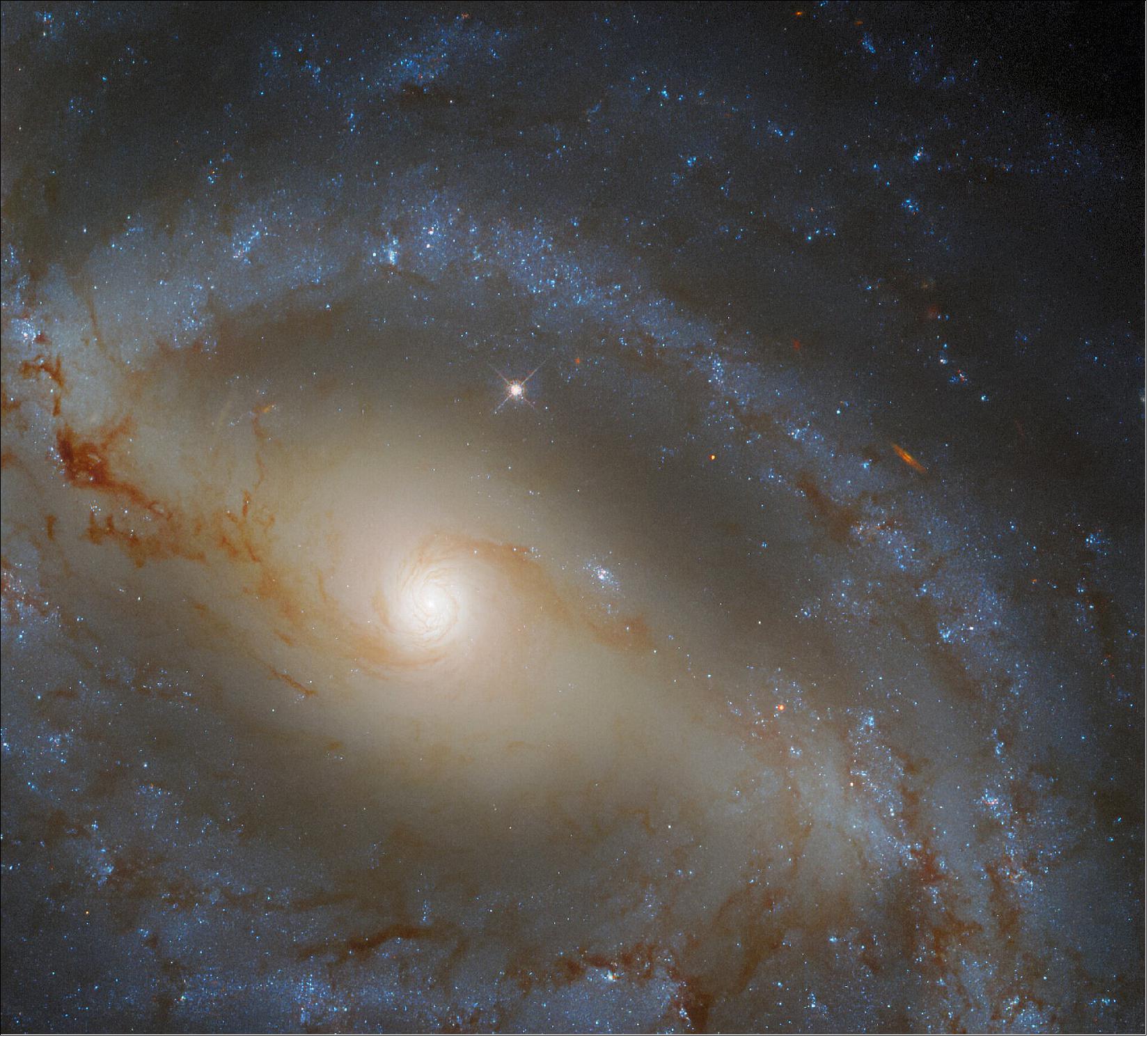
• April 6, 2022: In studying a unique class of ultra-hot exoplanets, NASA Hubble Space Telescope astronomers may be in the mood for dancing to the Calypso party song "Hot, Hot, Hot." That's because these bloated Jupiter-sized worlds are so precariously close to their parent star they are being roasted at seething temperatures above 3,000 degrees Fahrenheit. That's hot enough to vaporize most metals, including titanium. They have the hottest planetary atmospheres ever seen. 59)
- In two new papers, teams of Hubble astronomers are reporting on bizarre weather conditions on these sizzling worlds. It's raining vaporized rock on one planet, and another one has its upper atmosphere getting hotter rather than cooler because it is being "sunburned" by intense ultraviolet (UV) radiation from its star.
- This research goes beyond simply finding weird and quirky planet atmospheres. Studying extreme weather gives astronomers better insights into the diversity, complexity, and exotic chemistry taking place in far-flung worlds across our galaxy.
- "We still don't have a good understanding of weather in different planetary environments," said David Sing of the Johns Hopkins University in Baltimore, Maryland, co-author on the two studies being reported. "When you look at Earth, all our weather predictions are still finely tuned to what we can measure. But when you go to a distant exoplanet, you have limited predictive powers because you haven't built a general theory about how everything in an atmosphere goes together and responds to extreme conditions. Even though you know the basic chemistry and physics, you don't know how it's going to manifest in complex ways."
- In a paper in the April 6 journal Nature, astronomers describe Hubble observations of WASP-178b, located about 1,300 light-years away. On the daytime side the atmosphere is cloudless, and is enriched in silicon monoxide gas. Because one side of the planet permanently faces its star, the torrid atmosphere whips around to the nighttime side at super-hurricane speeds exceeding 2,000 miles per hour. On the dark side, the silicon monoxide may cool enough to condense into rock that rains out of clouds, but even at dawn and dusk, the planet is hot enough to vaporize rock. "We knew we had seen something really interesting with this silicon monoxide feature," said Josh Lothringer of the Utah Valley University in Orem, Utah. 60)
- In a paper published in the Jan. 24 issue of Astrophysical Journal Letters, Guangwei Fu of the University of Maryland, College Park, reported on a super-hot Jupiter, KELT-20b, located about 400 light-years away. On this planet a blast of ultraviolet light from its parent star is creating a thermal layer in the atmosphere, much like Earth's stratosphere. "Until now we never knew how the host star affected a planet's atmosphere directly. There have been lots of theories, but now we have the first observational data," Fu said. 61)
- By comparison, on Earth, ozone in the atmosphere absorbs UV light and raises temperatures in a layer between seven to 31 miles above Earth's surface. On KELT-20b the UV radiation from the star is heating metals in the atmosphere which makes for a very strong thermal inversion layer.
- Evidence came from Hubble's detection of water in near-infrared observations, and from NASA's Spitzer Space Telescope's detection of carbon monoxide. They radiate through the hot, transparent upper atmosphere that is produced by the inversion layer. This signature is unique from what astronomers see in the atmospheres of hot-Jupiters orbiting cooler stars, like the Sun. "The emission spectrum for KELT-20b is quite different from other hot-Jupiters," said Fu. "This is compelling evidence that planets don't live in isolation but are affected by their host star."
- Though super-hot Jupiters are uninhabitable, this kind of research helps pave the way to better understanding the atmospheres of potentially inhabitable terrestrial planets. "If we can't figure out what's happening on super-hot Jupiters where we have reliable solid observational data, we're not going to have a chance to figure out what's happening in weaker spectra from observing terrestrial exoplanets," said Lothringer. "This is a test of our techniques that allows us to build a general understanding of physical properties such as cloud formation and atmospheric structure."
- The Hubble Space Telescope is a project of international cooperation between NASA and ESA (European Space Agency). NASA's Goddard Space Flight Center in Greenbelt, Maryland, manages the telescope. The Space Telescope Science Institute (STScI) in Baltimore, Maryland, conducts Hubble science operations. STScI is operated for NASA by the Association of Universities for Research in Astronomy in Washington, D.C.
![Figure 60: This is an artist's illustration of the planet KELT-20b which orbits a blue-white star. The giant planet is so close to its star (5 million miles) the torrent of ultraviolet radiation from the star heats the planet's atmosphere to over 3,000 degrees Fahrenheit. This creates a thermal layer where the atmosphere increases in temperature with altitude. This is the best evidence to date – gleaned from the Hubble Space Telescope – for a host star affecting a planet's atmosphere directly. The seething planet is 456 light-years away [image credit: ARTWORK: NASA, ESA, Leah Hustak (STScI)]](https://www.eoportal.org/ftp/satellite-missions/h/Hubble_220722/Hubble_Auto19.jpeg)
• April 4, 2022: NASA's Hubble Space Telescope has directly photographed evidence of a Jupiter-like protoplanet forming through what researchers describe as an "intense and violent process." This discovery supports a long-debated theory for how planets like Jupiter form, called "disk instability." 62) 63)
- The new world under construction is embedded in a protoplanetary disk of dust and gas with distinct spiral structure swirling around, surrounding a young star that's estimated to be around 2 million years old. That's about the age of our solar system when planet formation was underway. (The solar system's age is currently 4.6 billion years.)
- "Nature is clever; it can produce planets in a range of different ways," said Thayne Currie of the Subaru Telescope and Eureka Scientific, lead researcher on the study.
- All planets are made from material that originated in a circumstellar disk. The dominant theory for jovian planet formation is called "core accretion," a bottom-up approach where planets embedded in the disk grow from small objects — with sizes ranging from dust grains to boulders — colliding and sticking together as they orbit a star. This core then slowly accumulates gas from the disk. In contrast, the disk instability approach is a top-down model where as a massive disk around a star cools, gravity causes the disk to rapidly break up into one or more planet-mass fragments.
- The newly forming planet, called AB Aurigae b, is probably about nine times more massive than Jupiter and orbits its host star at a whopping distance of 8.6 billion miles – over two times farther than Pluto is from our Sun. At that distance it would take a very long time, if ever, for a Jupiter-sized planet to form by core accretion. This leads researchers to conclude that the disk instability has enabled this planet to form at such a great distance. And, it is in a striking contrast to expectations of planet formation by the widely accepted core accretion model.
- The new analysis combines data from two Hubble instruments: the Space Telescope Imaging Spectrograph and the Near Infrared Camera and Multi-Object Spectrograph. These data were compared to those from a state-of-the-art planet imaging instrument called SCExAO on Japan's 8.2-meter Subaru Telescope located at the summit of Mauna Kea, Hawaii. The wealth of data from space and ground-based telescopes proved critical, because distinguishing between infant planets and complex disk features unrelated to planets is very difficult.
- "Interpreting this system is extremely challenging," Currie said. "This is one of the reasons why we needed Hubble for this project—a clean image to better separate the light from the disk and any planet."
- Nature itself also provided a helping hand: the vast disk of dust and gas swirling around the star AB Aurigae is tilted nearly face-on to our view from Earth.
- Currie emphasized that Hubble's longevity played a particular role in helping researchers measure the protoplanet's orbit. He was originally very skeptical that AB Aurigae b was a planet. The archival data from Hubble, combined with imaging from Subaru, proved to be a turning point in changing his mind.
![Figure 61: This is an artist's illustration of a massive, newly forming exoplanet called AB Aurigae b. Researchers used new and archival data from the Hubble Space Telescope and the Subaru Telescope to confirm this protoplanet is forming through an intense and violent process, called disk instability. Disk instability is a top-down approach, much different from the dominant core accretion model. In this scenario, a massive disk around a star cools, and gravity causes the disk to rapidly break up into one or more planet-mass fragments. — AB Aurigae b is estimated to be about nine times more massive than Jupiter and orbits its host star over two times farther than Pluto is from our Sun [image credits: ARTWORK: NASA, ESA, Joseph Olmsted (STScI)]](https://www.eoportal.org/ftp/satellite-missions/h/Hubble_220722/Hubble_Auto18.jpeg)
- "We could not detect this motion on the order of a year or two years," Currie said. "Hubble provided a time baseline, combined with Subaru data, of 13 years, which was sufficient to be able to detect orbital motion."
- "This result leverages ground and space observations and we get to go back in time with Hubble archival observations," Olivier Guyon of the University of Arizona, Tucson, and Subaru Telescope, Hawaii added. "AB Aurigae b has now been looked at in multiple wavelengths, and a consistent picture has emerged—one that's very solid."
- The team's results are published in the April 4 issue of Nature Astronomy. 64)
- "This new discovery is strong evidence that some gas giant planets can form by the disk instability mechanism," Alan Boss of the Carnegie Institution of Science in Washington, D.C. emphasized. "In the end, gravity is all that counts, as the leftovers of the star-formation process will end up being pulled together by gravity to form planets, one way or the other."
- Understanding the early days of the formation of Jupiter-like planets provides astronomers with more context into the history of our own solar system. This discovery paves the way for future studies of the chemical make-up of protoplanetary disks like AB Aurigae, including with NASA's James Webb Space Telescope.
- The Hubble Space Telescope is a project of international cooperation between NASA and ESA (European Space Agency). NASA's Goddard Space Flight Center in Greenbelt, Maryland, manages the telescope. The Space Telescope Science Institute (STScI) in Baltimore, Maryland, conducts Hubble science operations. STScI is operated for NASA by the Association of Universities for Research in Astronomy, in Washington, D.C.
![Figure 62: Researchers were able to directly image newly forming exoplanet AB Aurigae b over a 13-year span using Hubble's Space Telescope Imaging Spectrograph (STIS) and its Near Infrared Camera and Multi-Object Spectrograph (NICMOS). - In the top right, Hubble's NICMOS image captured in 2007 shows AB Aurigae b in a due south position compared to its host star, which is covered by the instrument's coronagraph. The image captured in 2021 by STIS shows the protoplanet has moved in a counterclockwise motion over time [Credits: SCIENCE: NASA, ESA, Thayne Currie (Subaru Telescope, Eureka Scientific Inc.), IMAGE PROCESSING: Thayne Currie (Subaru Telescope, Eureka Scientific Inc.), Alyssa Pagan (STScI)]](https://www.eoportal.org/ftp/satellite-missions/h/Hubble_220722/Hubble_Auto17.jpeg)
• April 01, 2022: Tendrils of dark dust can be seen threading across the heart of the spiral galaxy NGC 7172 in this image from the NASA/ESA Hubble Space Telescope. The galaxy lies approximately 110 million light-years from Earth in the constellation Piscis Austrinus. The lane of dust threading its way across NGC 7172 — which is viewed side-on in this image — is obscuring the luminous heart of the galaxy, making NGC 7172 appear to be nothing more than a normal edge-on spiral galaxy. 65)
- When astronomers inspected NGC 7172 across the electromagnetic spectrum they quickly discovered that there was more to it than meets the eye: NGC 7172 is a Seyfert galaxy — a type of galaxy with an intensely luminous active galactic nucleus powered by matter accreting onto a supermassive black hole.
![Figure 63: This image combines data from two sets of Hubble observations, both of which were proposed to study nearby active galactic nuclei. The image also combines data from two instruments — Hubble’s Advanced Camera for Surveys (ACS) and Wide Field Camera 3 (WFCS), [image credit: ESA/Hubble & NASA, D. J. Rosario, A. Barth; CC BY 4.0 Acknowledgement: L. Shatz]](https://www.eoportal.org/ftp/satellite-missions/h/Hubble_220722/Hubble_Auto16.jpeg)
• March 30, 2022: A lucky cosmic alignment has revealed a single source of light in the first billion years after the big bang, setting up a major confirmation for the James Webb Space Telescope in its rookie year. 66) 67)
- Even NASA's powerful Hubble Space Telescope can benefit from some assistance, as evidenced in its latest discovery: a record-breaking star so distant that a combination of the telescope's sophisticated instrumentation and nature's natural magnifying glass was needed to spot it. The star, nicknamed Earendel by astronomers, emitted its light within the universe's first billion years. It's a significant leap beyond Hubble's previous distance record, in 2018, when it detected a star at around 4 billion years after the big bang. Hubble got a boost by looking through space warped by the mass of the huge galaxy cluster WHL0137-08, an effect called gravitational lensing. Earendel was aligned on or very near a ripple in the fabric of space created by the cluster's mass, which magnified its light enough to be detected by Hubble. NASA's James Webb Telescope will follow-up to learn about Earendel's brightness, temperature, and composition. While the chances are slim that Earendel is one of the universe's first-generation stars, astronomers are eager for its insights into the environment of the early universe.
- NASA's Hubble Space Telescope has established an extraordinary new benchmark: detecting the light of a star that existed within the first billion years after the universe's birth in the big bang—the farthest individual star ever seen to date.
- The find is a huge leap further back in time from the previous single-star record holder; detected by Hubble in 2018. That star existed when the universe was about 4 billion years old, or 30 percent of its current age, at a time that astronomers refer to as "redshift 1.5." Scientists use the word "redshift" because as the universe expands, light from distant objects is stretched or "shifted" to longer, redder wavelengths as it travels toward us.
- The newly detected star is so far away that its light has taken 12.9 billion years to reach Earth, appearing to us as it did when the universe was only 7 percent of its current age, at redshift 6.2. The smallest objects previously seen at such a great distance are clusters of stars, embedded inside early galaxies.
- "We almost didn't believe it at first, it was so much farther than the previous most-distant, highest redshift star," said astronomer Brian Welch of the Johns Hopkins University in Baltimore, lead author of the paper describing the discovery, which is published in the March 30 journal Nature. The discovery was made from data collected during Hubble's RELICS (Reionization Lensing Cluster Survey) program, led by co-author Dan Coe at the Space Telescope Science Institute (STScI), also in Baltimore. 68)
- "Normally at these distances, entire galaxies look like small smudges, with the light from millions of stars blending together," said Welch. "The galaxy hosting this star has been magnified and distorted by gravitational lensing into a long crescent that we named the Sunrise Arc."
![Figure 64: The Sunrise Arc Galaxy With Lensed Star Earendel. The star nicknamed Earendel (indicated with arrow) is positioned along a ripple in spacetime that gives it extreme magnification, allowing it to emerge into view from its host galaxy, which appears as a red smear across the sky. The whole scene is viewed through the distorted lens created by a massive galaxy cluster in the intervening space, which allows the galaxy's features to be seen, but also warps their appearance—an effect astronomers call gravitational lensing. The red dots on either side of Earendel are one star cluster that is mirrored on either side of the ripple, a result of the gravitational lensing distortion. The entire galaxy, called the Sunrise Arc, appears three times, and knots along its length are more mirrored star clusters. Earendel's unique position right along the line of most extreme magnification allows it to be detected, even though it is not a cluster [Credits: SCIENCE: NASA, ESA, Brian Welch (JHU), Dan Coe (STScI), IMAGE PROCESSING: NASA, ESA, Alyssa Pagan (STScI)]](https://www.eoportal.org/ftp/satellite-missions/h/Hubble_220722/Hubble_Auto15.jpeg)
- After studying the galaxy in detail, Welch determined that one feature is an extremely magnified star that he called Earendel, which means "morning star" in Old English. The discovery holds promise for opening up an uncharted era of very early star formation.
- "Earendel existed so long ago that it may not have had all the same raw materials as the stars around us today," Welch explained. "Studying Earendel will be a window into an era of the universe that we are unfamiliar with, but that led to everything we do know. It's like we've been reading a really interesting book, but we started with the second chapter, and now we will have a chance to see how it all got started," Welch said.
When Stars Align
- The research team estimates that Earendel is at least 50 times the mass of our Sun and millions of times as bright, rivaling the most massive stars known. But even such a brilliant, very high-mass star would be impossible to see at such a great distance without the aid of natural magnification by a huge galaxy cluster, WHL0137-08, sitting between us and Earendel. The mass of the galaxy cluster warps the fabric of space, creating a powerful natural magnifying glass that distorts and greatly amplifies the light from distant objects behind it.
- Thanks to the rare alignment with the magnifying galaxy cluster, the star Earendel appears directly on, or extremely close to, a ripple in the fabric of space. This ripple, which is defined in optics as a "caustic," provides maximum magnification and brightening. The effect is analogous to the rippled surface of a swimming pool creating patterns of bright light on the bottom of the pool on a sunny day. The ripples on the surface act as lenses and focus sunlight to maximum brightness on the pool's floor.
- This caustic causes the star Earendel to pop out from the general glow of its home galaxy. Its brightness is magnified a thousandfold or more. At this point, astronomers are not able to determine if Earendel is a binary star, though most massive stars have at least one smaller companion star.
Confirmation with Webb
- Astronomers expect that Earendel will remain highly magnified for years to come. It will be observed by NASA's James Webb Space Telescope. Webb's high sensitivity to infrared light is needed to learn more about Earendel, because its light is stretched (redshifted) to longer infrared wavelengths due to the universe's expansion.
- "With Webb we expect to confirm Earendel is indeed a star, as well as measure its brightness and temperature," Coe said. These details will narrow down its type and stage in the stellar lifecycle. "We also expect to find the Sunrise Arc galaxy is lacking in heavy elements that form in subsequent generations of stars. This would suggest Earendel is a rare, massive metal-poor star," Coe said.
- Earendel's composition will be of great interest for astronomers, because it formed before the universe was filled with the heavy elements produced by successive generations of massive stars. If follow-up studies find that Earendel is only made up of primordial hydrogen and helium, it would be the first evidence for the legendary Population III stars, which are hypothesized to be the very first stars born after the big bang. While the probability is small, Welch admits it is enticing all the same.
- "With Webb, we may see stars even farther than Earendel, which would be incredibly exciting," Welch said. "We'll go as far back as we can. I would love to see Webb break Earendel's distance record."
- The Hubble Space Telescope is a project of international cooperation between NASA and ESA (European Space Agency). NASA's Goddard Space Flight Center in Greenbelt, Maryland, manages the telescope. The Space Telescope Science Institute (STScI) in Baltimore, Maryland, conducts Hubble science operations. STScI is operated for NASA by the Association of Universities for Research in Astronomy in Washington, D.C.
• March 25, 2022: This cosmic portrait — captured with the NASA/ESA Hubble Space Telescope’s Wide Field Camera 3 — shows a stunning view of the spiral galaxy NGC 4571, which lies approximately 60 million light-years from Earth in the constellation Coma Berenices. This constellation — whose name translates as Bernice’s Hair — was named after an Egyptian queen who lived more than 2200 years ago. 69)
- As majestic as spiral galaxies like NGC 4571 are, they are far from the largest structures known to astronomers. NGC 4571 is part of the Virgo cluster, which contains more than a thousand galaxies. This cluster is in turn part of the larger Virgo supercluster, which also encompasses the Local Group which contains our own galaxy, the Milky Way. Even larger than superclusters are galaxy filaments — the largest known structures in the Universe.
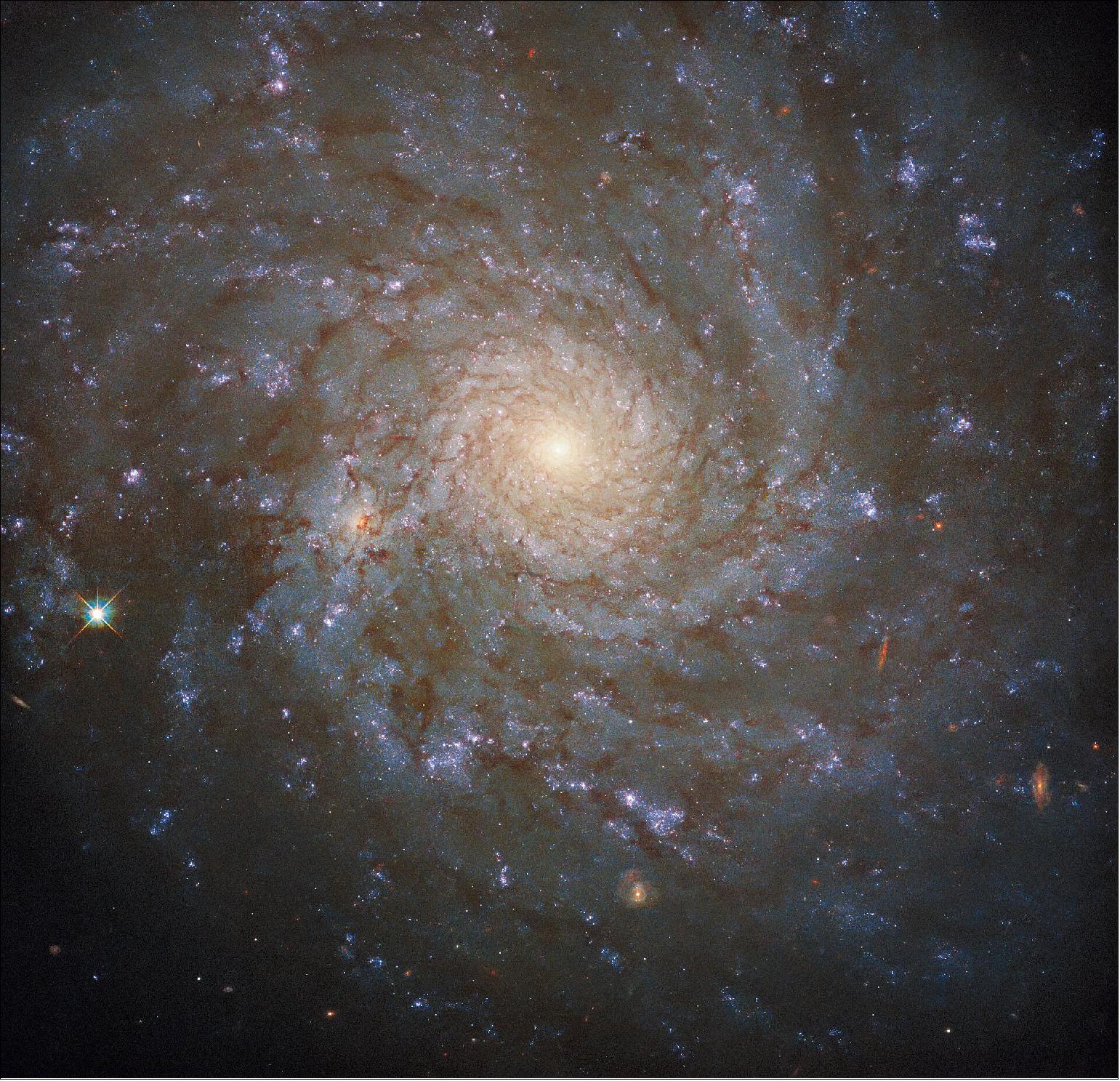
• March 18, 2022: This finely detailed image shows the heart of NGC 1097, a barred spiral galaxy that lies about 48 million light-years from Earth in the constellation Fornax. This picture reveals the intricacy of the web of stars and dust at NGC 1097’s center, with the long tendrils of dust seen in a dark red hue. We can see this intricate structure thanks to two instruments on the NASA/ESA Hubble Space Telescope: the Wide Field Camera 3 (WFC3) and the Advanced Camera for Surveys (ACS). 70)
- The idea that a single image can be taken using two different cameras is not very intuitive. However, it makes far more sense after delving into how beautiful astronomical images like this one are composed. A helpful starting point is to consider what colour is, exactly. Our eyes can detect light waves at optical wavelengths between roughly 380 and 750 nm, using three types of receptors, each of which is sensitive to just a slice of that range. Our brain interprets these specific wavelengths as colours. By contrast, a telescope camera like the WFC3 or ACS is sensitive to a single, broad range of wavelengths to maximise the amount of light collected. Raw images from telescopes are always in greyscale, only showing the amount of the light captured across all those wavelengths.
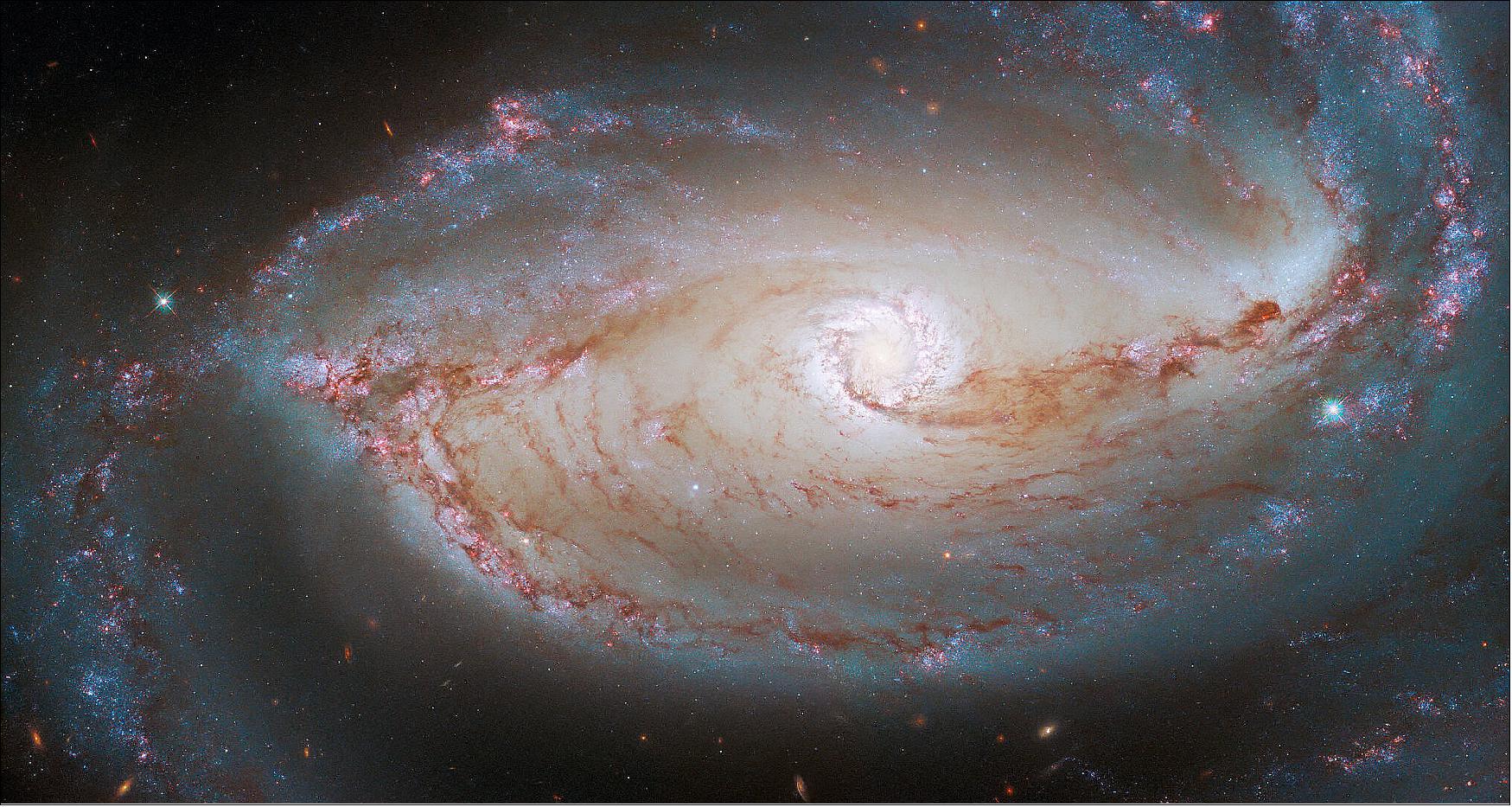
• March 11, 2022: An energetic outburst from an infant star streaks across this image from the NASA/ESA Hubble Space Telescope. This stellar tantrum — produced by an extremely young star in the earliest phase of formation — consists of an incandescent jet of gas travelling at supersonic speeds. As the jet collides with material surrounding the still-forming star, the shock heats this material and causes it to glow. The result is the colourfully wispy structures, which astronomers refer to as Herbig–Haro objects, billowing across the lower left of this image.
- Herbig–Haro objects are seen to evolve and change significantly over just a few years. This particular object, called HH34, was previously captured by Hubble between 1994 and 2007, and again in glorious detail in 2015. HH34 resides approximately 1250 light-years from Earth in the Orion Nebula, a large region of star formation visible to the unaided eye. The Orion Nebula is one of the closest sites of widespread star formation to Earth, and as such has been pored over by astronomers in search of insights into how stars and planetary systems are born.
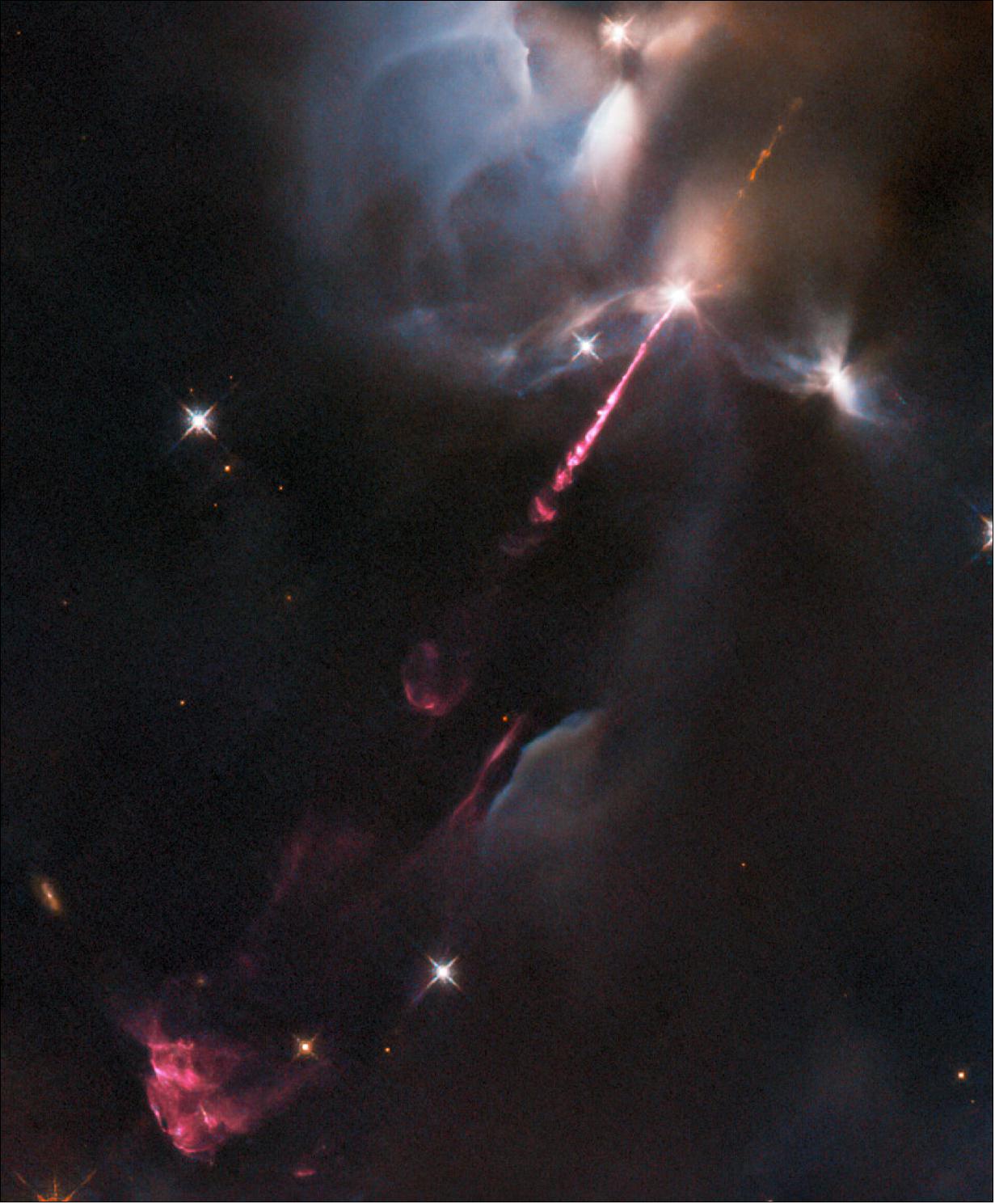
• March 7, 2022 marks the 20th anniversary of the Advanced Camera for Surveys (ACS) aboard the NASA/ESA Hubble Space Telescope. On 7 March 2002 astronauts installed the ACS during Hubble Servicing Mission 3B, also known as STS-109. With its wide field of view, sharp image quality, and high sensitivity, the ACS delivers many of Hubble’s most impressive images of deep space. 71)
- Three subinstruments make up the ACS. The Wide Field Channel is a high-efficiency, wide-field, optical and near-infrared camera that is optimised to hunt for galaxies and galaxy clusters in the remote and ancient Universe, at a time when the cosmos was very young. The High Resolution Channel was designed to take extremely detailed (high resolution) pictures of the light from the centres of galaxies with massive black holes, though this is not currently operational, and the Solar Blind Channel blocks visible light to allow faint ultraviolet radiation to be discerned. Amongst other things, it can be used to study weather patterns on other planets and aurorae on Jupiter.
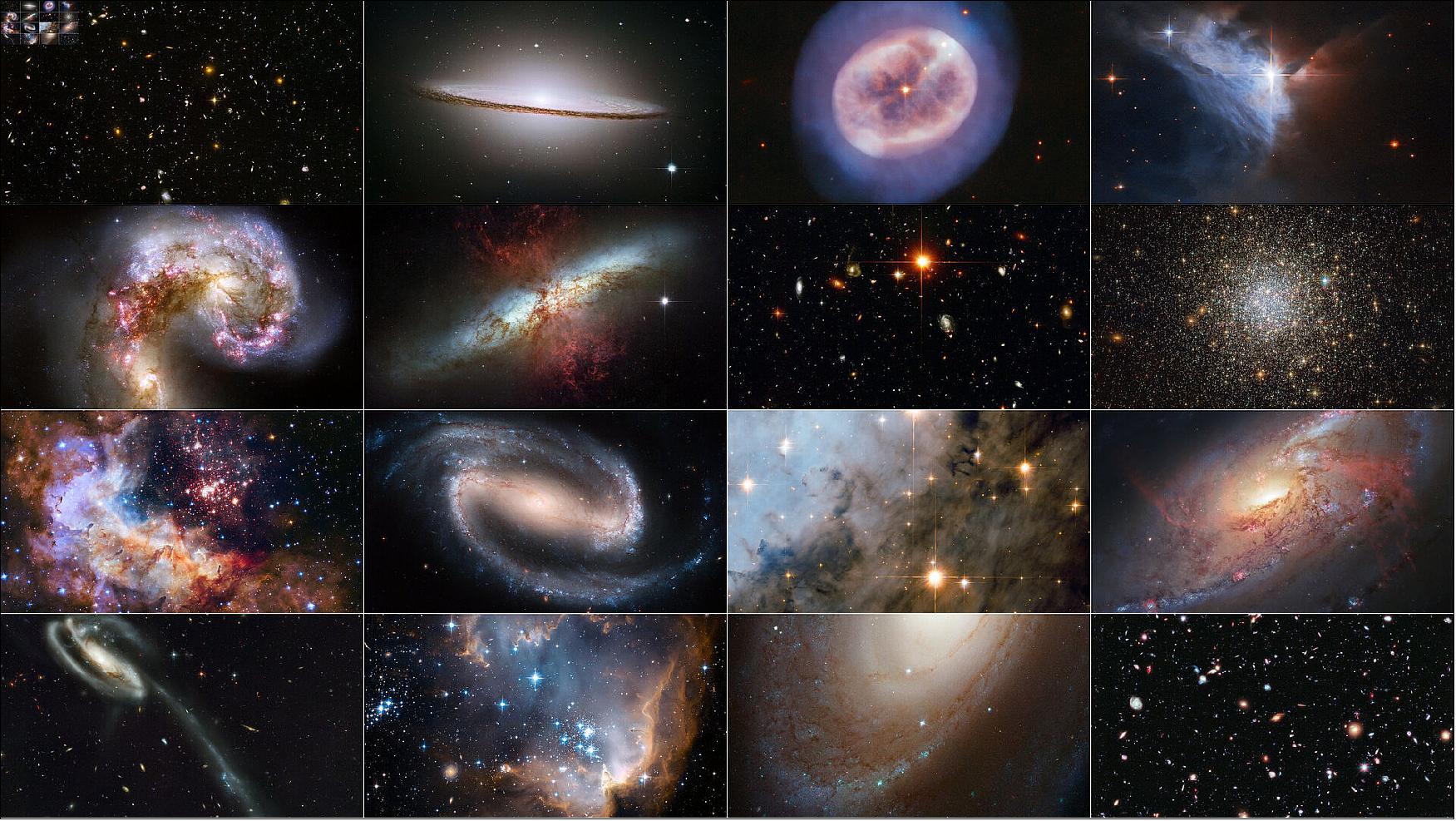
• March 4, 2022: The twin galaxies NGC 4496A and NGC 4496B dominate the frame in this image from the NASA/ESA Hubble Space Telescope. Both galaxies lie in the constellation Virgo, but despite appearing side-by-side in this image they are at vastly different distances from both Earth and one another. NGC 4496A is 47 million light-years from Earth while NGC 4496B is 212 million light-years away. The enormous distances between the two galaxies mean that the two cannot interact, and they only appear to overlap owing to a chance alignment. 72)
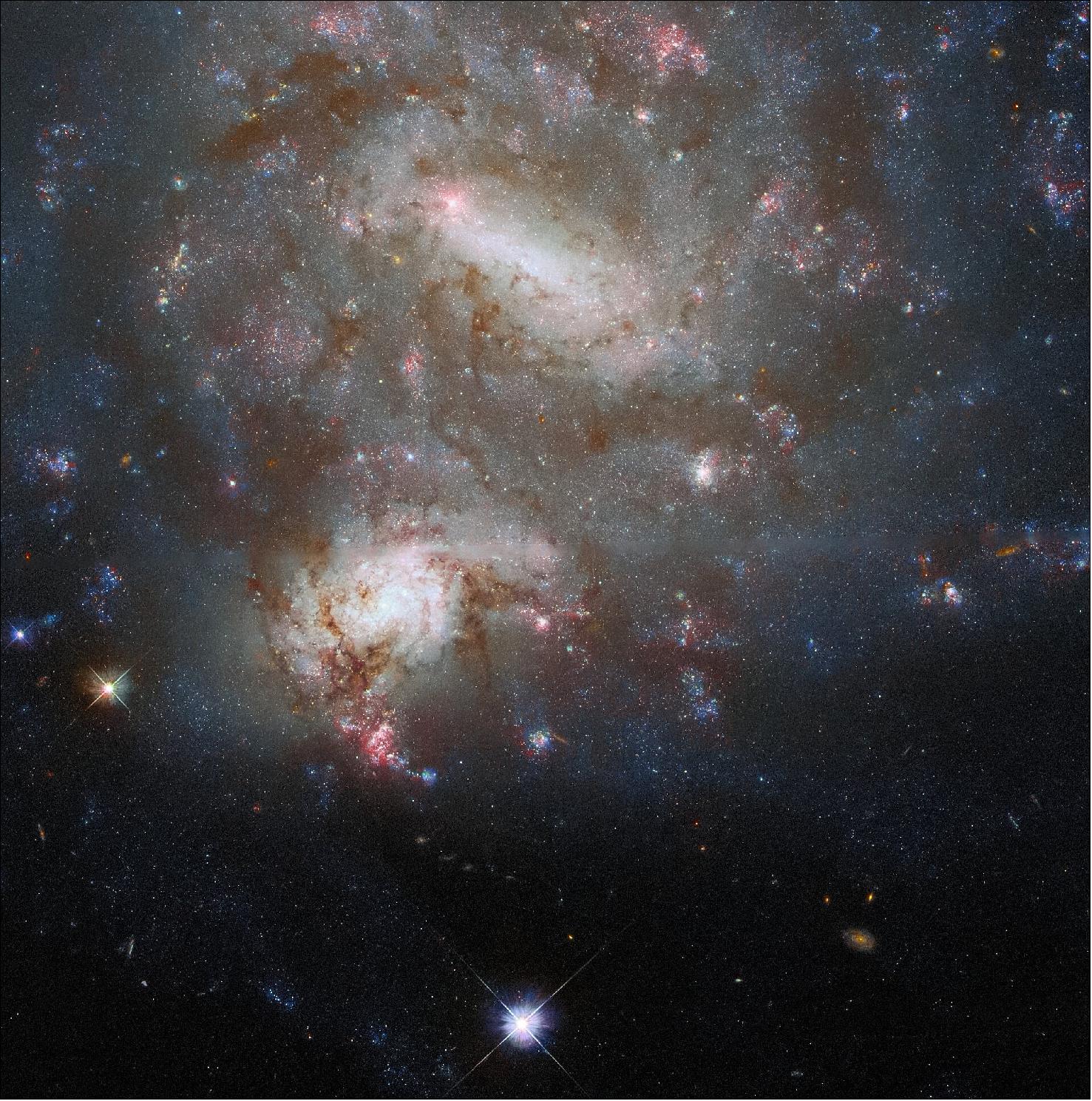
• February 25, 2022: This striking image from the NASA/ESA Hubble Space Telescope showcases Arp 298, a stunning pair of interacting galaxies. Arp 298 — which comprises the two galaxies NGC 7469 and IC 5283 — lies roughly 200 million light-years from Earth in the constellation Pegasus. The larger of the two galaxies pictured here is the barred spiral galaxy NGC 7469, and IC 5283 is its diminutive companion. NGC 7469 is also host to an active, supermassive black hole and a bright ring of star clusters. 73)
- The “Arp” in this galaxy pair’s name signifies that they are listed in the Atlas of Peculiar Galaxies compiled by the astronomer Halton Arp. The Atlas of Peculiar Galaxies is a rogues’ gallery of weird and wonderful galaxies containing peculiar structures, featuring galaxies exhibiting everything from segmented spiral arms to concentric rings. This interacting galaxy pair is a familiar sight for Hubble — a portrait of the merging galaxies in Arp 298 was published in 2008.
- The process of planning Hubble observations starts with a proposal — a detailed plan of what an astronomer intends to observe and their scientific motivation for doing so. Once a year, these proposals are gathered and judged in a gruelling review process which assess their scientific merit and feasibility. Fewer than 20% of the proposed observations in any given year will make it through this process and be approved, which makes observing time with Hubble highly prized indeed.
- This system will be one of the first galaxies observed with the NASA/ESA/CSA James Webb Space Telescope as part of the Director's Discretionary Early Release Science Programs in Summer 2022.
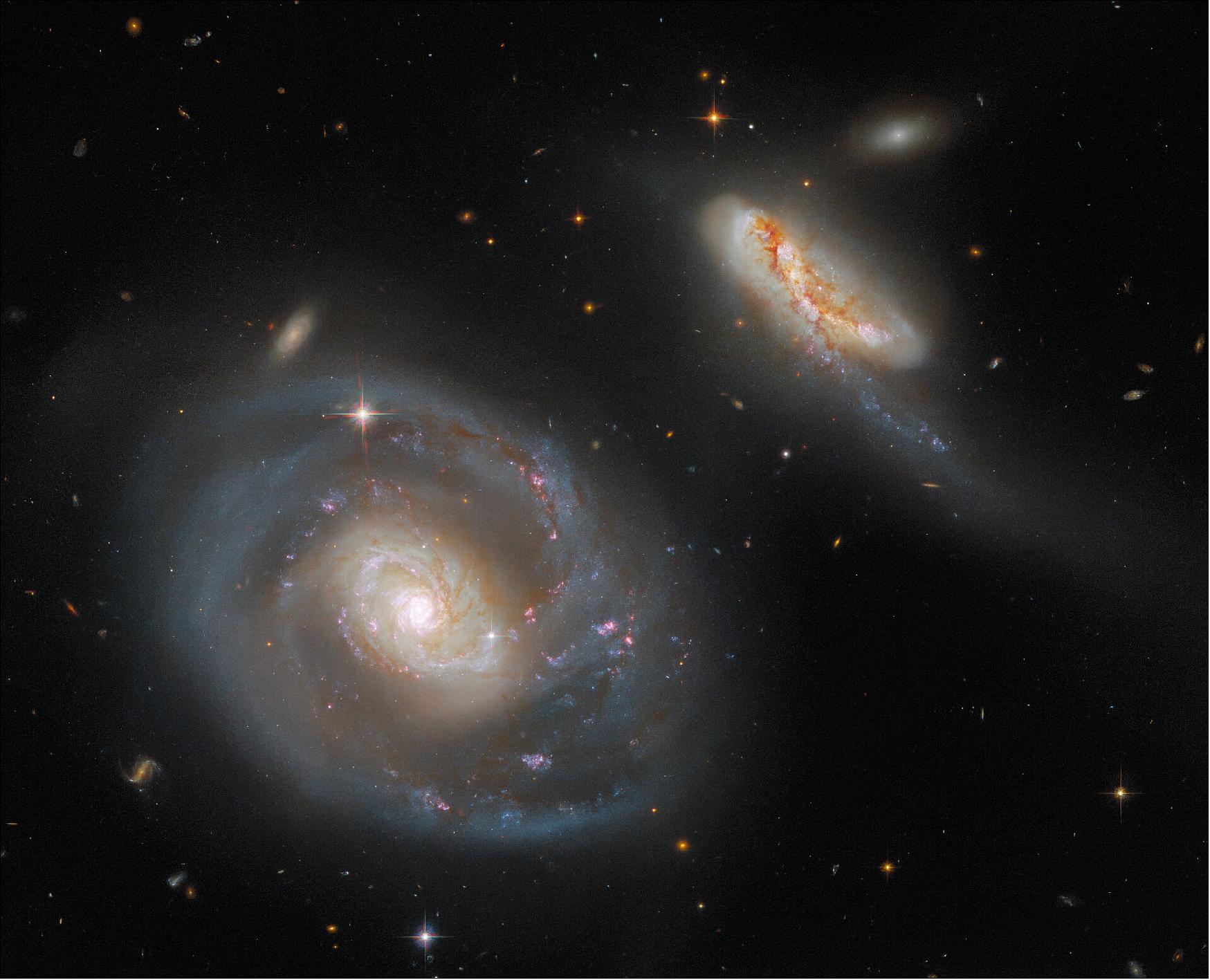
• February 22, 2022: A spectacular head-on collision between two galaxies fueled the unusual triangular-shaped star-birthing frenzy, as captured in a new image from NASA's Hubble Space Telescope. 74)
- The interacting galaxy duo is collectively called Arp 143. The pair contains the glittery, distorted, star-forming spiral galaxy NGC 2445 at right, along with its less flashy companion, NGC 2444 at left.
- Astronomers suggest that the galaxies passed through each other, igniting the uniquely shaped star-formation firestorm in NGC 2445, where thousands of stars are bursting to life on the right-hand side of the image. This galaxy is awash in starbirth because it is rich in gas, the fuel that makes stars. However, it hasn't yet escaped the gravitational clutches of its partner NGC 2444, shown on the left side of the image. The pair is waging a cosmic tug-of-war, which NGC 2444 appears to be winning. The galaxy has pulled gas from NGC 2445, forming the oddball triangle of newly minted stars.
- "Simulations show that head-on collisions between two galaxies is one way of making rings of new stars," said astronomer Julianne Dalcanton of the Flatiron Institute's Center for Computational Astrophysics in New York and the University of Washington in Seattle. "Therefore, rings of star formation are not uncommon. However, what's weird about this system is that it's a triangle of star formation. Part of the reason for that shape is that these galaxies are still so close to each other and NGC 2444 is still holding on to the other galaxy gravitationally. NGC 2444 may also have an invisible, hot halo of gas that could help to pull NGC 2445's gas away from its nucleus. So, they're not completely free of each other yet and their unusual interaction is distorting the ring into this triangle."
- NGC 2444 is also responsible for yanking taffy-like strands of gas from its partner, stoking the streamers of young, blue stars that appear to form a bridge between the two galaxies.
- These streamers are among the first in what appears to be a wave of star formation that started on NGC 2445's outskirts and continued inward. Researchers estimate the streamer stars were born between about 50 million and 100 million years ago. But these infant stars are being left behind as NGC 2445 continues to pull slowly away from NGC 2444.
- Stars no older than 1 million to 2 million years are forming closer to the center of NGC 2445. Hubble's keen sharpness reveals some individual stars. They are the brightest and most massive in the galaxy. Most of the brilliant blue clumps are groupings of stars. The pink blobs are giant, young star clusters still enshrouded in dust and gas.
- Although most of the action is happening in NGC 2445, it doesn't mean the other half of the interacting pair has escaped unscathed. The gravitational tussle has stretched NGC 2444 into an odd shape. The galaxy contains old stars and no new starbirth because it lost its gas long ago, well before this galactic encounter.
- "This is a nearby example of the kinds of interactions that happened long ago. It's a fantastic sandbox to understand star formation and interacting galaxies," said Elena Sabbi of the Space Telescope Science Institute in Baltimore, Maryland.
- The Hubble Space Telescope is a project of international cooperation between NASA and ESA (European Space Agency). NASA’s Goddard Space Flight Center in Greenbelt, Maryland, manages the telescope. The Space Telescope Science Institute (STScI) in Baltimore, Maryland, conducts Hubble science operations. STScI is operated for NASA by the Association of Universities for Research in Astronomy in Washington, D.C.
![Figure 71: A spectacular head-on collision between two galaxies fueled the unusual triangular-shaped star-birthing frenzy, as captured in a new image from NASA's Hubble Space Telescope. The interacting galaxy duo is collectively called Arp 143. The pair contains the glittery, distorted, star-forming spiral galaxy NGC 2445 at right, along with its less flashy companion, NGC 2444 at left. — Astronomers suggest that the galaxies passed through each other, igniting the uniquely shaped star-formation firestorm in NGC 2445, where thousands of stars are bursting to life on the right-hand side of the image. This galaxy is awash in starbirth because it is rich in gas, the fuel that makes stars. However, it hasn't yet escaped the gravitational clutches of its partner NGC 2444, shown on the left side of the image. The pair is waging a cosmic tug-of-war, which NGC 2444 appears to be winning. The galaxy has pulled gas from NGC 2445, forming the oddball triangle of newly minted stars[Credits: Image: NASA, ESA, STScI, Julianne Dalcanton Center for Computational Astrophysics, Flatiron Inst. / U. Washington); Image processing: Joseph DePasquale (STScI)]](https://www.eoportal.org/ftp/satellite-missions/h/Hubble_220722/Hubble_AutoE.jpeg)
• February 18, 2022: The mass of dust and bright swirls of stars in this image are the distant galaxy merger IC 2431, which lies 681 million light-years from Earth in the constellation Cancer. The NASA/ESA Hubble Space Telescope has captured what appears to be a triple galaxy merger in progress, as well as a tumultuous mixture of star formation and tidal distortions caused by the gravitational interactions of this galactic trio. The centre of this image is obscured by a thick cloud of dust — though light from a background galaxy can be seen piercing its outer extremities. 75)
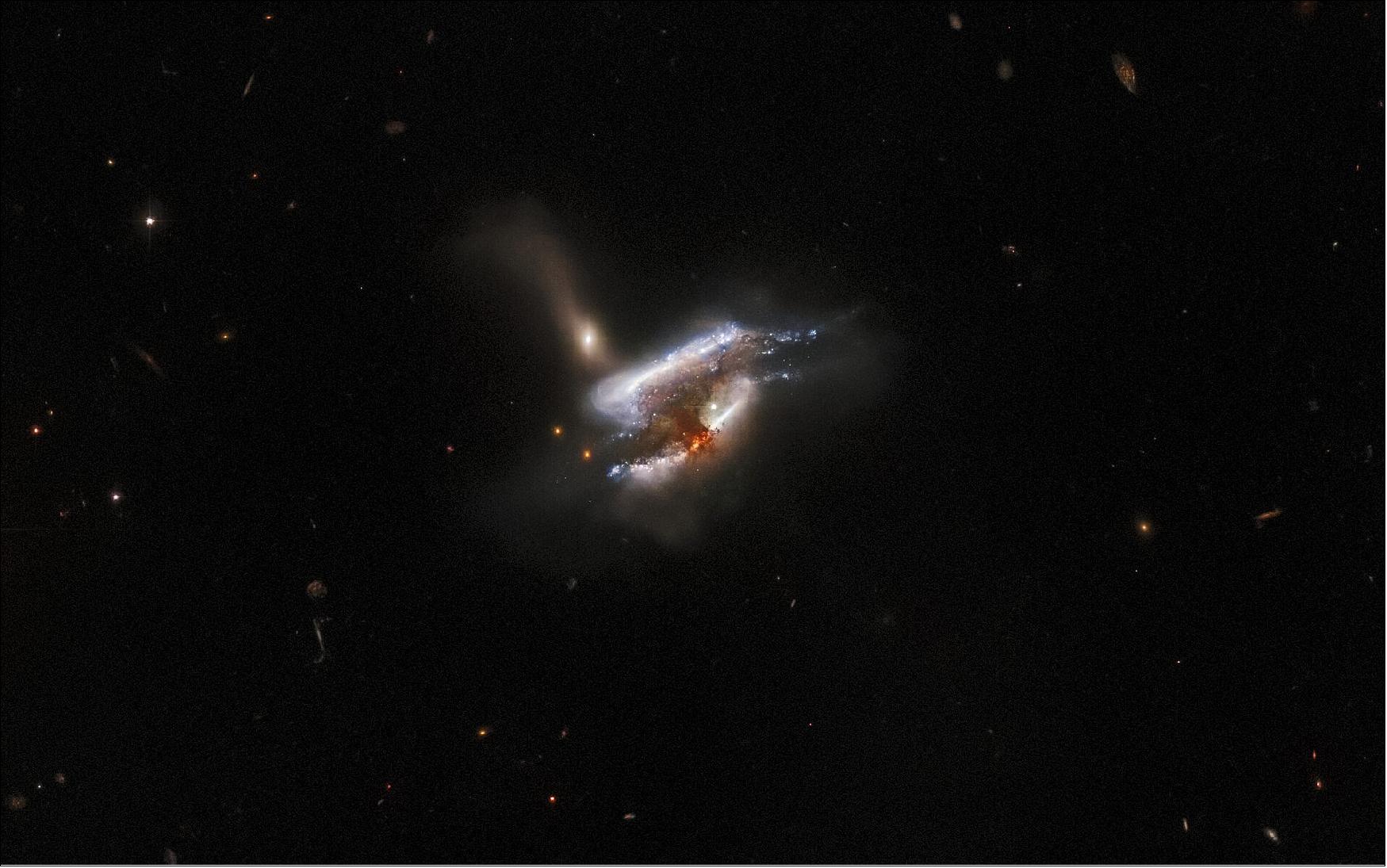
• February 11, 2022: It is now widely accepted amongst astronomers that an important aspect of how galaxies evolve is the way they interact with one another. Galaxies can merge, collide, or brush past one another — each of which has a significant impact on their shapes and structures. As common as these interactions are thought to be in the Universe, it is rare to capture an image of two galaxies interacting in such a visibly dynamic way. This image, from the NASA/ESA Hubble Space Telescope, feels incredibly three-dimensional for a piece of deep-space imagery. 76)
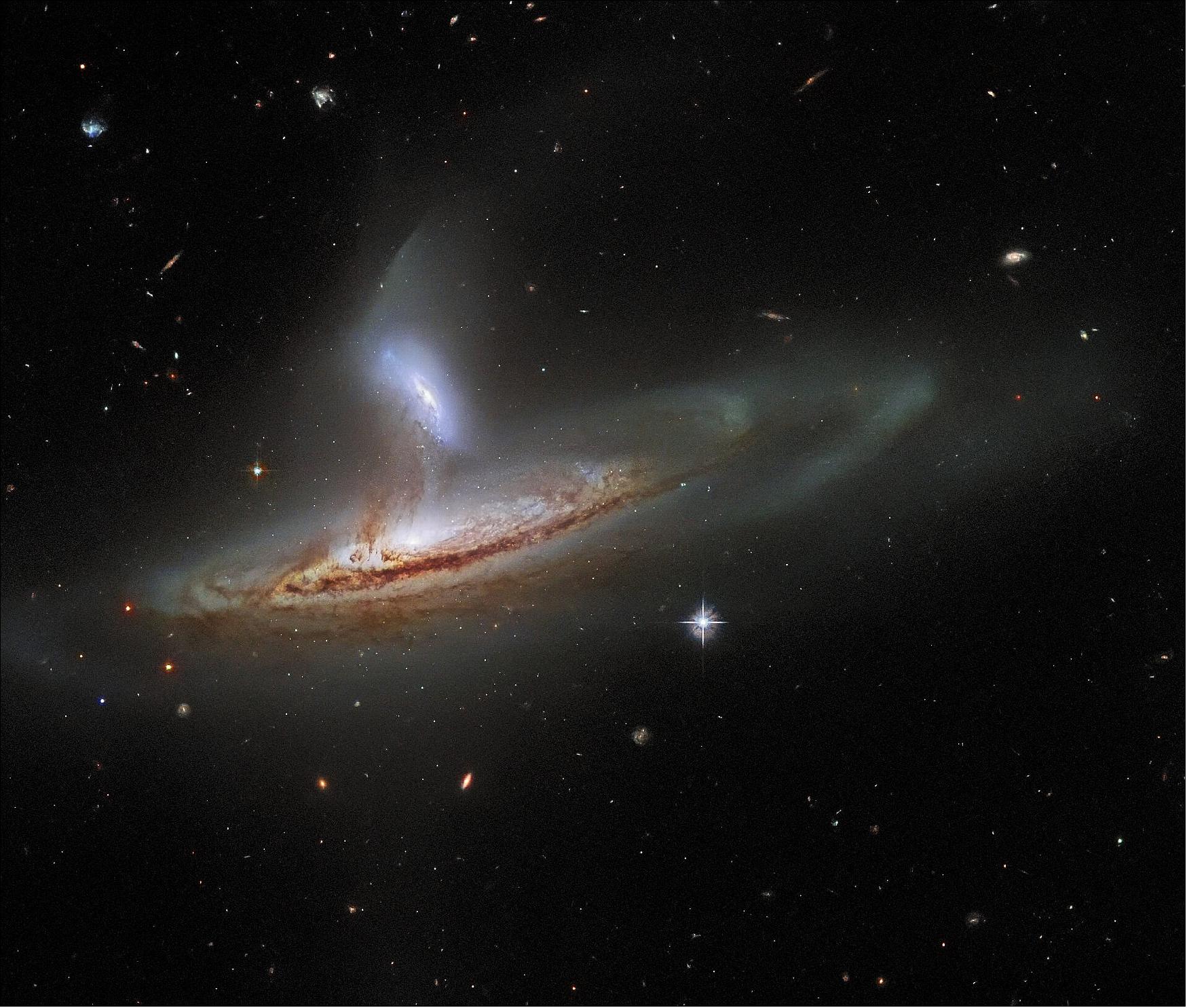
• February 4, 2022: The dwarf galaxy NGC 1705 is featured in this image from the NASA/ESA Hubble Space Telescope. This diminutive galaxy lies in the southern constellation Pictor, and is approximately 17 million light-years from Earth. NGC 1705 is a cosmic oddball — it is small, irregularly shaped, and has recently undergone a spate of star formation known as a starburst. 77)
- Despite these eccentricities, NGC 1705 and other dwarf irregular galaxies like it can provide valuable insights into the overall evolution of galaxies. Dwarf irregular galaxies tend to contain few elements other than hydrogen or helium, and are considered to be similar to the earliest galaxies that populated the Universe.
- This is not the first time that NGC 1705 has been imaged by Hubble — astronomers peered into the heart of the galaxy in 1999 using Hubble’s workhorse camera at the time, the Wide Field Planetary Camera 2. This instrument was replaced with the Wide Field Camera 3 during the fifth and final Space Shuttle mission to Hubble in 2009, and the newer instrument has provided a richer and far more detailed portrait of NGC 1705 than the 1999 observation.
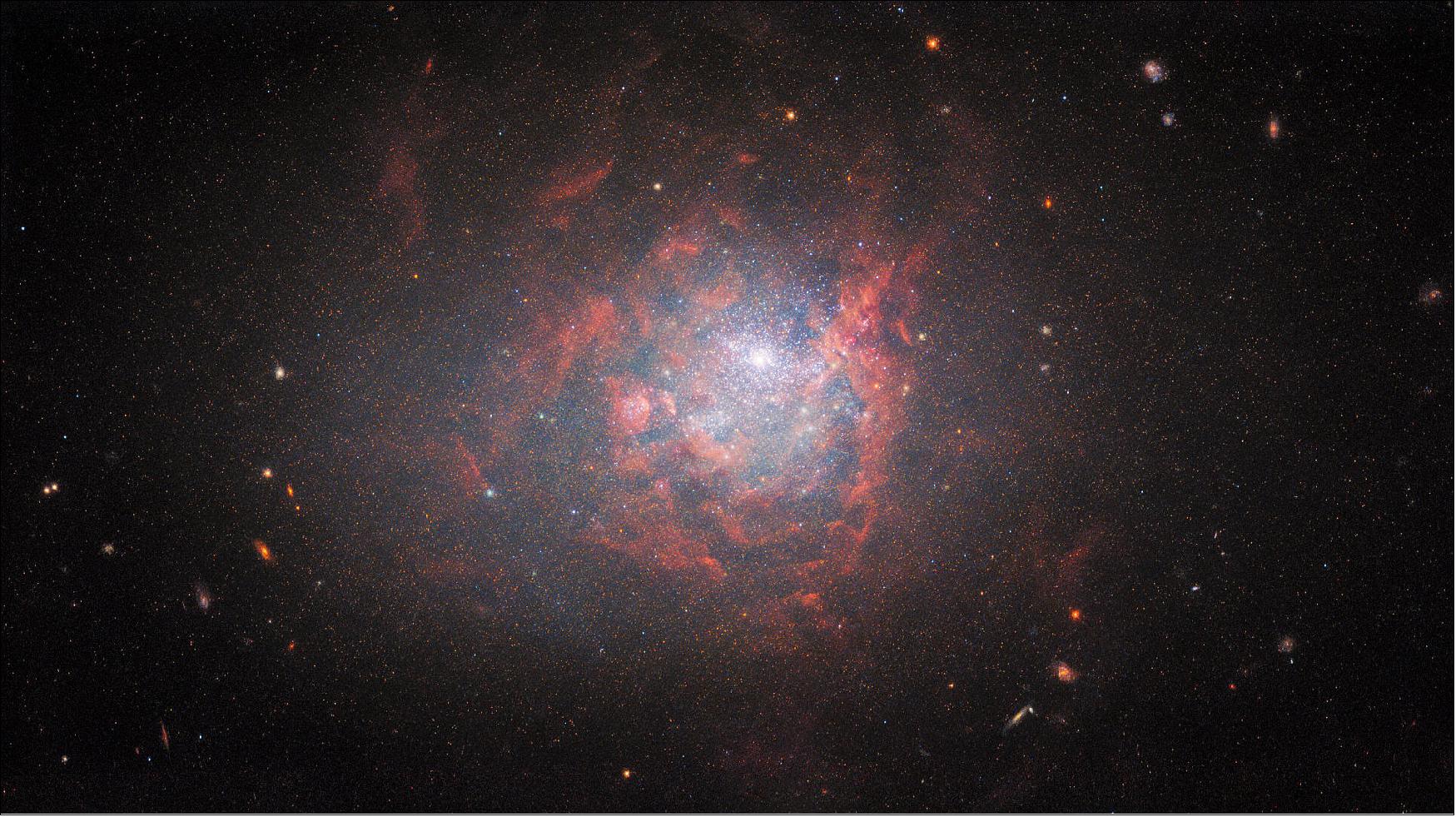
• February 3, 2022: Exoplanets come in shapes and sizes that are not found in our solar system. These include small gaseous planets called mini-Neptunes and rocky planets several times Earth's mass called super-Earths. 78)
- Now, astronomers have identified two different cases of "mini-Neptune" planets that are losing their puffy atmospheres and likely transforming into super-Earths. Radiation from the planets' stars is stripping away their atmospheres, driving the hot gas to escape like steam from a pot of boiling water. The new findings help paint a picture of how exotic worlds like these form and evolve, and help explain a curious gap in the size distribution of planets found around other stars.
- Mini-Neptunes are smaller, denser versions of the planet Neptune in our solar system, and are thought to consist of large rocky cores surrounded by thick blankets of gas. In the new studies, a team of astronomers used NASA's Hubble Space Telescope to look at two mini-Neptunes orbiting HD 63433, a star located 73 light-years away. And they used the W. M. Keck Observatory in Hawaii to study one of two mini-Neptune planets in the star system called TOI 560, located 103 light-years away.
- Their results show that atmospheric gas is escaping from the innermost mini-Neptune in TOI 560, called TOI 560.01 (also known as HD 73583b), and from the outermost mini-Neptune in HD 63433, called HD 63433c. This suggests that they could be turning into super-Earths.
- "Most astronomers suspected that young, mini-Neptunes must have evaporating atmospheres," said Michael Zhang, lead author of both studies and a graduate student at Caltech. "But nobody had ever caught one in the process of doing so until now."
- The study also found, surprisingly, that the gas around TOI 560.01 was escaping predominantly toward the star.
- "This was unexpected, as most models predict that the gas should flow away from the star," said professor of planetary science Heather Knutson of Caltech, Zhang's advisor and a co-author of the study. "We still have a lot to learn about how these outflows work in practice."
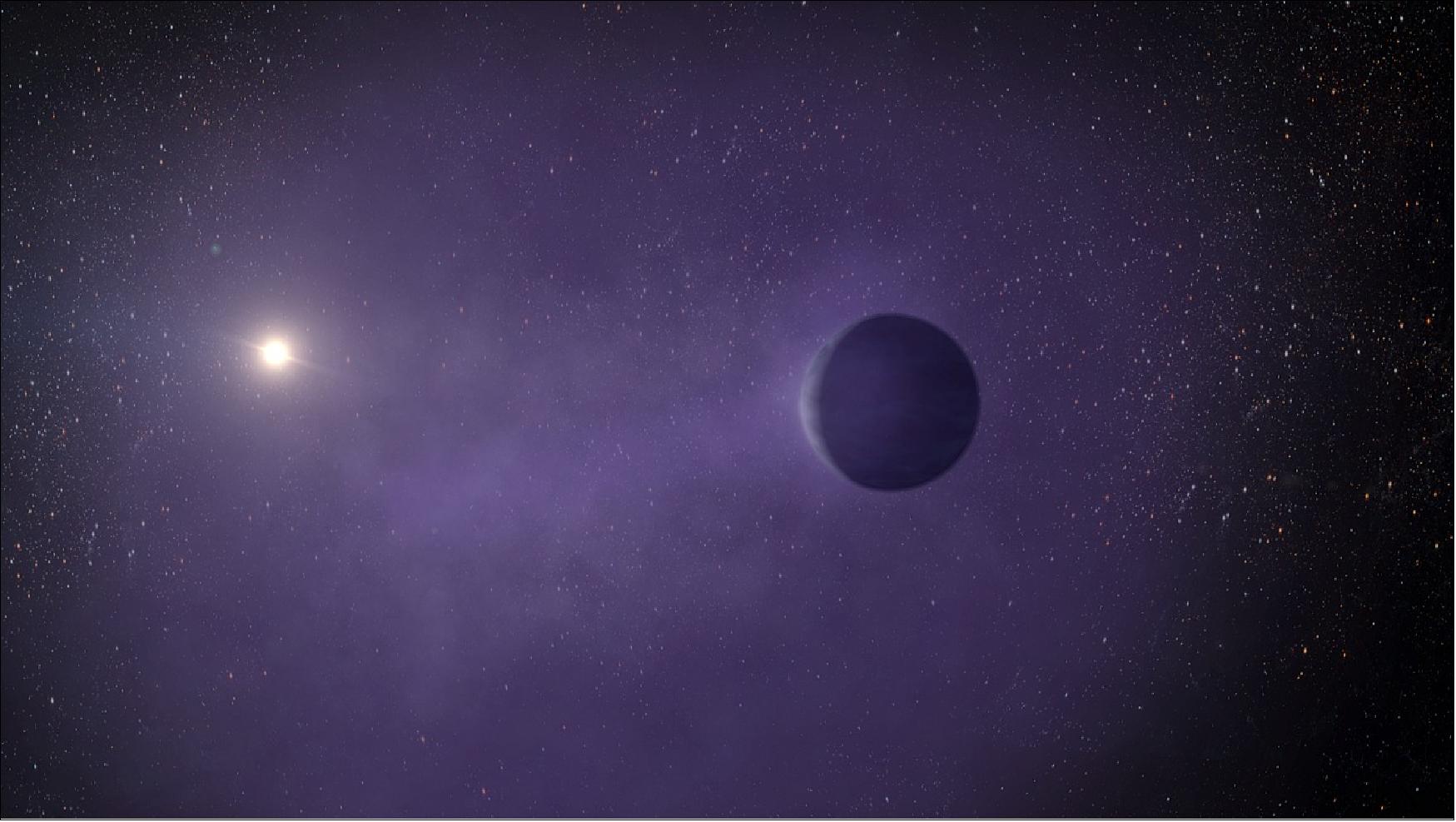
New Clues to Missing Link in Planetary Types
- Since the first exoplanets orbiting sun-like stars were discovered in the mid-1990s, thousands of other exoplanets have been found. Many of these orbit close to their stars, and the smaller, rocky ones generally fall into two groups: the mini-Neptunes and super-Earths. The super-Earths are as large as 1.6 times the size of Earth (and occasionally as large as 1.75 times the size of Earth), while the mini-Neptunes are between 2 and 4 times the size of Earth. Planets of these types are not found in our solar system. In fact, few planets with sizes between these two ranges have been detected around other stars.
- One possible explanation for this size-gap is that the mini-Neptunes are transforming into the super-Earths. The mini-Neptunes are theorized to be cocooned by primordial atmospheres made of hydrogen and helium. The hydrogen and helium are left over from the formation of the central star, which is born out of clouds of gas. If a mini-Neptune is small enough and close enough to its star, stellar X-rays and ultraviolet radiation can strip away its primordial atmosphere over a period of hundreds of millions of years, scientists theorize. This would then leave behind a rocky super-Earth with a substantially smaller diameter (which could, in theory, still retain a relatively thin atmosphere similar to that surrounding our planet Earth).
- "A planet in the size-gap would have enough atmosphere to puff up its radius, making it intercept more stellar radiation and thereby enabling fast mass loss," said Zhang. "But the atmosphere is thin enough that it gets lost quickly. This is why a planet wouldn't stay in the gap for long."
- Other scenarios could explain the size-gap, according to the astronomers. For instance, the smaller rocky planets might have never gathered gas envelopes in the first place, and mini-Neptunes could be water worlds and not enveloped in hydrogen gas. This latest discovery of two mini-Neptunes with escaping atmospheres represents the first direct evidence to support the theory that mini-Neptunes are indeed turning into super-Earths.
Signatures in the Sunlight
- The astronomers were able to detect the escaping atmospheres by watching the mini-Neptunes cross in front of, or transit, their host stars. The planets cannot be seen directly but when they pass in front of their stars as seen from our point of view on Earth, telescopes can look for absorption of starlight by atoms in the planets' atmospheres. In the case of the mini-Neptune TOI 560.01, the researchers found signatures of helium. For the star system HD 63433, the team found signatures of hydrogen in the outermost planet they studied, called HD 63433c, but not the inner planet, HD 63433b.
- "The inner planet may have already lost its atmosphere," explained Zhang.
- "The speed of the gases provides the evidence that the atmospheres are escaping. The observed helium around TOI 560.01 is moving as fast as 20 kilometers per second, while the hydrogen around HD 63433c is moving as fast as 50 km/s. The gravity of these mini-Neptunes is not strong enough to hold on to such fast-moving gas. The extent of the outflows around the planets also indicates escaping atmospheres; the cocoon of gas around TOI 560.01 is at least 3.5 times as large as the radius of the planet, and the cocoon around HD 63433c is at least 12 times the radius of the planet."
- The observations also revealed that the gas lost from TOI 560.01 was flowing toward the star. Future observations of other mini-Neptunes should reveal if TOI 560.01 is an anomaly or whether an inward-moving atmospheric outflow is more common.
- "As exoplanet scientists, we've learned to expect the unexpected," Knutson said. "These exotic worlds are constantly surprising us with new physics that goes beyond what we observe in our solar system."
- The findings are being published in two separate papers in The Astronomical Journal. 79) 80)
• January 31, 2022: This NASA Hubble Space Telescope image captures one of three segments that comprise a 65-light-year wide star-forming region named the Chamaeleon Cloud Complex. The segment in this Hubble composite image, called Chamaeleon Cloud I (Cha I), reveals dusty-dark clouds where stars are forming, dazzling reflection nebulae glowing by the light of bright-blue young stars, and radiant knots called Herbig-Haro objects. 81)
- Herbig-Haro objects are bright clumps and arcs of interstellar gas shocked and energized by jets expelled from infant “protostars” in the process of forming. The white-orange cloud at the bottom of the image hosts one of these protostars at its center. Its brilliant white jets of hot gas are ejected in narrow torrents from the protostar’s poles, creating the Herbig-Haro object HH 909A.
- The cross-like spikes around bright stars in the image occur when light waves from a very bright point source (like a star) bend around Hubble’s cross-shaped struts that support the telescope’s secondary mirror. As the light waves pass these struts, they coalesce on the other side, creating the bright, spikey starburst effect we see.
- Hubble studied Cha I as part of a search for extremely dim, low-mass brown dwarfs. These “failed stars” lie somewhere in size between a large planet and a small star (10 to 90 times the mass of Jupiter), and do not have enough mass to ignite and sustain nuclear fusion in their cores. Hubble’s search found six new low-mass brown dwarf candidates that are helping astronomers better understand these objects.
![Figure 76: This 315-million-pixel composite image is comprised of 23 observations made by Hubble’s Advanced Camera for Surveys. Gaps between those observations were filled by 20 Wide Field and Planetary Camera 2 images. Any remaining gaps were filled with ground-based data from ESO’s VISTA VIRCAM. To download the full high-resolution version of this image, visit Hubble Captures Chamaeleon Cloud I [image credit: NASA, ESA, K. Luhman and T. Esplin (Pennsylvania State University), et al., and ESO; Processing: Gladys Kober (NASA/Catholic University of America)]](https://www.eoportal.org/ftp/satellite-missions/h/Hubble_220722/Hubble_Auto9.jpeg)
• January 28, 2022: NGC 7764A, which lies about 425 million light years from Earth in the constellation Phoenix, is a fascinating example of just how awkward astronomical nomenclature can be. The three galaxies are individually referred to as NGC 7764A1, NGC 7764A2 and NGC 7764A3, and just to be really difficult, an entirely separate galaxy, named NGC 7764, sits in the skies about a Moon’s distance (as seen from Earth) away. This rather haphazard naming makes more sense when we consider that many of the catalogues for keeping track of celestial bodies were compiled well over 100 years ago, long before modern technology made standardising scientific terminology much easier. As it is, many astronomical objects have several different names, or might have names that are so similar to other objects’ names that they cause confusion. 82)
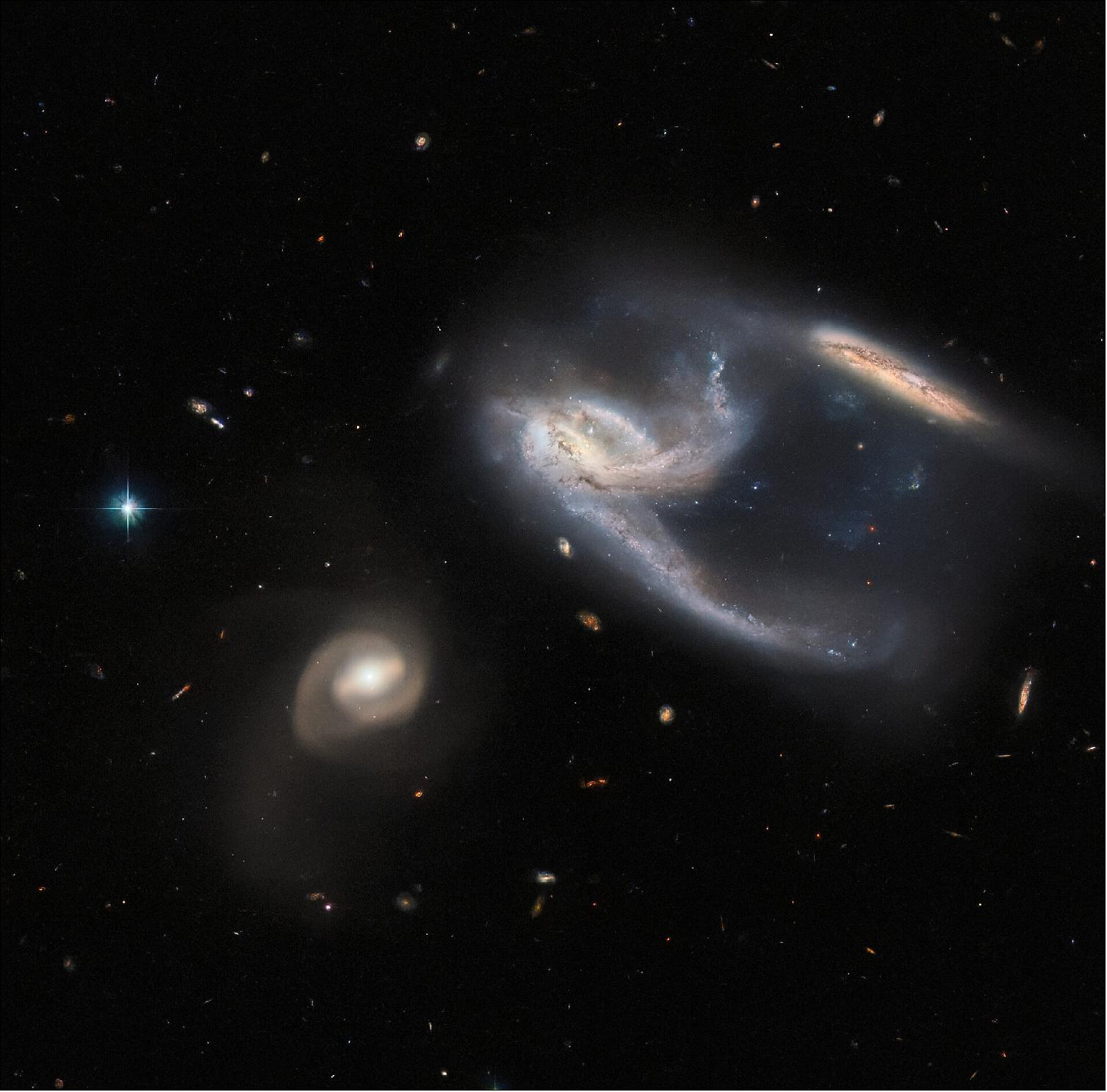
• January 25, 2022: It was once one of the brightest stars in the heavens, easily visible to mariners navigating by the southern sky in the mid-1840s. But the star Eta Carinae quickly faded into obscurity after its brief outburst. Now, over a century and a half later, NASA space observatories (probing from infrared light through X-rays) have enabled astronomers and artists to assemble a three-dimensional model of the Homunculus Nebula and accompanying clouds of dust and gas enshrouding the petulant star. More than just an eye-catching visualization, the story of the 1843 Great Eruption and the history of the expelled nebula is designed to enrich astronomical learning, a key goal of NASA's Universe of Learning. 83)
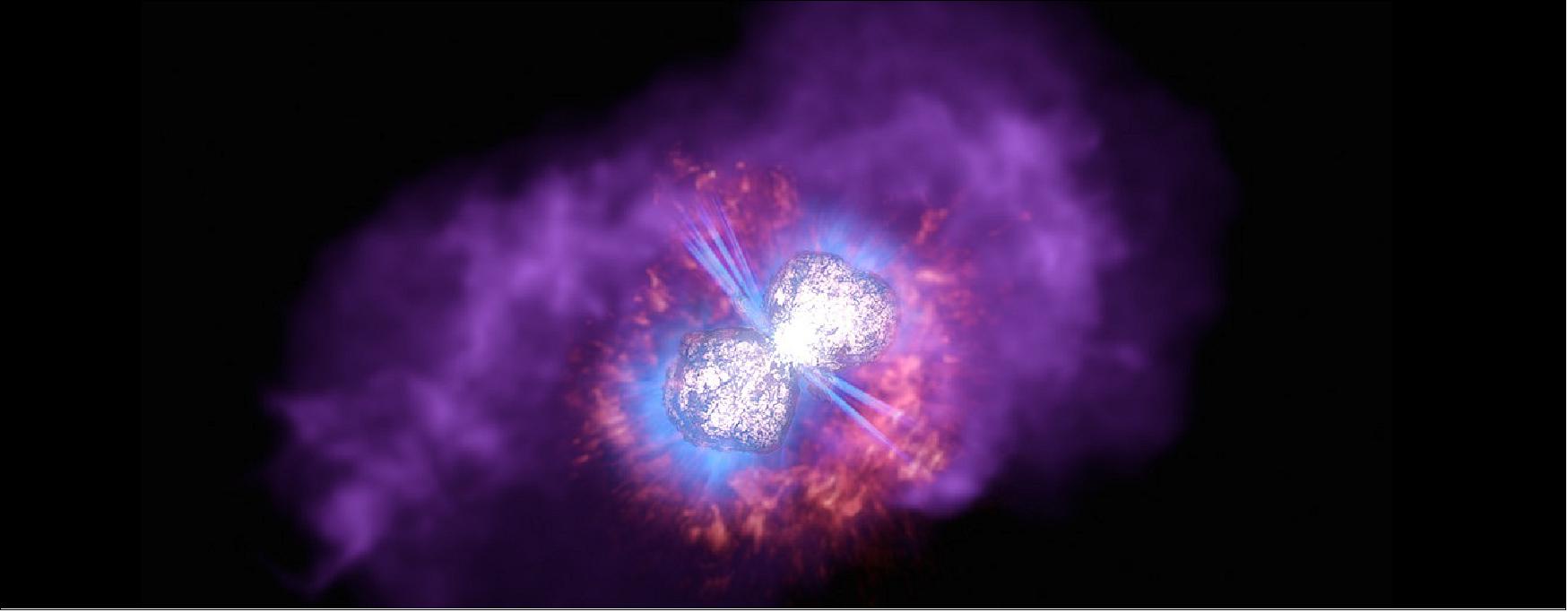
- Observations using NASA's Hubble Space Telescope and Chandra X-ray Observatory reveal the details in visible, ultraviolet, and X-ray light. Astronomers and artists at the Space Telescope Science Institute (STScI) in Baltimore, Maryland have developed three-dimensional models to represent the hourglass shape of the Homunculus and the clouds of glowing gas that encompass it. The result is a stunning tour of the nested emissions that brings the 2D images to 3D life.
- "The team did such an amazing job representing the volumetric layers that viewers can immediately and intuitively comprehend the complex structure around Eta Car," said Frank Summers, principal visualization scientist at STScI and project lead. "We can not only tell the story of the Great Eruption, but also showcase the resulting nebula in 3D."
- In addition, Eta Car is extremely bright at infrared wavelengths, and its radiation impacts the much larger Carina Nebula where it resides. Working with NASA's Spitzer Space Telescope observations, the team was able to place Eta Car in context of the dazzling infrared view of the star-forming region.
- "Spitzer's infrared image lets us peer through the dust that obscures our view in visible light to reveal the intricate details and extent of the Carina Nebula around this brilliant star," commented Robert Hurt, lead visualization scientist at Caltech/IPAC and team member.
- Extending the goals of NASA's Universe of Learning, the visualization assets promote learning beyond the video sequence. "We can take these models like the one for Eta Car and use them in 3D printing and augmented reality programs," noted Kim Arcand, visualization lead scientist at the Chandra X-ray Center in Cambridge, Massachusetts. "This means more people can put their hands on the data – literally and virtually – and this makes for better learning and engagement."
- Eta Carinae is one of the most massive stars known. These exceptional stars are prone to outbursts during their lives. They will end their lives by collapsing into a black hole, probably accompanied by a supernova explosion. Eta Car is one of the nearest and best studied examples for learning about the energetic life and death of very massive stars.
- Want to learn more? The visualization video and extensive related resources, which will include an upcoming Universe of Learning online live chat with Summers about the visualization, can be found at https://universeunplugged.ipac.caltech.edu/video/astroviz-eta-car
- Eta Carinae, or Eta Car, is famous for a brilliant and unusual outburst, called the "Great Eruption", observed in the 1840s. This visualization presents the story of that event and examines the resulting multiwavelength emissions and three-dimensional structures surrounding Eta Car today.
- Massive stars are known to have major outbursts. Eta Car, one of the most massive star systems known, expelled about 10% of its mass in the Great Eruption, creating a small nebula, called the Homunculus Nebula, around it. Images taken in different wavelengths of light reveal different structures, each providing more information about the outbursts of Eta Car.
- For this visualization, astronomers and artists have used NASA observations to model both the close-up and wide views of this massive and eruptive star. The Hubble Space Telescope and the Chandra X-ray Observatory have observed the nested layers of gas and dust around Eta Car using visible, ultraviolet, and x-ray light, as well as in the Hydrogen Alpha emission line. The Spitzer Space Telescope provides a larger view of the Carina Nebula, along with Eta Car’s dominant position within this star-forming region.
• January 21, 2022: The spiral arms of the galaxy NGC 3318 are lazily draped across this image from the NASA/ESA Hubble Space Telescope. This spiral galaxy lies in the constellation Vela and is roughly 115 light-years away from Earth. Vela was originally part of a far larger constellation, known as Argo Navis after the fabled ship Argo from Greek mythology, but this unwieldy constellation proved to be impractically large. Argo Navis was split into three separate parts called Carnina, Puppis, and Vela — each named after part of the Argo. As befits a galaxy in a nautically inspired constellation, the outer edges of NGC 3318 almost resemble a ship’s sails billowing in a gentle breeze. 84)
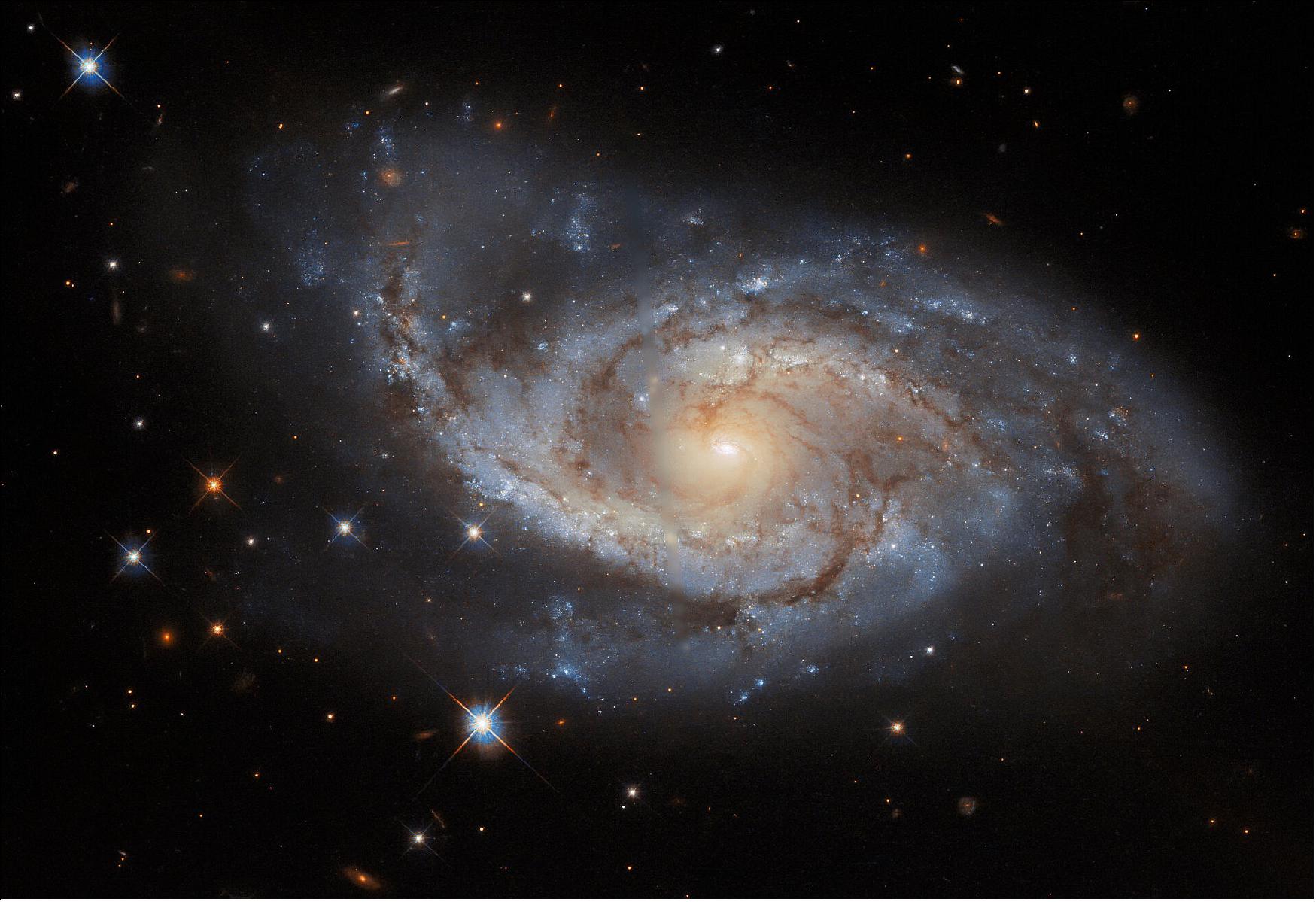
• January 19, 2022: Often portrayed as destructive monsters that hold light captive, black holes take on a less villainous role in the latest research from NASA's Hubble Space Telescope. A black hole at the heart of the dwarf galaxy Henize 2-10 is creating stars rather than gobbling them up. The black hole is apparently contributing to the firestorm of new star formation taking place in the galaxy. The dwarf galaxy lies 30 million light-years away, in the southern constellation Pyxis. 85)
- A decade ago this small galaxy set off debate among astronomers as to whether dwarf galaxies were home to black holes proportional to the supermassive behemoths found in the hearts of larger galaxies. This new discovery has little Henize 2-10, containing only one-tenth the number of stars found in our Milky Way, poised to play a big part in solving the mystery of where supermassive black holes came from in the first place.
- "Ten years ago, as a graduate student thinking I would spend my career on star formation, I looked at the data from Henize 2-10 and everything changed," said Amy Reines, who published the first evidence for a black hole in the galaxy in 2011 and is the principal investigator on the new Hubble observations, published in the January 19 issue of Nature. 86)
- "From the beginning I knew something unusual and special was happening in Henize 2-10, and now Hubble has provided a very clear picture of the connection between the black hole and a neighboring star forming region located 230 light-years from the black hole," Reines said.
- That connection is an outflow of gas stretching across space like an umbilical cord to a bright stellar nursery. The region was already home to a dense cocoon of gas when the low-velocity outflow arrived. Hubble spectroscopy shows the outflow was moving about 1 million miles per hour, slamming into the dense gas like a garden hose hitting a pile of dirt and spreading out. Newborn star clusters dot the path of the outflow's spread, their ages also calculated by Hubble.
- This is the opposite effect of what's seen in larger galaxies, where material falling toward the black hole is whisked away by surrounding magnetic fields, forming blazing jets of plasma moving at close to the speed of light. Gas clouds caught in the jets' path would be heated far beyond their ability to cool back down and form stars. But with the less-massive black hole in Henize 2-10, and its gentler outflow, gas was compressed just enough to precipitate new star formation.
- "At only 30 million light-years away, Henize 2-10 is close enough that Hubble was able to capture both images and spectroscopic evidence of a black hole outflow very clearly. The additional surprise was that, rather than suppressing star formation, the outflow was triggering the birth of new stars," said Zachary Schutte, Reines' graduate student and lead author of the new study.
- Ever since her first discovery of distinctive radio and X-ray emissions in Henize 2-10, Reines has thought they likely came from a massive black hole, but not as supermassive as those seen in larger galaxies. Other astronomers, however, thought that the radiation was more likely being emitted by a supernova remnant, which would be a familiar occurrence in a galaxy that is rapidly pumping out massive stars that quickly explode.
![Figure 81: Dwarf starburst galaxy Henize 2-10 sparkles with young stars in this Hubble visible-light image. The bright region at the center, surrounded by pink clouds and dark dust lanes, indicates the location of the galaxy's massive black hole and active stellar nurseries [image credits: Science: NASA, ESA, Zachary Schutte (XGI), Amy Reines (XGI); Image Processing: Alyssa Pagan (STScI)]](https://www.eoportal.org/ftp/satellite-missions/h/Hubble_220722/Hubble_Auto5.jpeg)
- "Hubble's amazing resolution clearly shows a corkscrew-like pattern in the velocities of the gas, which we can fit to the model of a precessing, or wobbling, outflow from a black hole. A supernova remnant would not have that pattern, and so it is effectively our smoking-gun proof that this is a black hole," Reines said.
- Reines expects that even more research will be directed at dwarf galaxy black holes in the future, with the aim of using them as clues to the mystery of how supermassive black holes came to be in the early universe. It's a persistent puzzle for astronomers. The relationship between the mass of the galaxy and its black hole can provide clues. The black hole in Henize 2-10 is around 1 million solar masses. In larger galaxies, black holes can be more than 1 billion times our Sun's mass. The more massive the host galaxy, the more massive the central black hole.
- Current theories on the origin of supermassive black holes break down into three categories: 1) they formed just like smaller stellar-mass black holes, from the implosion of stars, and somehow gathered enough material to grow supermassive, 2) special conditions in the early universe allowed for the formation of supermassive stars, which collapsed to form massive black hole "seeds" right off the bat, or 3) the seeds of future supermassive black holes were born in dense star clusters, where the cluster's overall mass would have been enough to somehow create them from gravitational collapse.
- So far, none of these black hole seeding theories has taken the lead. Dwarf galaxies like Henize 2-10 offer promising potential clues, because they have remained small over cosmic time, rather than undergoing the growth and mergers of large galaxies like the Milky Way. Astronomers think that dwarf galaxy black holes could serve as an analog for black holes in the early universe, when they were just beginning to form and grow.
- "The era of the first black holes is not something that we have been able to see, so it really has become the big question: where did they come from? Dwarf galaxies may retain some memory of the black hole seeding scenario that has otherwise been lost to time and space," Reines said.
- The Hubble Space Telescope is a project of international cooperation between NASA and ESA (European Space Agency). NASA's Goddard Space Flight Center in Greenbelt, Maryland, manages the telescope. The Space Telescope Science Institute (STScI) in Baltimore, Maryland, conducts Hubble science operations. STScI is operated for NASA by the Association of Universities for Research in Astronomy in Washington, D.C.
• January 14, 2022: The lazily winding spiral arms of the spectacular galaxy NGC 976 fill the frame of this image from the NASA/ESA Hubble Space Telescope. This spiral galaxy lies around 150 million light-years from the Milky Way in the constellation Aries. Despite its tranquil appearance, NGC 976 has played host to one of the most violent astronomical phenomena known — a supernova explosion. These cataclysmicly violent events take place at the end of the lives of massive stars, and can outshine entire galaxies for a short period. While supernovae mark the deaths of massive stars, they are also responsible for the creation of heavy elements that are incorporated into later generations of stars and planets. 87)
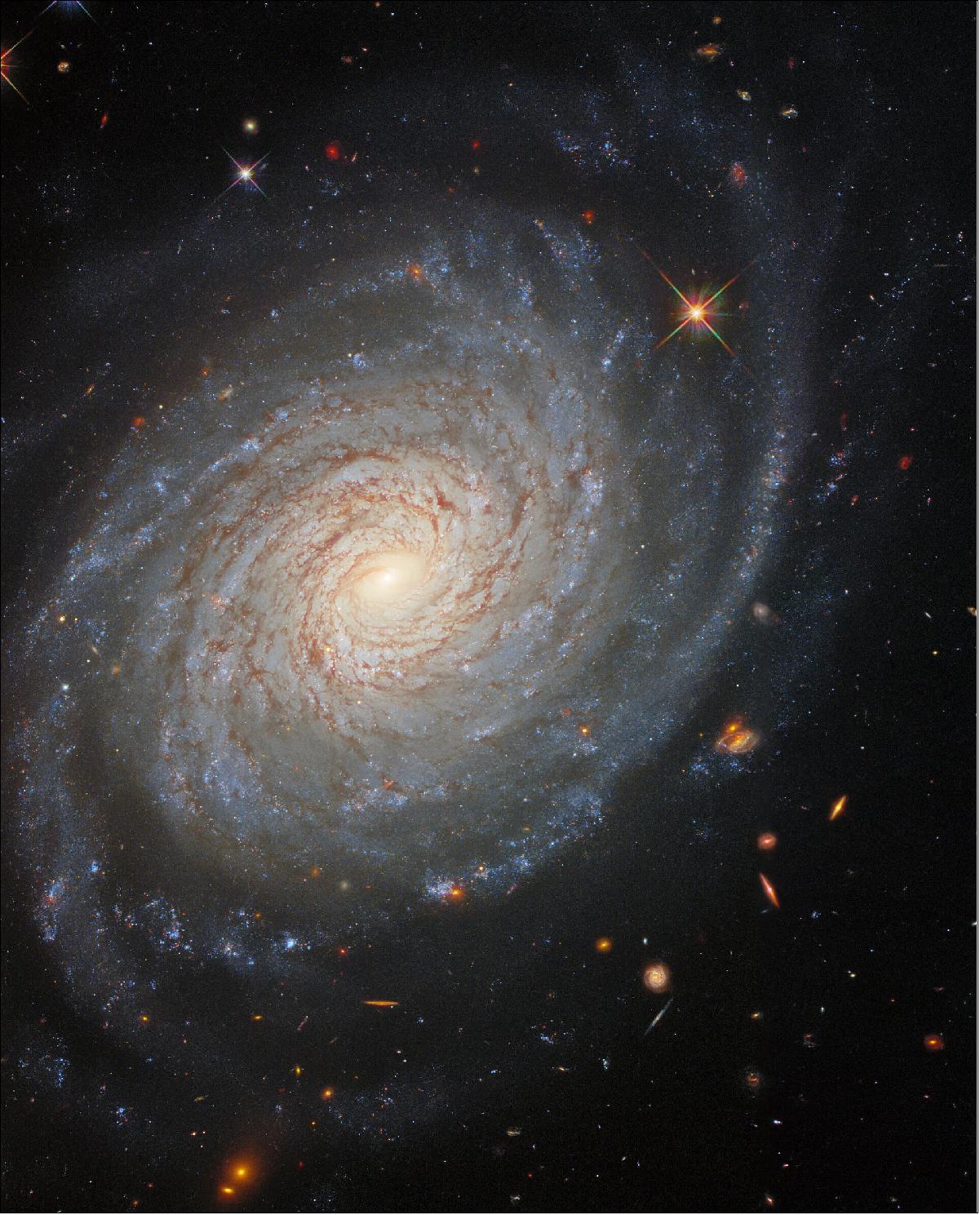
• January 2022: Astronomers at the Center for Astrophysics (CfA) | Harvard & Smithsonian and the Space Telescope Science Institute have reconstructed the evolutionary history of our galactic neighborhood, showing how a chain of events beginning 14 million years ago led to the creation of a vast bubble that's responsible for the formation of all nearby, young stars. 88)
- The Earth sits in a 1,000-light-year-wide void surrounded by thousands of young stars — but how did those stars form?
![Figure 83: Artist's illustration of the Local Bubble with star formation occurring on the bubble's surface. Scientists have now shown how a chain of events beginning 14 million years ago with a set of powerful supernovae led to the creation of the vast bubble, responsible for the formation of all young stars within 500 light-years of the Sun and Earth [image credit: CfA, Leah Hustak (STScI)]](https://www.eoportal.org/ftp/satellite-missions/h/Hubble_220722/Hubble_Auto3.jpeg)
- In a paper appearing today in Nature, astronomers at the Center for Astrophysics | Harvard & Smithsonian (CfA) and the Space Telescope Science Institute (STScI) reconstruct the evolutionary history of our galactic neighborhood, showing how a chain of events beginning 14 million years ago led to the creation of a vast bubble that’s responsible for the formation of all nearby, young stars. 89)
- "This is really an origin story; for the first time we can explain how all nearby star formation began," said astronomer and data visualization expert Catherine Zucker, who completed the work during a fellowship at the CfA.
![Figure 84: Annotated illustration of the Local Bubble's Star-forming Regions [image credit: CfA, Leah Hustak (STScI)]](https://www.eoportal.org/ftp/satellite-missions/h/Hubble_220722/Hubble_Auto2.jpeg)
- The paper's central figure, a 3D spacetime animation, reveals that all young stars and star-forming regions — within 500 light-years of Earth — sit on the surface of a giant bubble known as the Local Bubble. While astronomers have known of its existence for decades, scientists can now see and understand the Local Bubble's beginnings and its impact on the gas around it.
The Source of Our Stars: The Local Bubble
- Using a trove of new data and data science techniques, the spacetime animation shows how a series of supernovae that first went off 14 million years ago pushed interstellar gas outwards, creating a bubble-like structure with a surface that's ripe for star formation.
- Today, seven well-known star-forming regions or molecular clouds — dense regions in space where stars can form — sit on the surface of the bubble.
- We've calculated that about 15 supernovae have gone off over millions of years to form the Local Bubble that we see today," said Zucker who is now a NASA Hubble Fellow at STScI.
- The oddly-shaped bubble is not dormant and continues to slowly grow, the astronomers note.
- "It's coasting along at about 4 miles per second," Zucker said. "It has lost most of its oomph though and has pretty much plateaued in terms of speed."
- The expansion speed of the bubble, as well as the past and present trajectories of the young stars forming on its surface, were derived using data obtained by Gaia, a space-based observatory launched by ESA (European Space Agency).
- "This is an incredible detective story, driven by both data and theory," said Harvard professor and Center for Astrophysics astronomer Alyssa Goodman, a study co-author and founder of glue, data visualization software that enabled the discovery. "We can piece together the history of star formation around us using a wide variety of independent clues: supernova models, stellar motions and exquisite new 3D maps of the material surrounding the Local Bubble."
Bubbles Everywhere
- "When the first supernovae that created the Local Bubble went off, our Sun was far away from the action," said co-author João Alves, a professor at the University of Vienna. "But about five million years ago, the Sun's path through the galaxy took it right into the bubble, and now the Sun sits — just by luck — almost right in the bubble's center."
- Today, as humans peer out into space from near the Sun, they have a front row seat to the process of star formation occurring all around on the bubble's surface.
- Astronomers first theorized that superbubbles were pervasive in the Milky Way nearly 50 years ago . "Now, we have proof — and what are the chances that we are right smack in the middle of one of these things?" asks Goodman. Statistically, it is very unlikely that the Sun would be centered in a giant bubble if such bubbles were rare in our Milky Way Galaxy, she explained.
- Goodman likens the discovery to a Milky Way that resembles very hole-y swiss cheese, where holes in the cheese are blasted out by supernovae, and new stars can form in the cheese around the holes created by dying stars.
- Next the team, including co-author and Harvard doctoral student Michael Foley, plans to map out more interstellar bubbles to get a full 3D view of their locations, shapes and sizes. Charting out bubbles, and their relationship to each other, will ultimately allow astronomers to understand the role played by dying stars in giving birth to new ones, and in the structure and evolution of galaxies like the Milky Way.
- Zucker wonders, "Where do these bubbles touch? How do they interact with each other? How do superbubbles drive the birth of stars like our Sun in the Milky Way?"
- Additional co-authors on the paper are Douglas Finkbeiner and Diana Khimey of the CfA; Josefa Groβschedl and Cameren Swiggum of the University of Vienna; Shmuel Bialy of the University of Maryland; Joshua Speagle of the University of Toronto; and Andreas Burkert of the University Observatory Munich.
- The articles, analyzed data (on the Harvard Dataverse) and interactive figures and videos are all freely available to everyone through a dedicated website.
- The results were presented at a press conference of the American Astronomical Society (AAS) on Wednesday, January 12, 2022. The public can watch a recording of the conference here.
- The Center for Astrophysics | Harvard & Smithsonian is a collaboration between Harvard and the Smithsonian designed to ask—and ultimately answer—humanity’s greatest unresolved questions about the nature of the universe. The Center for Astrophysics is headquartered in Cambridge, Massachusetts, with research facilities across the U.S. and around the world.
- The Space Telescope Science Institute is expanding the frontiers of space astronomy by hosting the science operations center of the Hubble Space Telescope, the science and operations center for the James Webb Space Telescope, and the science operations center for the future Nancy Grace Roman Space Telescope. STScI also houses the Barbara A. Mikulski Archive for Space Telescopes (MAST) which is a NASA-funded project to support and provide to the astronomical community a variety of astronomical data archives, and is the data repository for the Hubble, Webb, Kepler, K2, TESS missions and more. STScI is operated by the Association of Universities for Research in Astronomy (AURA) in Washington, D.C.
• January 7, 2022: This spectacular image from the NASA/ESA Hubble Space Telescope captures the spiral galaxy NGC 105, which lies roughly 215 million light-years away in the constellation Pisces. While it looks like NGC 105 is plunging edge-on into a neighboring galaxy, this is just a circumstance of perspective. NGC 105’s elongated neighbor is actually far more distant. Such visual associations are the result of our Earthly perspective and they occur frequently in astronomy. A good example of this are the constellations. The stars that form constellations are at vastly different distances from Earth. To us they appear to form these patterns because they are aligned along the same sightline, while an observer in another part of the galaxy would see different patterns. 90)
- Astronomers recently analyzed the distances to a sample of galaxies including NGC 105 and their velocities to measure how fast the universe is expanding – a value known as the Hubble constant. Their results don’t agree with predictions made by the most widely accepted cosmological model, and their analysis shows that there is only a 1-in-a-million chance that this discrepancy is the result of measurement errors. The difference between galaxy measurements and cosmological predictions is a long-standing source of consternation for astronomers, and these recent findings provide credible new evidence that something is either wrong or lacking in our standard model of cosmology.
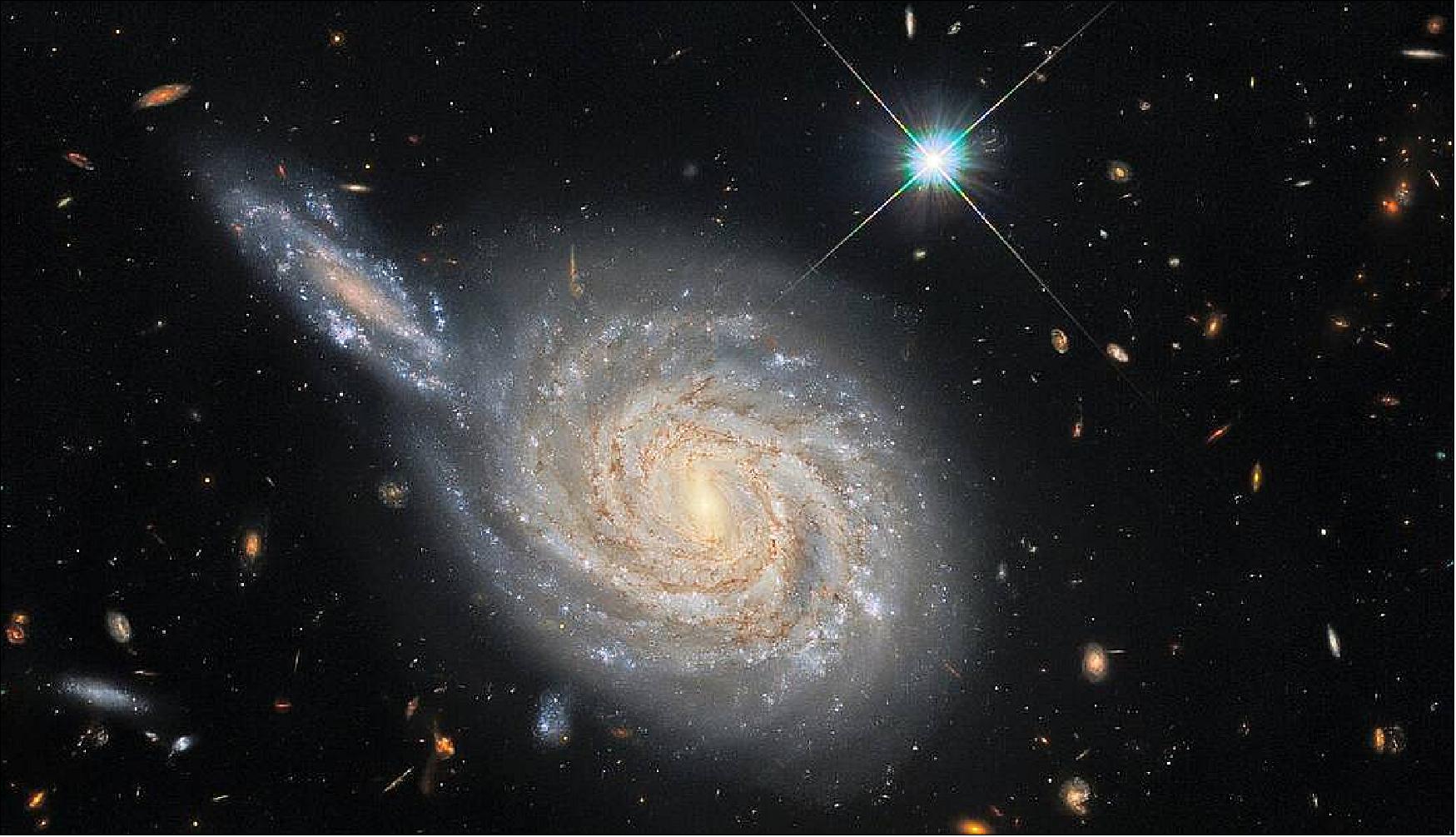
• On January 1, 2022, NASA’s Hubble Space Telescope officially passed the one-billion second mark. 91)
- Hubble was deployed from the Space Shuttle Discovery’s cargo bay on April 25, 1990, making it one-billion seconds (over 31 years) since Hubble began operating. For more than three decades, Hubble has provided us with groundbreaking scientific discoveries and iconic images of space.
- Hubble’s first one-billion seconds included five astronaut servicing missions to replace and repair components of the telescope, and more than 1.5 million scientific observations and counting! We can only imagine what discoveries the next one-billion seconds will bring as new telescopes like the recently launched James Webb Space Telescope and the future Nancy Grace Roman Space Telescope build upon Hubble’s discoveries and work together with Hubble to expand our understanding of the universe.
• December 17, 2021: This Hubble observation comes from a wealth of data gathered to pave the way for future science with the upcoming NASA/ESA/CSA James Webb Space Telescope. By combining ground-based observations with data from Hubble’s Advanced Camera for Surveys and Wide Field Camera 3, astronomers have built a treasure trove of data on the connections between young stars and the clouds of cold gas in which they form. One of Webb’s key science goals is to explore the life cycle of stars – particularly how and where stars are born. Since Webb observes at infrared wavelengths, it will be able to peer through the clouds of gas and dust in stellar nurseries and observe the fledgling stars within. Webb’s superb sensitivity will even allow astronomers to directly investigate faint protostellar cores – the earliest stages of star birth. 92)
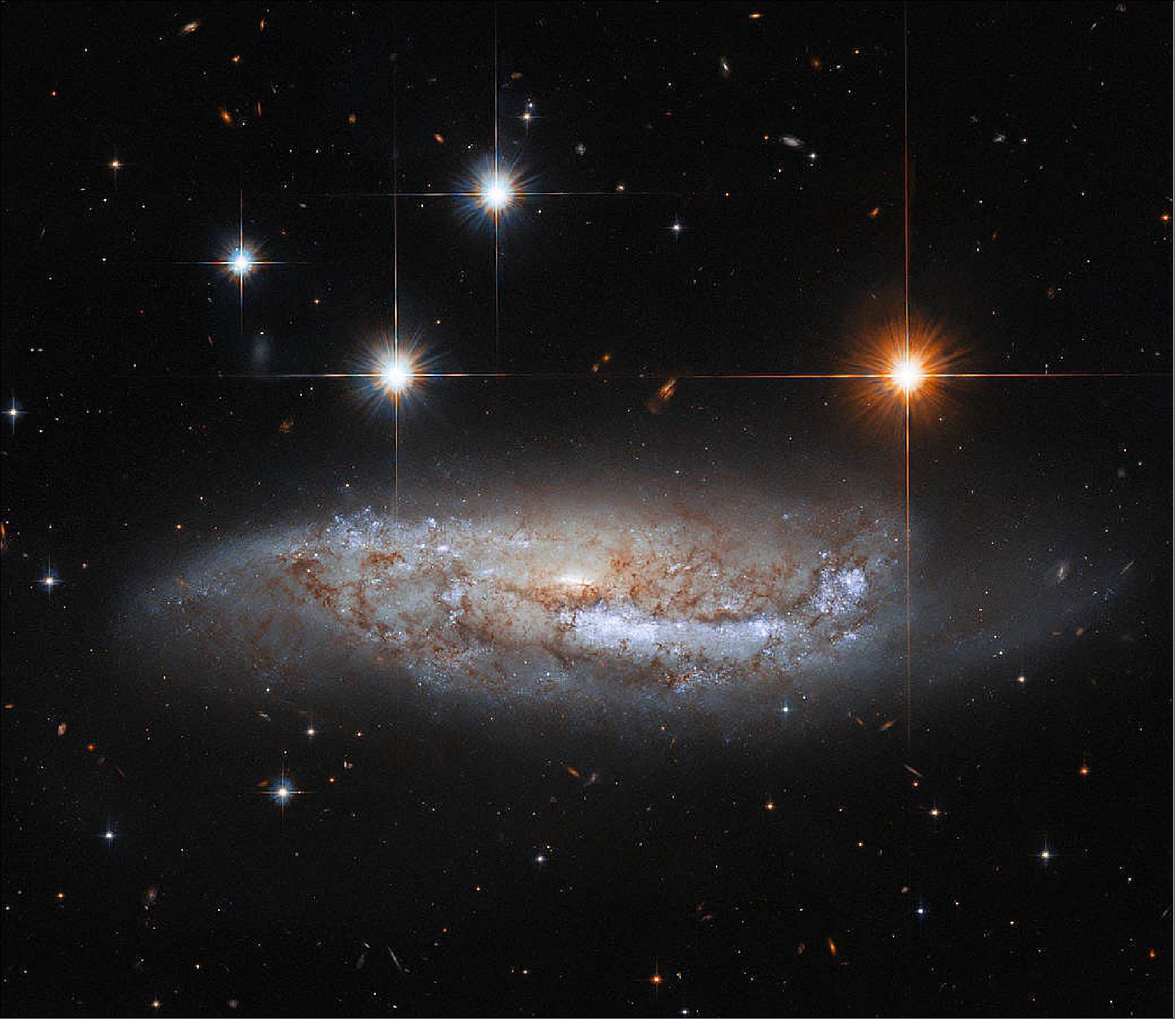
References
1) ”About the Hubble Space Telescope,” NASA URL: https://www.nasa.gov/mission_pages/hubble/story/index.html
2) ”Hubble's 30th Anniversary Celebration,” NASA Goddard Media Studios, 23 December 2020, URL: https://svs.gsfc.nasa.gov/13782
3) Gabriel Okolski , ”A Brief History of the Hubble Space Telescope,” NASA, April 2008, URL: https://history.nasa.gov/hubble/
4) “How the Hubble Space Telescope changed the cosmos,” Astronomy, URL: http://www.astronomy.com/bonus/hubble
5) ”Hubble Space Telescope sporting new solar arrays during SM3B,” NASA Press Release, 5 March 2020, Related announcements, ann2003, URL: https://www.spacetelescope.org/images/s109e5705/
6) ”ESA-Built Hardware on Hubble Reaches 1 Million Degree Slew Milestone,” Hubble Space Telescope, 5 March 2020, URL: https://www.spacetelescope.org/announcements/ann2003/
7) ”Europe & Hubble,” ESA, URL: https://www.spacetelescope.org/science/europe_hubble/
8) ”The Hubble Team,” NASA, URL: https://www.nasa.gov/mission_pages/hubble/team/index.html
9) Rob Garner, ”Hubble Space Telescope Science Instruments,” NASA, 12 December 2017, URL: https://www.nasa.gov/content/goddard/hubble-space-telescope-science-instruments
10) ”About the Hubble Space Telescope,” Hubblesite, URL: https://hubblesite.org/mission-and-telescope/the-telescope
11) John W. MacKenty, Randy A. Kimble, Robert W. O’Connell, Jacqueline A. Townsend, ”On-orbit performance of the HST Wide Field Camera 3,” Space Telescopes and Instrumentation 2010: Optical, Infrared, and Millimeter Wave,” edited by Jacobus M. Oschmann Jr., Mark C. Clampin, Howard A. MacEwen, Proceedings of SPIE, Vol. 7731, doi: 10.1117/12.857533, 10 February 2010, URL: https://archive.stsci.edu/prepds/wfc3ers/spie_mackenty_2010.pdf
12) ”Lens flair,” ESA Science & Exploration, 22 July 2022, URL: https://www.esa.int/ESA_Multimedia/Images/2022/07/Lens_flair
13) ”Portrait of a globular cluster,” ESA Science & Exploration, 15 July 2022, URL: https://www.esa.int/ESA_Multimedia/Images/2022/07/Portrait_of_a_globular_cluster
14) ”Hubble spies a galactic gem,” ESA Science & Exploration, 8 July 2022, URL: https://esahubble.org/images/potw2227a/
15) ”Delving into an astronomical treasure trove,” ESA Science & Exploration, 01 July 2022, URL: https://www.esa.int/About_Us/Week_in_images/Week_in_images_27_June_-_1_July_2022
16) ”Snapshot of a Massive Cluster,” ESA Science & Exploration, 23 June 2022, URL: https://www.esa.int/var/esa/storage/images/esa_multimedia/images/2022/06/snapshot_of_a_massive_cluster2/24327989-1-eng-GB/Snapshot_of_a_Massive_Cluster_pillars.jpg
17) ”Cosmic treasure chest,” ESA Science & Exploration, 17 June 2022, URL: https://www.esa.int/var/esa/storage/images/esa_multimedia/images/2022/06/cosmic_treasure_chest/24307855-1-eng-GB/Cosmic_treasure_chest_pillars.jpg
18) ”New Images Using Data From Retired Telescopes Reveal Hidden Features,” NASA Hubblesite News Release ID: 2022-027, 16 June 2022, URL: https://hubblesite.org/contents/news-releases/2022/news-2022-027.html
19) ”Dead Star Caught Ripping Up Planetary System,” Hubblesite News, 15 June 2022, URL: https://hubblesite.org/contents/news-releases/2022/news-2022-026.html
20) ”Dead Star Caught Ripping Up Planetary System,” NASA Feature, 15 June 2022, URL: https://www.nasa.gov/feature/goddard/2022/hubble-dead-star-caught-ripping-up-planetary-system
21) ”Hubble Determines Mass of Isolated Black Hole Roaming Our Milky Way,” ESA, heic2210 — Science Release, 10 June 2022, URL: https://esahubble.org/news/heic2210/?lang
22) ”Microlensing Black Hole,” ESA, heic2210b, 10 June 2022
23) ”Hubble investigates an enigmatic globular cluster,” ESA Science & Exploration, 10 June 2022, URL: https://www.esa.int/About_Us/Week_in_images/Week_in_images_06-10_June_2022
24) ”Hubble Helps Explain Why Uranus and Neptune Are Different Colours,” heic2209 — Science Release, 31 May 2022, URL: https://esahubble.org/news/heic2209/?lang
25) P.G.J. Irwin, N.A. Teanby, L.N. Fletcher, D. Toledo, G.S. Orton, M.H. Wong, M.T. Roman, S. Pérez-Hoyos, A. James, J. Dobinson,”Hazy blue worlds: A holistic aerosol model for Uranus and Neptune, including Dark Spots,” JGR Planets, Published: 23 May 2022, https://doi.org/10.1029/2022JE007189, URL: https://agupubs.onlinelibrary.wiley.com/doi/epdf/10.1029/2022JE007189
26) Claire Andreoli, ”Hubble Captures Pair of Star-Forming Spirals,” NASA Feature, 27 May 2022, URL: https://www.nasa.gov/image-feature/goddard/2022/hubble-captures-pair-of-star-forming-spirals
27) ”Hiding in Plain Sight,” ESA Science & Exploration, 26 May 2022, URL: https://www.esa.int/var/esa/storage/images/esa_multimedia/images/2022/05/hiding_in_plain_sight/24091192-1-eng-GB/Hiding_in_Plain_Sight_pillars.jpg
28) Claire Andreoli, ”Hubble Looks at a Face-On Grand Spiral,” NASA Feature, 26 May 2022, URL: https://www.nasa.gov/image-feature/goddard/2022/hubble-looks-at-a-face-on-grand-spiral
29) Claire Andreoli, ”Hubble Captures a Galactic Dance,” NASA Feature, 25 May 2022, URL: https://www.nasa.gov/image-feature/goddard/2022/hubble-captures-a-galactic-dance
30) Claire Andreoli, ”NGC 541 Fuels an Irregular Galaxy in New Hubble Image,” NASA Feature, 23 May 2022, URL: https://www.nasa.gov/image-feature/goddard/2022/ngc-541-fuels-an-irregular-galaxy-in-new-hubble-image
31) Claire Andreoli, ”Hubble Captures a Peculiar Pair,” NASA Feature, 20 May 2022, URL: https://www.nasa.gov/image-feature/goddard/2022/hubble-captures-a-peculiar-pair
32) ”Hubble spies a glittering gathering of stars,” ESA Science & Exploration, 20 May 2022, URL: https://esahubble.org/images/potw2220a/
33) Claire Andreoli, ”Hubble Focuses on a Large Lenticular,” NASA Feature, 19 May 2022, URL: https://www.nasa.gov/image-feature/goddard/2022/hubble-focuses-on-a-large-lenticular
34) ”Hubble Peers Through Giant Elliptical’s Layers,” NASA Feature, 18 May 2022, URL: https://www.nasa.gov/image-feature/goddard/2022/hubble-peers-through-giant-ellipticals-layers
35) Claire Andreoli, ”Hubble Reveals a River of Star Formation,” NASA Feature, 17 May 2022, URL: https://www.nasa.gov/image-feature/goddard/2002/hubble-reveals-a-river-of-star-formation
36) Claire Andreoli, Andrea Gianopoulos, ”Hubble Captures Giant Elliptical in the Head of the Serpent,” NASA Feature, 13 May 2022, URL: https://www.nasa.gov/image-feature/goddard/2002/hubble-captures-giant-elliptical-in-the-head-of-the-serpent
37) ”Aftermath of a cosmic cataclysm,” ESA Science & Exploration, 13 May 2022, URL: https://www.esa.int/ESA_Multimedia/Images/2022/05/Aftermath_of_a_cosmic_cataclysm
38) Claire Andreoli, ”A Small Sombrero for Hubble,” NASA Feature, 12 May 2022, URL: https://www.nasa.gov/image-feature/goddard/2022/a-small-sombrero-for-hubble
39) Claire Andreoli, ”Hubble Spies a Hidden Galaxy,” NASA Feature, 11 May 2022, URL: https://www.nasa.gov/image-feature/goddard/2022/hubble-spies-a-hidden-galaxy
40) ”Hubble Images a Dwarf Spiral with Multiple Mysteries,” NASA Feature, 10 May 2022, URL: https://www.nasa.gov/image-feature/goddard/2022/hubble-images-a-dwarf-spiral-with-multiple-mysteries
41) ”Global Citizen Science Project Finds Over 1700 Asteroid Trails in Hubble Images,” heic2207 — Photo Release, ESA, 6 May 2022, URL: https://esahubble.org/news/heic2207/?lang
42) ”Asteroid treasure in the Hubble archive,” MPE News, 06 May 2022, URL: https://www.mpe.mpg.de/7869022/news_publication_18603162_transferred?c=260780
43) Sandor Kruk, Pablo García Martín, Marcel Popescu, Bruno Merín, Max Mahlke, Benoît Carry, Ross Thomson, Samet Karada g, Javier Durán, Elena Racero, Fabrizio Giordano, Deborah Baines, Guido de Marchi, René Laureijs, ”Hubble Asteroid Hunter, I. Identifying asteroid trails in Hubble Space Telescope images,” Astronomy & Astrophysics manuscript no. Hubble_asteroid_hunter, 6 May 2022, URL: https://arxiv.org/pdf/2202.00246.pdf
44) ”Hubble Reveals Surviving Companion Star in Aftermath of Supernova,” NASA Hubblesite, 05 May 2022, Release ID: 2022-011, URL: https://hubblesite.org/contents/news-releases/2022/news-2022-011.html
45) Ori D. Fox, Schuyler D. Van Dyk, Benjamin F. Williams, Maria Drout, Emmanouil Zapartas, Nathan Smith, Dan Milisavljevic, Jennifer E. Andrews, K. Azalee Bostroem, Alexei V. Filippenko, Sebastian Gomez, Patrick L. Kelly, S. E. de Mink, Justin Pierel, Armin Rest, Stuart Ryder, Niharika Sravan, Lou Strolger, Qinan Wang, and Kathryn E. Weil, ”The Candidate Progenitor Companion Star of the Type Ib/c SN 2013ge,” The Astrophysical Journal Letters, Volume 929, Number 1, Published: 13 April 2022, https://stsynphot.readthedocs.io/en/latest/index.html, URL: https://iopscience.iop.org/article/10.3847/2041-8213/ac5890/pdf
46) ”Hubble sees double in M99,” ESA Science & Exploration, 02 May 2022, URL: https://esahubble.org/images/potw2218a/
47) ”Hubble spies a tenuous diffuse galaxy,” ESA Science & Exploration, 29 April 2022, URL: https://www.esa.int/About_Us/Week_in_images/Week_in_images_25-29_April_2022
48) ”Hubble observations used to answer key exoplanet questions,” ESA, Release No: heic2206, 25 April 2022, URL: https://esahubble.org/news/heic2206/?lang
49) ”Hubble inspects a set of galactic wings,” ESA Science & Exploration, 22 April 2022, URL: https://www.esa.int/About_Us/Week_in_images/Week_in_images_18-22_April_2022
50) ”Celebrating Hubble's 32nd Birthday with an Eclectic Galaxy Grouping,” NASA Hubblesite, 19 April 2022 Release ID: 2022-012, URL: https://hubblesite.org/contents/news-releases/2022/news-2022-012.html
51) ”Celebrating Hubble’s 32nd Birthday with a Galaxy Grouping,” heic2205 — Photo Release, 19 April 2022, URL: https://esahubble.org/news/heic2205/?lang
52) ”Spiral snapshot,” ESA Science & Exploration, 15 April 2022, URL: https://www.esa.int/About_Us/Week_in_images/Week_in_images_11-15_April_2022
53) ”Astronomers Detect Supermassive Black Hole Precursor Lurking in Archival Hubble Data,” heic2204 — Science Release, 13 April 2022, URL: https://esahubble.org/news/heic2204/?lang
54) S. Fujimoto, G. B. Brammer, D. Watson, G. E. Magdis, V. Kokorev, T. R. Greve, S. Toft, F. Walter, R. Valiante, M. Ginolfi, R. Schneider, F. Valentino, L. Colina, M. Vestergaard, R. Marques-Chaves, J. P. U. Fynbo, M. Krips, C. L. Steinhardt, I. Cortzen, F. Rizzo & P. A. Oesch, ”A dusty compact object bridging galaxies and quasars at cosmic dawn,” Nature, Vol. 604, pp:261-265, Published: 13 April 2022, https://doi.org/10.1038/s41586-022-04454-1
55) ”Hubble Confirms Largest Comet Nucleus Ever Seen,” NASA Feature, 12 April 2022, URL: https://www.nasa.gov/feature/goddard/2022/hubble-confirms-largest-comet-nucleus-ever-seen
56) ”Hubble confirms largest comet nucleus ever seen,” ESA Science & Exploration, 12 April 2022, URL: https://www.esa.int/ESA_Multimedia/Images/2022/04/Hubble_confirms_largest_comet_nucleus_ever_seen
57) Man-To Hui, David Jewitt, Liang-Liang Yu, and Max J. Mutchler, ”Hubble Space Telescope Detection of the Nucleus of Comet C/2014 UN271 (Bernardinelli–Bernstein),” The Astrophysical Journal Letters, Volume 929, Number 1, Published: 12 April 2022, https://doi.org/10.3847/2041-8213/ac626a, URL: https://iopscience.iop.org/article/10.3847/2041-8213/ac626a/pdf
58) ”Hubble spies a serpentine spiral galaxy,” ESA Science & Exploration, 8 April 2022, URL: https://www.esa.int/var/esa/storage/images/esa_multimedia/images/2022/04/hubble_spies_a_serpentine_spiral_galaxy/24015108-1-eng-GB/Hubble_spies_a_serpentine_spiral_galaxy_pillars.jpg
59) ”Hubble Probes Extreme Weather on Ultra-Hot Jupiters,” NASA Hubblesite, 6 April 2022, URL: https://hubblesite.org/contents/news-releases/2022/news-2022-014.html
60) Joshua D. Lothringer, David K. Sing, Zafar Rustamkulov, Hannah R. Wakeford, Kevin B. Stevenson, Nikolay Nikolov, Panayotis Lavvas, Jessica J. Spake & Autumn T. Winch, ”UV absorption by silicate cloud precursors in ultra-hot Jupiter WASP-178b,” Nature, Volume 604, pp: 49-52, Published: 06 April 2022, https://doi.org/10.1038/s41586-022-04453-2
61) Guangwei Fu, David K. Sing, Joshua D. Lothringer, Drake Deming, Jegug Ih, Eliza M. -R. Kempton, Matej Malik, Thaddeus D. Komacek, Megan Mansfield, and Jacob L. Bean, ”Strong H2O and CO Emission Features in the Spectrum of KELT-20b Driven by Stellar UV Irradiation,” The Astrophysical Journal Letters, Volume 925, Number 1, Published: 24 January 2022, https://doi.org/10.3847/2041-8213/ac4968, URL: https://iopscience.iop.org/article/10.3847/2041-8213/ac4968/pdf
62) ”Hubble Finds a Planet Forming in an Unconventional Way,” NASA Hubblesite, 04 April 2022, URL: https://hubblesite.org/contents/news-releases/2022/news-2022-016.html
63) ”Hubble finds a planet forming in an unconventional way,” ESA Science & Exploration, 04 April 2022, URL: https://www.esa.int/About_Us/Week_in_images/Week_in_images_4-8_April_2022
64) Thayne Currie, Kellen Lawson, Glenn Schneider, Wladimir Lyra, John Wisniewski, Carol Grady, Olivier Guyon, Motohide Tamura, Takayuki Kotani, Hajime Kawahara, Timothy Brandt, Taichi Uyama, Takayuki Muto, Ruobing Dong, Tomoyuki Kudo, Jun Hashimoto, Misato Fukagawa, Kevin Wagner, Julien Lozi, Jeffrey Chilcote, Taylor Tobin, Tyler Groff, Kimberly Ward-Duong, William Januszewski, Barnaby Norris, Peter Tuthill, Nienke van der Marel, Michael Sitko, Vincent Deo, Sebastien Vievard, Nemanja Jovanovic, Frantz Martinache & Nour Skaf, ”Images of embedded Jovian planet formation at a wide separation around AB Aurigae,” Nature Astronomy, Published: 04 April 2022, https://doi.org/10.1038/s41550-022-01634-x
65) ”More than meets the eye,” ESA Science & Exploration, 01 April 2022, URL: https://www.esa.int/About_Us/Week_in_images/Week_in_images_28_March_-_1_April_2022
66) Leah Ramsay, Ray Villard, ”Record Broken: Hubble Spots Farthest Star Ever Seen,” NASA Hubblesite, Release ID: 2022-003, 30 March 2022, URL: https://hubblesite.org/contents/news-releases/2022/news-2022-003.html
67) ”A Record Broken: Hubble Finds the Most Distant Star Ever Seen,” ESA Hubble, heic2203 — Science Release, 30 March 2022, URL: https://esahubble.org/news/heic2203/?lang
68) Brian Welch, Dan Coe, Jose M. Diego, Adi Zitrin, Erik Zackrisson, Paola Dimauro, Yolanda Jiménez-Teja, Patrick Kelly, Guillaume Mahler, Masamune Oguri, F. X. Timmes, Rogier Windhorst, Michael Florian, S. E. de Mink, Roberto J. Avila, Jay Anderson, Larry Bradley, Keren Sharon, Anton Vikaeus, Stephan McCandliss, Maruša Bradač, Jane Rigby, Brenda Frye, Sune Toft, Victoria Strait, Michele Trenti, Soniya Sharma, Felipe Andrade-Santos & Tom Broadhurst, ”A highly magnified star at redshift 6.2,” Nature, Vol. 603, pp: 815-818, Published: 30 March 2022, https://doi.org/10.1038/s41586-022-04449-y
69) ”Hubble spies a stunning spiral,” ESA Science & Exploration, 25 March 2022, URL: https://www.esa.int/About_Us/Week_in_images/Week_in_images_21_-_25_March_2022
70) ”Eye of the galaxy,” ESA Science & Exploration, 18 March 2022, URL: https://www.esa.int/About_Us/Week_in_images/Week_in_images_14_-_18_March_2022
71) ”Hubble’s Advanced Camera for Surveys celebrates 20 years of discovery,” ESA Science & Exploration, 7 March 2022, URL: https://www.esa.int/About_Us/Week_in_images/Week_in_images_7_-_11_March_2022
72) ”Not-so-close encounter,” ESA Science & Exploration, 4 March 2022, URL: https://www.esa.int/About_Us/Week_in_images/Week_in_images_28_February_-_4_March_2022
73) ”Hubble captures a peculiar galactic pair,” ESA Science & Exploration, 25 February 2022, URL: https://www.esa.int/About_Us/Week_in_images/Week_in_images_21_-_25_February_2022
74) Donna Weaver, ”Galaxy Collision Creates 'Space Triangle' in New Hubble Image,” NASA Hubblesite News, Release ID: 2022-010, 22 February 2022, URL: https://hubblesite.org/contents/news-releases/2022/news-2022-010.html
75) ”Tumultuous galactic trio,” ESA Science & Exploration, 18 February 2022, URL: https://www.esa.int/ESA_Multimedia/Images/2022/02/Tumultuous_galactic_trio
76) ”A cosmic draw,” ESA Science & Exploration, 11 February, 2022, URL: https://www.esa.int/ESA_Multimedia/Images/2022/02/A_cosmic_draw
77) ”Hubble revisits a galactic oddball,” ESA Science & Exploration, 4 February 2022, URL: https://www.esa.int/About_Us/Week_in_images/Week_in_images_31_January_-_4_February_2022
78) ”Puffy Planets Lose Atmospheres, Become Super-Earths,” NASA Hubblesite, 3 February 2022, URL: https://hubblesite.org/contents/news-releases/2022/news-2022-009.html
79) Michael Zhang, Heather A. Knutson, Lile Wang, Fei Dai, and Oscar Barragán, ”Escaping Helium from TOI 560.01, a Young Mini-Neptune,” The Astronomical Journal, Volume 163, Number 2, Published: 17 January 2022, https://doi.org/10.3847/1538-3881/ac3fa7, URL: https://iopscience.iop.org/article/10.3847/1538-3881/ac3fa7/pdf
80) Michael Zhang, Heather A. Knutson, Lile Wang, Fei Dai, Leonardo A. dos Santos, Luca Fossati, Gregory W. Henry, David Ehrenreich, Yann Alibert, Sergio Hoye9, Thomas G. Wilson, and Andrea Bonfanti, ”Detection of Ongoing Mass Loss from HD 63433c, a Young Mini-Neptune,” The Astronomical Journal, Volume 163, Number 2, Published: 17 January 2022, https://doi.org/10.3847/1538-3881/ac3f3b, URL: https://iopscience.iop.org/article/10.3847/1538-3881/ac3f3b/pdf
81) Claire Andreoli, ”Hubble Examines a Star-Forming Chamaeleon,” NASA Feature, 31 January 2022, URL: https://www.nasa.gov/image-feature/goddard/2022/hubble-examines-a-star-forming-chamaeleon
82) ”Strike!,” ESA Science & Exploration, 28 January 2022, URL: https://www.esa.int/About_Us/Week_in_images/Week_in_images_24_-_28_January_2022
83) ”Visualization Explores a Massive Star's Great Eruption,” NASA Hubblesite News Release, Release ID: 2022-004, 25 January 2022, URL: https://hubblesite.org/contents/news-releases/2022/news-2022-004.html
84) ”Sail of stars,” ESA Science & Exploration, 21 January 2022, URL: https://www.esa.int/About_Us/Week_in_images/Week_in_images_17_-_21_January_2022
85) ”Hubble Finds a Black Hole Igniting Star Formation in a Dwarf Galaxy,” NASA Hubblesite, 19 January 2022, URL: https://hubblesite.org/contents/news-releases/2022/news-2022-002.html
86) Zachary Schutte, Amy E. Reines, ”Black-hole-triggered star formation in the dwarf galaxy Henize 2-10,” Nature, Vol. 601, pp: 329-333, Published: 19 January 2022, https://doi.org/10.1038/s41586-021-04215-6
87) ”Galactic tranquility,” ESA Science & Exploration, 14 January 2022, URL: https://www.esa.int/About_Us/Week_in_images/Week_in_images_10_-_14_January_2022
88) ”1,000-Light-Year-Wide Bubble Surrounding Earth Is Source of All Nearby, Young Stars,” NASA Hubblesite Release ID: 2022-006, 12 January 2022, URL: https://hubblesite.org/contents/news-releases/2022/news-2022-006.html
89) Catherine Zucker, Alyssa A. Goodman, João Alves, Shmuel Bialy, Michael Foley, Joshua S. Speagle, Josefa Groβschedl, Douglas P. Finkbeiner, Andreas Burkert, Diana Khimey & Cameren Swiggum, ”Star formation near the Sun is driven by expansion of the Local Bubble,” Nature, Vol. 394, Published: 12 January 2022, https://doi.org/10.1038/s41586-021-04286-5
90) ”Hubble Sees Cosmic Clues in a Galactic Duo,” NASA Feature, 7 January, 2022, URL: https://www.nasa.gov/image-feature/goddard/2002/hubble-sees-cosmic-clues-in-a-galactic-duo
91) Claire Andreoli, ”Hubble Passes 1-Billion Second Mark,” NASA Feature, 5 January 2022, URL: https://www.nasa.gov/feature/goddard/2022/hubble-passes-1-billion-second-mark
92) ”Hubble Views a Galaxy With an Explosive Past,” NASA Feature, 17 December 2021, URL: https://www.nasa.gov/image-feature/goddard/2021/hubble-views-a-galaxy-with-an-explosive-past
The information compiled and edited in this article was provided by Herbert J. Kramer from his documentation of: ”Observation of the Earth and Its Environment: Survey of Missions and Sensors” (Springer Verlag) as well as many other sources after the publication of the 4th edition in 2002. - Comments and corrections to this article are always welcome for further updates (eoportal@symbios.space).